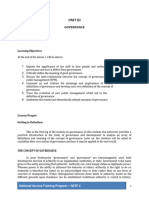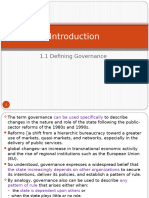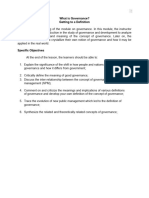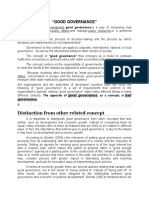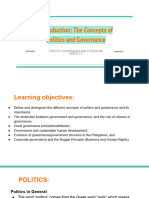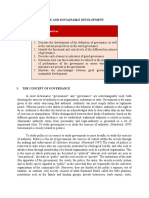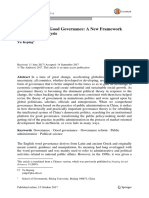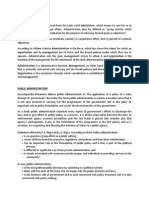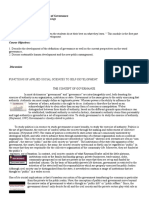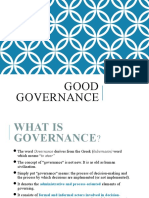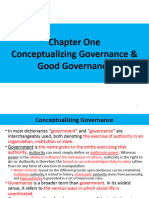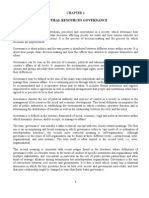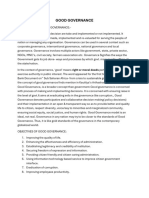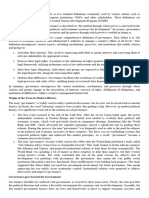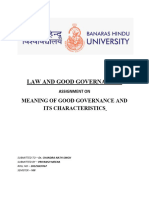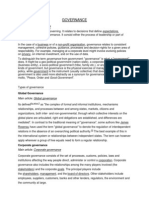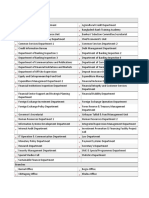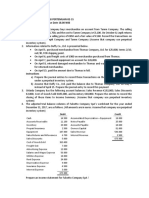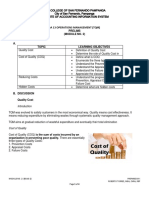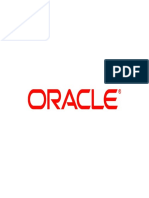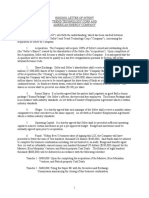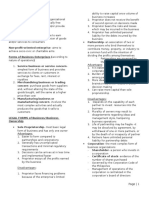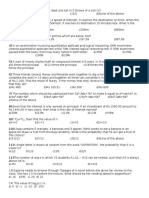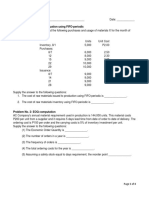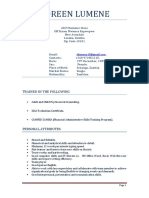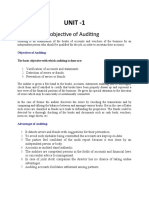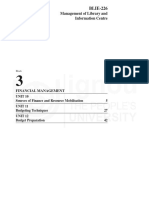Aspects of Governance 1 1685352554
Aspects of Governance 1 1685352554
Uploaded by
missdoodle913Copyright:
Available Formats
Aspects of Governance 1 1685352554
Aspects of Governance 1 1685352554
Uploaded by
missdoodle913Copyright
Available Formats
Share this document
Did you find this document useful?
Is this content inappropriate?
Copyright:
Available Formats
Aspects of Governance 1 1685352554
Aspects of Governance 1 1685352554
Uploaded by
missdoodle913Copyright:
Available Formats
ASPECTS OF GOVERNANCE-1
ASPECTS OF GOVERNANCE-1
The term governance has been derived from the Greek word ‘Kybernan’, which means to steer and
to pilot or be at the helm of things. Governance, in simple terms, means “the process of decision-
making and the process by which decisions are implemented”. The Concise Oxford Dictionary
defines it as an “act or manner of governing”. The concept of ‘governance’ is inextricably linked to
the concept of ‘government’. Some experts call the governance as ‘government in action’ or an
‘action part of the government’.
CONTEMPORARY MEANING OF THE GOVERNMENT
Government in the modern world means a machinery or an instrument of the state which wields
power of the state, it includes the Executive, the Legislature and the Judiciary. Government is a
political organization with the power to make and enforce laws and policies for a specific geographic
area and population. Its purpose is to regulate the behaviour of its citizens, provide public goods and
services, and represent the interests of the community it governs.
The terms government and governance are sometimes used interchangeably. However the concept
of governance is distinct from that of government. The involvement of institutions beyond the state
in management of public affairs separates ‘governance’ from the concept of government.
ORIGIN OF THE TERM ‘GOVERNANCE’
Harlan Cleveland used the word ‘governance’ for the first time in the mid-1970s as an alternative to
public administration. He was of the opinion that what people want is ‘less government and more
governance’. The term governance in recent times has assumed significance since 1989 with its
advocacy by the World Bank which reinvented it in a different context as a new approach to
development especially in the case of developing countries. It meant the exercise of political power
to manage nations’ affairs.
MEANING OF GOVERNANCE
The concept of governance can be understood from following definitions of governance given by
different organisations.
WORLD BANK
The world bank defines governance as “The manner in which power is exercised in the management
of a country’s economic and social resources by government. Governance, in general, has three
distinct aspects-
1. the form of a political regime (parliamentary or presidential, military or civilian, and
authoritarian or democratic);
2. the processes by which authority is exercised in the management of a country’s economic and
social resources; and
3. the capacity of governments to design, formulate, and implement policies, and, in general, to
discharge governmental functions. The terms usually describe conditions in a country as a
whole” .
ORGANISATION FOR ECONOMIC CO-OPERATION AND DEVELOPMENT (OECD)
The OECD defines governance as “the use of political authority and exercise of control in a society in
relation to the management of its resources for social and economic development”. The OECD lays
down the key components of governance as follows:
● Legitimacy of government;
● Accountability of political and official elements of government;
● Competence of governments to make policy and deliver services; and
For More Study Material, Visit: studyiq.com Page no.
1
ASPECTS OF GOVERNANCE-1
● Respect for human rights and the rule of law.
UNITED NATIONS DEVELOPMENT PROGRAMME (UNDP)
The UNDP defines governance as “The exercise of economic, political and administrative authority to
manage a nation’s affairs at all levels. It is the complex mechanisms, processes, and institutions
through which citizens and groups articulate their interests, exercise their legal rights and
obligations, and mediate their differences”.
PLANNING COMMISSION OF INDIA
Governance relates to the management of all such processes that, in any society, define the
environment which permits and enables individuals to raise their capability levels, on one hand, and
provide opportunities to realise their potential and enlarge the set of available choices, on the other.
There are two broad elements that form a definition of the term governance. They are-
1. Exercise of power and authority
● Process and institutions by which the authority in a country is exercised, how
governments are selected, held accountable, monitored, and replaced
● A system of values, policies and institutions by which a society manages its economic,
political and social affairs through interactions within and among the state, civil society
and private sector
● The space where the state as well as economic and social actors interact to make
decisions
● The process whereby elements in society wield power and authority, and influence and
enact policies and decisions concerning public life, and economic and social development
2. Government’s ability and capacity to effectively fulfil its mandate
● The capacity of governments to manage resources efficiently and to formulate,
implement, and enforce sound policies and regulations
● The government’s ability to serve the citizens by providing speedy justice, education,
health care and sanitation, social and physical infrastructure, law and order, and so on.
ENTITIES IN THE PROCESS OF GOVERNANCE
● Governance as a multi-actor paradigm: There are various entities involved in the process of
governance. Apart from the formal government and its institutions, the other actors are the
Non-Government Organisations (NGOs), Civil Society, Research institutes, Financial institutions,
Lobbyists, Multinational Corporations, International institutions, Media, etc. All these
institutions play a vital role in decision making and also influence the process of decision making.
● Governance as a collective effort: Governance involves opening up the arena of 'government' to
multiple actors by mobilizing the collective efforts of government, private sector and the
community. For example, the Pulse Polio Programme, which aims to vaccinate every child
against polio. Though it is a government programme, it is implemented at all levels by both
public agencies and private clinics and hospitals in urban and rural areas and, at many places
with direct citizens' involvement. The aim of governance is to secure the maximum good of the
maximum number of people through not just government efforts, but also with the efforts of
private organisations and the community.
CONTEXTUAL MEANINGS
The concept of the governance is used in different contexts and it should be noted that the meaning
of governance depends on the context in which it is being used. Different contextual explanations of
the term governance are as follows:
For More Study Material, Visit: studyiq.com Page no.
2
ASPECTS OF GOVERNANCE-1
● Governance as the Minimal State: In this sense, governance redefines the boundaries and form
of the public intervention. The governance in this context imparts a major role to the private
sector in delivering services to the citizens. The role of the government is redefined to be an
enabler or a facilitator rather than an all-encompassing entity. The size of the government is
reduced due to greater thrust on privatisation.
● Governance as Corporate governance: In this context, the governance refers to the system by
which organisations are directed and controlled. The role of the governance is not only
concerned with running the business of the company but also with giving overall directions to
the enterprise, with overseeing and controlling the executive actions of management and
ensuring adequate accountability and regulatory framework.
● Governance as New Public Management: Governance in this context aims at making public
administration market-based, committed to three prime goals of Efficiency, Economy and
Effectiveness (3E’s).
● Governance as Social-Cybernetics System:
● Governance in this context is the pattern or structure that emerges in a socio-political system as
a ‘common’ result or outcome of the interacting intervention efforts of all involved actors. This
pattern cannot be reduced to one actor or group of actors in particular.
● The policy outcomes are not the product of actions by the central government. The government
may pass a law but subsequently it interacts with local government, health authorities, the
voluntary sector, the private sector and, in turn, they interact with one another.
● The socio-cybernetic approach views governance as the result of interactive social- political
forms of governing. The approach highlights the limits to governing by a central actor and claims
there is no longer a single sovereign authority. Rather, there is a multiplicity of actors specific to
each policy area. An interdependence among these social-political-administrative actors
blurred boundaries between public, private and voluntary sectors.
● Governance as Self-Organising networks: Governance in this context is equated with services
provided by a combination of government, the private sector and the voluntary agencies. This
model is driven by networks and collaborative government rather than hierarchies. It lays stress
on horizontal linkages among the three actors i.e., the State, market and civil society. Networks
are a widespread form of social coordination and managing interorganizational links and are just
as important for public as well as private sector management.
A report on human development in South Asia, 1999 visualises three dimensions of governance
which brings about human development. These dimensions are-
● Political Governance: The characteristics of political governance are as follows-
o Regular, free and fair elections, with participation in the form of multi-party democracy
o An impartial judiciary protected by constitutional separation of powers
o A constitution not easily amendable by any of the branches of government
o Accountability of elected representatives and public officials
o Full access of all citizens to justice that is prompt and affordable
o Elimination of all forms of discrimination against women and minorities
o Maintenance of peace and social cohesion within and between states
● Economic Governance: It seeks equitable outcome to the economic processes. The government
must choose those economic policies which would foster competition and would be most
For More Study Material, Visit: studyiq.com Page no.
3
ASPECTS OF GOVERNANCE-1
beneficial to the poorest sections of the society. The characteristics of economic governance are
as follows-
o Macroeconomic stability characterised by balanced budget, low inflation, and stable
exchange rate with the help of an independent central bank
o Guaranteed property rights for the people
o Progressive taxes and subsidies
o Sufficient budgetary allocation to social priority areas, such as basic education, primary
healthcare, safe drinking water, adequate nutrition, family planning services, and micro-
credit schemes for the poor
o Adequate job creation
o Efficient and well-targeted subsidies for the poor sections
o Equitable access to credit and land
● Civil Governance: At the core of the civil governance is the determination and self-initiation of
people to improve their capacity to govern their lives, by creating informal structure and
processes to address the following basic concerns-
o Protecting basic human rights, particularly the rights of the disadvantaged sections of the
society
o Securing fundamental, political, economic and human rights for all.
From the above explanations, it is clear that the concept of governance is very dynamic and evolving
in nature. It implies the following-
o Taking care of functioning of the state for the well-being of citizens
o Securing the citizens the fundamental rights guaranteed in the constitution
o Enrich and improve political, social and economic life of all the citizens
o Institutionalising the system of governance
ASPECTS OF GOVERNANCE
From the previous discussion, it is clear that governance is a multi-faceted and dynamic concept
which gets its meaning from the context in which it is used. As discussed earlier, Governance refers
to the processes, systems and structures that influence decision-making and administration within a
society, organization or community. It encompasses all the mechanisms through which power and
authority are exercised, from political and legal institutions to the role of citizens and stakeholders.
Effective governance is critical to ensuring accountability, transparency, and the delivery of essential
services to citizens. It also plays a crucial role in promoting economic growth, reducing poverty, and
protecting human rights.
The important aspects of the governance include good governance, accountability, transparency,
Citizen-centric governance, Citizen Charters, Grievance redressal mechanisms, Role of Media in the
process of governance, Role of Citizens in the process of governance, and e-governance. These
aspects are discussed in detail in the following sections.
GOOD GOVERNANCE
Thoughts of Kautilya: The concept of good governance is not new to Indian civilization. Kautilya, in
his famous treatise ‘Arthashastra’ mentions the most important trait of the ruler as “in the
happiness of his subjects lies his happiness, in their welfare his welfare, whatever pleases himself, he
does not consider as good, but whatever pleases his subjects he considers as good”. This thought
essentially signifies the importance of welfare of people in the scheme of governance.
Emergence of Good Governance: Since ancient times the state has performed functions pertaining
to development, protection of sovereignty of the country and law and order. Gradually its functions
For More Study Material, Visit: studyiq.com Page no.
4
ASPECTS OF GOVERNANCE-1
started to increase and it became so enormous that it covered all aspects of the life of a citizen, it
thus became a leviathan. It got burdened with all these functions which only grew in intensity and
density with time. Thus, as a result the state was unable to perform all these tasks by itself. This
therefore resulted in neglect of several vital aspects of the governance. Some of the important
aspects of socio-economic development got ignored or overlooked. The administration worked from
the ivory tower which was inaccessible and unresponsive to the needs and requirements of the
people. Such a state of affairs called for immediate attention to governance reforms and in this
background emerged the concept of ‘Good Governance.
Thrust due to globalisation: As the roots of globalisation started to deepen in the late 1980’s, the
international institutions began to draw attention towards certain crucial deficiencies in the
governance system of developing countries. These included, non-availability of information to the
people, lack of accountability, poor management of public sector and lack of appropriate legal
framework.
The concept of good governance has evolved over time and is rooted in the belief that the effective
and responsible management of public resources and decision-making is necessary for the
promotion of social, economic, and political development.
The concept of good governance first gained prominence in the late 1980s and 1990s when the
World Bank, the United Nations, and other international organizations emphasized its importance
for achieving sustainable development and reducing poverty. It has since become a key focus in
development initiatives and reforms, particularly in developing countries. Good governance is seen
as a crucial factor in addressing issues such as corruption, inequality, and human rights abuses, and
is considered an essential component for improving the well-being of citizens and promoting
sustainable economic growth.
WHAT IS THE ESSENCE OF USING ‘GOOD’ BEFORE THE TERM ‘GOVERNANCE’?
● The use of "good" before the term "governance" implies a set of desirable qualities or
characteristics that are considered essential for effective and responsible management of public
resources and decision-making.
● The essence of using "good" before governance is to emphasize that not all forms of governance
are equal, and that there is a distinction between governance that is effective, transparent,
accountable, and responsive to the needs of citizens, and governance that is corrupt, opaque, or
unresponsive to the public.
● By using "good" as a modifier, the concept of good governance emphasizes the importance of
high standards and best practices in governance, and serves as a benchmark for evaluating the
performance and effectiveness of existing governance systems.
● The use of "good" is therefore meant to highlight the key principles and characteristics that are
seen as necessary for effective and responsible governance.
Good governance is thus seen as a means of promoting accountability, transparency, and
participation in decision-making, and ensuring that the distribution of power and decision-making
authority is fair and equitable.
GOOD GOVERNANCE AS PER WORLD BANK
Good governance is an attempt to widen the scope of public administration by going beyond formal
government. In other words, it is a broad reform strategy to make the government more open,
responsive, accountable and democratic; regulate the private sector and strengthen the institutions
of civil society. It is the qualitative dimension of governance. It is a combination of the efficiency
concerns of public management and the accountability concerns of governance. It underlines the
basic features of good governance as -
For More Study Material, Visit: studyiq.com Page no.
5
ASPECTS OF GOVERNANCE-1
● Voice and accountability which includes civil liberties and political stability
● Effectiveness of the government, which includes the quality of policy making and public service
delivery
● The quality of the regulatory framework
● The rule of law which includes protection of property rights
● Independence of judiciary
● Curbs on corruption.
CHARACTERISTICS OF GOOD GOVERNANCE
According to the United Nations Economic and Social Commission for Asia and Pacific (UNESCAP),
Good governance has 8 major characteristics. It is participatory, consensus oriented, accountable,
transparent, responsive, effective and efficient, equitable and inclusive and follows the rule of law. It
assures that corruption is minimized, the views of minorities are taken into account and that the
voices of the most vulnerable in society are heard in decision-making. It is also responsive to the
present and future needs of society. These characteristics are explained below-
PARTICIPATION
• Participation by both men and women is a key cornerstone of good governance. Participation
could be either direct or through legitimate intermediate institutions or representatives.
• It is important to point out that representative democracy does not necessarily mean that the
concerns of the most vulnerable in society would be taken into consideration in decision making.
• Participation needs to be informed and organized. This means freedom of association and
expression on the one hand and an organized civil society on the other hand.
INITIATIVES IN INDIA
There are more than Fourteen Lakh women representatives in Panchayati Raj Institutions in India.
Provision of reservation of seats to scheduled castes and scheduled tribes in Lok Sabha and State
legislative assemblies has resulted in political empowerment of these vulnerable sections of the
society. ”MyGov.in”- the online platform by the Union government offers an opportunity for citizens
to register their opinions in relation to policies of the government. Pre-Legislative Consultation
Policy ensures that citizens register their voice on draft legislative proposals of the government.
RULE OF LAW
● Good governance requires fair legal frameworks that are enforced impartially.
● It also requires full protection of human rights, particularly those of minorities.
● Impartial enforcement of laws requires an independent judiciary and an impartial and
incorruptible police force.
INITIATIVES IN INDIA
Indian constitution under article 39A specifically makes a provision for equal justice and free legal
aid. The parliament passed the National Legal Services Authority Act (NALSA) to give effect to this
provision which ensures that vulnerable sections including the poor are not denied justice because
of their economic conditions. The ‘Basic Structure’ doctrine of the Supreme Court ensures that Rule
of Law prevails in letter and spirit.
TRANSPARENCY
● Transparency means that decisions taken and their enforcement are done in a manner that
follows rules and regulations.
● It also means that information is freely available and directly accessible to those who will be
affected by such decisions and their enforcement. It also means that enough information is
provided and that it is provided in easily understandable forms.
For More Study Material, Visit: studyiq.com Page no.
6
ASPECTS OF GOVERNANCE-1
INITIATIVES IN INDIA
The Right To Information Act, 2005 passed by the parliament acts as an enabler for dissemination of
information related to governmental activities. Voluntary disclosure of information by ministries and
departments about their activities ensures transparency in the working of the government. The
citizens can also access the information related to governmental activities in their mother tongue
which makes sure that matters of information are easily understood by a common man.
RESPONSIVENESS
● Good governance requires that institutions and processes try to serve all stakeholders within a
reasonable timeframe.
● Responsiveness from the government and its agencies helps in building the trust and confidence
of citizens in the process of governance.
INITIATIVES IN INDIA
Grievance Redressal Mechanisms both at the Union and state level ensures that the complaints of
citizens against non-performance of governmental agencies are resolved within a specific time-
frame. E.g. Chief Minister’s Helpline in Madhya Pradesh resolves complaints of citizens within seven
to thirty days. The initiative of citizen charters by government agencies ensures time-bound and
quality service delivery with the aim of satisfaction of beneficiaries. Twitter Seva platform is used by
different ministries at the Union level to resolve queries of citizens.
CONSENSUS-ORIENTED
● There are several actors and as many viewpoints in a given society. Good governance requires
mediation of the different interests in society to reach a broad consensus in society on what is in
the best interest of the whole community and how this can be achieved.
● It also requires a broad and long-term perspective on what is needed for sustainable human
development and how to achieve the goals of such development.
● This can only result from an understanding of the historical, cultural and social contexts of a
given society or community.
INITIATIVES IN INDIA
In Indian context, the legislatures at both the Union and State levels provide a platform for
discussion, deliberation and conflict resolution on key issues affecting the society in general. The
democratic setup in India has been instrumental in the development of civil society. The Non-
Governmental Organisations such as Self-Employed Women’s Association (SEWA), Centre for
Science and Environment, Pratham, Help Age India, etc., industrial associations such as Federation of
Indian Chambers of Commerce and Industry (FICCI), The Associated Chambers of Commerce and
Industry of India (ASSOCHAM), etc., pressure groups from different sections of the society interacts
with government and its agencies. Such interaction, in our democratic setup, has been instrumental
in influencing government policy and making it broad-based and inclusive.
EQUITY AND INCLUSIVENESS
● A society’s well-being depends on ensuring that all its members feel that they have a stake in it
and do not feel excluded from the mainstream of society.
● This requires all groups, but particularly the most vulnerable, to have opportunities to improve
or maintain their well-being.
INITIATIVES IN INDIA
The constitutional provision of reservation helps in socio-politico-economic empowerment of
vulnerable sections. The National Food Security Act, 2013 gives a statutory right to food to more
than ninety crore Indians. Various agricultural subsidies have helped our vulnerable farmers to
For More Study Material, Visit: studyiq.com Page no.
7
ASPECTS OF GOVERNANCE-1
effectively tackle agrarian distress. The prime slogan of the present government is “Sabka Saath,
Sabka Vikas, Sabka Vishwas” which showcases the principle values and attitude of equity and
inclusiveness of the government towards the process of governance.
EFFECTIVENESS AND EFFICIENCY
● Good governance means that processes and institutions produce results that meet the needs of
society while making the best use of resources at their disposal.
● The concept of efficiency in the context of good governance also covers the sustainable use of
natural resources and the protection of the environment.
INITIATIVE IN INDIA
The provision of social audit for the works completed under MGNREGA ensures not only an efficient
and effective use of resources but also the accountability of contractors. India’s ‘Panchamrit’
strategy which includes the target of achieving net-zero emissions by 2070, among other goals, to
contribute towards sustainable development is a step which would ensure efficient and effective use
of natural resources.
ACCOUNTABILITY
● Accountability is a key requirement of good governance. Not only governmental institutions but
also the private sector and civil society organizations must be accountable to the public and to
their institutional stakeholders.
● Who is accountable to whom varies depending on whether decisions or actions taken are
internal or external to an organization or institution.
● In general an organization or an institution is accountable to those who will be affected by its
decisions or actions.
● Accountability cannot be enforced without transparency and the rule of law.
● Periodic elections, independent and assertive judiciary, strong and predictable legal framework,
institutions such as Lokpal, Central Vigilance Commission, awareness among citizens about their
rights and duties etc. ensures accountability of all the key players – the State, the Market and
the Civil society- in the process of governance.
PILLARS OF GOOD GOVERNANCE
● Ethos (of service to the citizen),
● Ethics (honesty, integrity, accountability, and transparency),
● Equity (treating all citizens alike with empathy and compassion for the weaker sections), and
● Efficiency [speedy and effective delivery of service without harassment and using Information
and Communication Technology (ICT) increasingly]
The basic features of good governance as conceptualised by policy makers, researchers and
international agencies can be summarised in the word “SMART”, each letter of which is a
prerequisite of good governance. SMART stands for simple, moral, accountable, responsive and
transparent. In other words, it indicates the qualitative dimension of governance rather than
enhancing the quality of governance.
The good governance agenda advocates freedom of information, a strong legal system and efficient
administration to help the underprivileged sections’ claim to equality, but these have been most
successful when backed up by strong political mobilisation through social movements or political
parties with a clear-cut mission. Good governance means bringing about goodness in all the three
sectors: government, civil society and corporate world including transnational corporations. Good
governance is a tryst with trust, a commitment of the people, for the people, a social contract for
the greatest good, and the collective conscience of the community.
For More Study Material, Visit: studyiq.com Page no.
8
ASPECTS OF GOVERNANCE-1
ACCOUNTABILITY
MEANING OF ACCOUNTABILITY
Accountability is the quality or state of being accountable, responsible, or answerable for one's
actions, decisions, and policies. It means that individuals or organizations have a moral or legal
obligation to explain and justify their actions, and to accept the consequences if they fall short.
Accountability is often considered a key aspect of transparency and good governance.
In the context of governance, accountability refers to the responsibility and obligation of those in
positions of power to account for their actions and decisions to the public or to a higher authority.
This means that they must provide explanations and justifications for their behaviour, and be held
accountable for any wrongdoings or breaches of trust. It also means that they are answerable to the
people they serve, and that there is a system in place for them to be held accountable for their
actions. This helps to ensure that those in power act in a transparent, responsible and ethical
manner, and that there are consequences for any abuse of power.
Accountability as a relational concept: The obligation of power holders to be answerable for their
actions might stem out of a moral-ethical need to account for one’s behaviour, or out of a legal
requirement. It is a relational concept as it concerns the relationship between those who perform an
action or deliver a service, and those on whom the action or service has an effect. Actualising
accountability involves two critical aspects:
● First is determining who should be accountable to whom and for what, and
● Second is developing the institutional mechanisms and incentive-sanction structures on the
basis of which accountability is realised.
Elements in accountability: There are various elements that come together in the notion of
accountability, including
● Answerability: the need for justification of actions,
● Enforcement: the sanctions which could be imposed if the actions or justifications for the
actions are found to be unsatisfactory, and
● Responsiveness: the ability of those held accountable to respond to the demand made. More
importantly, accountability requires transparency so that actions can be scrutinised and
performance assessed.
Overall, accountability means that the power holders must provide explanations and justifications
for their behaviour, and be held accountable for any wrongdoings or breaches of trust. It also means
that they are answerable to the people they serve, and that there is a system in place for them to be
held accountable for their actions. This helps to ensure that those in power act in a transparent,
responsible and ethical manner, and that there are consequences for any abuse of power.
ACCOUNTABILITY OF POLITICAL EXECUTIVES
The council of ministers headed by the Prime Minister at the Union level and the council of ministers
headed by the Chief Minister at the state level forms the political executive. The political executive
at both the union and state level is the real executive having wide powers with respect to policy
formulation, legislations, schemes and programmes. Such wide powers without accountability would
result in rampant corruption and decay of democracy. So, it is important that our political executive
is accountable to the people of India for their actions.
INSTITUTIONAL MECHANISMS
PARLIAMENT
The parliament serves as the constitutional mechanism to exact accountability of the government in
power. It ensures accountability of the political executives in the following ways-
For More Study Material, Visit: studyiq.com Page no.
9
ASPECTS OF GOVERNANCE-1
COLLECTIVE RESPONSIBILITY:
The council of ministers headed by the prime minister is collectively responsible to the parliament in
general and the Lok Sabha in particular. The Lok Sabha can move a no-confidence motion against the
government for its failure to perform as per expectations of people. Such a mechanism keeps check
on arbitrary use of the power by those running the government. The similar mechanism of
collective responsibility of the executive is also present at the state level. However, the government
with a strong majority in the lower house of the parliament cannot be removed with the use of no-
confidence motion.
INDIVIDUAL RESPONSIBILITY:
The ministers hold their office in the pleasure of the president. The prime minister can ask for
resignation or recommend removal of a minister who has failed to perform their duties. Non-
performance on the part of ministers can result in their removal from their respective office. This
mechanism ensures responsible use of power and authority on the part of ministers.
PARLIAMENTARY QUESTIONS:
Question hour in both the houses of parliament is the mechanism through which representatives of
people can hold the political executive accountable for its actions. Question hour provides a
platform to members of parliament to inquire into the working of different ministries and
departments. The answerability and accountability of ministers is ensured when they are made to
respond to questions pertaining to their work.
Utility of question hour can be seen from following cases-
● Mundhra Scandal: The Mundhra Scandal had its origin in a question raised by the then
member of parliament Ram Subhag Singh. His question was based on a newspaper report that
was vague and in certain portions inaccurate. The then Finance Minister T.T. Krishnamachari
answered in a casual manner. Ram Subhag Singh thereafter collected information and raised
the matter further. The government was left with no choice but to come out with facts about
the purchase of shares by the Life Insurance Corporation. Changla commission was
appointed to enquire into the matter and finally T.T. Krishnamachari had to resign.
● Commonwealth Games Scandal: The question regarding queen baton relay was raised in the
question hour of the Lok Sabha. Subsequently, it led to suspension of T. S. Darbari, Joint
Director of commonwealth games organising committee and Anil Khanna, Treasurer of
commonwealth games organising committee.
PARLIAMENTARY DISCUSSIONS:
Various parliamentary devices such as questions, debates, discussions, motions, resolutions, etc. are
tools to ensure accountability of the ministers. Legislative discussions on matters of public
importance are raised in the parliament through adjournment motion, motion of thanks, calling
attention motion, short duration discussion, etc. Such discussions have proved their utility in
exacting accountability of the political as well as administrative executive. For instance, during the
discussion of the president’s address in 1959, some allegations were made against M. O. Mathai,
special assistant to the Prime Minister, and ultimately the officer had to resign. In 1962, a notice of
no-confidence motion led to the resignation of the then Defence Minister V. K. Krishna Menon who
was considered responsible for the debacle in the Indo-China conflict.
Discussions on financial matters including general budget, cut motions, supplementary grants, etc.
bring all sorts of administrative matters for the review and scrutiny of the parliament. This financial
examination of ministerial activities, highlighted during debates on finance and appropriation bills,
enables the house to curb and control wastefulness of resources. Discussions on demand for grants
also to some extent act as a mechanism to ensure financial accountability of the political executive.
For More Study Material, Visit: studyiq.com Page no.
10
ASPECTS OF GOVERNANCE-1
PARLIAMENTARY COMMITTEES:
Parliament regulates government expenditure to ensure that public finances are used efficiently.
Such financial oversight is a complex and technical task. Financial committees facilitate this task for
Parliament. Financial committees such as the Public Accounts Committee, Estimates Committee, and
Public Undertakings committee are instrumental in examining performance of the government and
its agencies on the financial front. These committees serve as a tool of ensuring financial
accountability of the executive to the people of India in general and the parliament in particular.
Effectiveness of these committees can be seen from following cases-
PAC REPORT ON THE COMMONWEALTH GAMES, 2010
India hosted the 19th Commonwealth Games in 2010. CAG had submitted an audit report on the
Games after its completion. The PAC examined the CAG report, and submitted a report in 2016-
17. The Committee noted that: (a) crucial delays were involved in the planning process, (b)
Chairman of the organisation committee was appointed in an opaque manner, and (c) corrupt
practices were followed in awarding several contracts.
IMPORT OF URANIUM
The Committee on Estimates examined the subject ‘Import of Uranium for Nuclear Plants’ for
three years between 2014 and 2018. One of the main observations of the Committee was that the
majority of domestic production of uranium comes from mines in Jharkhand. High extraction cost
involved in mining makes it unviable as compared to imported uranium. It noted that the
dependence on imported uranium will reduce if domestic production is increased and new mines
are developed. The Committee recommended that adequate financial allocation should be
provided such that new mines can be opened to increase domestic production of uranium.
Such reports of the committee not only serves as a tool of examining performance of the
government and its agencies but also makes pathways for exacting the accountability of the political
executives. Once these reports are made public, the media, social media, public activists and other
stakeholders may demand more information and in a way make the government and its agencies
accountable for their actions.
Department Related Standing Committees examine the demand for grants made by ministries. They
also examine the legislative proposals and issues related to ministries. The reports of these
committees disseminate valuable information regarding lacunas in performance of various
ministries. Such dissemination of information ensures transparency which is a prerequisite for
accountability. Utility of these committees can be seen from following cases-
WAIVING OFF RAILWAYS’ DIVIDEND PAYMENT
Indian Railways used to pay a return on the budgetary support it received from the government
every year, known as dividend. The rate of this dividend was determined by the Railways
Convention Committee, and was about 5% in 2016-17. In 2015, the Standing Committee on
Railways had observed that the system of receiving support from the government and then paying
back dividends was counter-productive. It recommended that the payment of dividend can be
avoided till the financial health of Railways improves. In September 2016, the requirement to pay
dividends to the central government was removed.
COMPTROLLER AND AUDITOR GENERAL
Dr. B. R. Ambedkar in the Constituent Assembly said that, “I am of the opinion that this dignitary or
officer is probably the most important officer in the Constitution of India. He is the one man who is
For More Study Material, Visit: studyiq.com Page no.
11
ASPECTS OF GOVERNANCE-1
going to see that the expenses voted by Parliament are not exceeded, or varied, from what has been
laid down by Parliament.” This thought reflects the importance of CAG in ensuring financial
accountability of the government.
Accountability and transparency are twins that help blossom and sustain our democratic progress.
Lack of these breeds corruption and inefficiency. CAG has a massive role to root out this menace.
Audit is a powerful and inescapable tool of good governance. Absence of audit or inefficient audit is
the surest passage to system degeneration. This underlines imperatives of CAG focus. By discerning
errors and highlighting wastefulness and extravagance in public spending, the CAG not only ensures
that the government delivers its promise with economic efficiency, but also it helps to stamp out
inefficiency and corruption.
The Comptroller and Auditor General (CAG) of India is an independent constitutional authority
responsible for ensuring accountability and transparency in the financial management of the
government. It performs the following functions to ensure accountability:
● Audit of Accounts: The CAG performs regular and comprehensive audits of the government's
financial transactions and accounts to ensure that they are in compliance with laws and
regulations. This helps to identify any financial irregularities or mismanagement of funds.
● Examining public spending: CAG examines how public funds are being spent by various
government departments and entities, including public sector undertakings and autonomous
bodies, to ensure that they are being used for the intended purposes and that there is no
mismanagement of funds.
● Performance Audit: The CAG also conducts performance audits, which assess the efficiency,
effectiveness, and economy of government programs and policies. This helps to identify areas
where improvements can be made and ensure that public resources are being used effectively.
● Inspection of Records: The CAG has the power to inspect any records, books, and documents of
the government to ensure that they are in order and that financial transactions are being carried
out in accordance with the law.
● Reporting to Parliament: CAG reports its findings and recommendations to the Parliament,
which helps to ensure that the government is held accountable for its actions. The CAG's reports
are widely followed by the media, public, and other stakeholders, and can lead to significant
policy changes.
Following are certain findings by the CAG which were instrumental in ensuring accountability of the
political executive-
ALLOCATION 2G SPECTRUM CASE:
Highlighting gross irregularities in the allocation of 2G spectrum in 2008, the CAG said that the
entire process lacked transparency and was undertaken in an arbitrary, unfair and inequitable
manner causing a presumptive loss of more than 1.76 lakh crore rupees to the public exchequer.
The CAG’s performance audit report titled “issue of licenses and allocation of 2G spectrum by the
Department of Telecommunication (DoT)” said that the DoT issued 122 new licenses for 2G
spectrum in 2008 at 2001 prices by flouting every canon of financial propriety, rules and
procedures.
Overall, the role of the CAG is to help ensure that the government is using public funds in a
responsible and accountable manner. By performing independent audits and reporting its findings,
the CAG helps to maintain transparency and accountability in government operations.
For More Study Material, Visit: studyiq.com Page no.
12
ASPECTS OF GOVERNANCE-1
JUDICIARY
In India, the judiciary plays a critical role in ensuring accountability of the government. The judiciary
is the final arbiter of disputes between individuals, between the government and individuals, and
between different branches of the government. The judiciary in India has the power to review and
strike down legislation and executive actions that it finds to be unconstitutional or in violation of
fundamental rights. This helps ensure that the government is held accountable to the Constitution
and to the citizens of India.
The judiciary plays a crucial role in ensuring accountability of the government by serving as an
independent check on the power of the executive and legislative branches. The judiciary is
responsible for interpreting the Constitution and ensuring that the government operates within its
bounds. Some of the ways in which the judiciary helps ensure accountability are as follows:
● Judicial Review: The judiciary has the power of judicial review, which allows it to examine the
constitutionality of laws and government actions. If a law or government action is found to be
unconstitutional, the judiciary can strike it down, thereby helping to ensure that the government
operates within the bounds of the Constitution.
o In a significant judgement delivered in the I.R. Coelho case (2007), the Supreme Court ruled
that there could not be any blanket immunity from judicial review of laws included in the
Ninth Schedule. In this case, the court held that judicial review is a ‘basic feature’ of the
constitution and it could not be taken away by adding a law under the Ninth Schedule. The
Supreme Court held that the laws placed under the Ninth Schedule after April 24, 1973, are
open to challenge in court if they violated Fundamental Rights guaranteed under Articles 14,
15, 19 and 21 or the ‘basic structure’ of the Constitution.
● Powers of Writs: The judiciary also has the power to issue writs, such as habeas corpus,
mandamus, prohibition, and certiorari, to protect the rights of citizens and enforce the rule of
law. Using these writs the Supreme court under article 32 and High courts under article 226 can
quash arbitrary executive actions which violate the fundamental rights guaranteed to citizens.
● Review of Administrative Decisions: The judiciary can review administrative decisions and hold
the government accountable for its actions. If a government action is found to be arbitrary,
unreasonable, or in violation of the law, the judiciary can set it aside, ensuring that the
government acts in a responsible and accountable manner. Our higher judiciary is equipped with
the power of ‘Due process of law’. Using this power the judiciary can nullify administrative
decisions which go against the spirit of the constitution.
● Public Interest Litigation: The judiciary also has the power to entertain public interest litigations,
which are legal actions brought by individuals or organizations seeking to protect the public
interest. These litigations help to ensure that the government operates in a transparent and
accountable manner and that the rights of citizens are protected.
o Hussainara Khatoon vs. State of Bihar (1979): The first reported case of PIL was Hussainara
Khatoon vs. State of Bihar (1979) which focused on the inhuman conditions of prisons and
under-trial prisoners that led to the release of more than 40,000 under-trial prisoners. Right
to speedy justice emerged as a basic fundamental right which had been denied to these
prisoners. The same set pattern was adopted in subsequent cases.
o S.P. Gupta vs. Union of India (1982): A new era of the PIL movement was heralded by Justice
P. N. Bhagwati in the case of S.P. Gupta vs. Union of India. In this case, it was held that “any
member of the public or social action group acting bonafide” can invoke the Writ Jurisdiction
of the High Courts (under Article 226) or the Supreme Court (under Article 32) seeking
redressal against violation of legal or constitutional rights of persons who due to social or
economic or any other disability cannot approach the Court. This judgment made the Public
Interest Litigation a potent weapon for the enforcement of “public duties” where executive
action or misdeed resulted in public injury. As a result, any citizen of India or any consumer
For More Study Material, Visit: studyiq.com Page no.
13
ASPECTS OF GOVERNANCE-1
group or social action group can now approach the apex court of the country seeking legal
remedies in all cases where the interests of the general public or a section of the public are
at stake.
The higher judiciary using the constitutional powers of judicial review ensure that the political
executive do not cross the constitutional boundaries. Arbitrariness and authoritarian tendencies
among those in powerful positions is checked and arrested, before it erodes norms of good
governance, by the higher judiciary using the novel ‘Basic Structure’ doctrine. Independent judiciary
in India has successfully ensured accountability of the political executive using the powers bestowed
upon it by the constitution.
The judiciary plays a crucial role in ensuring accountability in the Indian government by serving as an
independent check on the power of the executive and legislative branches and by protecting the
rights of citizens and ensuring that the government operates within the bounds of the Constitution.
LOKPAL
The Lokpal is an anti-corruption ombudsman in India The Lokpal is an anti-corruption ombudsman in
India, established under the Lokpal and Lokayuktas Act of 2013, whose main function is to ensure
accountability in the government by investigating and prosecuting cases of corruption. The Lokpal
acts as a watchdog over the actions of public servants, including elected officials and bureaucrats, to
ensure that they are using their power and resources for the public good and not for personal gain.
The Lokpal and Lokayuktas Act, 2013 provided for Lokpal at the centre having jurisdiction of trying
cases of corruption against all Members of Parliament and central government employees. The
Lokayuktas have functions similar to the Lokpal, but they function on a state level. The office of the
Lokpal and Lokayuktas deals with charges of corruption against any public official and includes the
office of the prime minister of the court but with reasonable safeguards. Both the Lokpal and the
Lokayukta deal with charges of corruption against the government and its employees, in fact they
even conduct investigations and based on the findings from such investigations they conduct trials.
The jurisdiction of the Lokpal will include the Prime Minister except on allegations of corruption
relating to international relations, security, the public order, atomic energy and space and unless a
Full Bench of the Lokpal and at least two-thirds of members approve an inquiry.
It ensures accountability of executive through several key functions:
● Receiving and investigating complaints: The Lokpal receives complaints of corruption from the
public, including anonymous complaints, and investigates them to determine whether there has
been any wrongdoing.
● Prosecuting corrupt officials: The Lokpal has the power to prosecute public servants and others
accused of corruption, and to recommend the initiation of criminal proceedings against them.
● Imposing penalties: The Lokpal can impose penalties on those found guilty of corruption,
including fines and imprisonment.
● Recommending policy changes: The Lokpal can make recommendations for policy changes to
the government to help prevent corruption and improve accountability.
● Building public awareness: The Lokpal can play a role in raising public awareness about
corruption and the importance of accountability, and can engage with various stakeholders to
help promote these values.
The institution of Lokpal has been a landmark move in the history of Indian polity, The Lokpal and
Lokayukta act 2013 has offered a productive solution to combat the never ending menace of
corruption and ensure accountability of higher functionaries in the government including the Prime
Minister.
For More Study Material, Visit: studyiq.com Page no.
14
ASPECTS OF GOVERNANCE-1
Other institutions such as the Central Bureau of Investigation also have powers to prosecute cases of
corruption against ministers. But the CBI’s role in ensuring accountability of the political executive is
often questioned as it operates under the control of the political executive itself and lacks
independence. In this context, the Supreme court even called the CBI as a “caged parrot” who acts
as per directions of the centre and lacks the required autonomy.
LIMITATIONS OF INSTITUTIONAL MECHANISMS
LIMITATIONS OF PARLIAMENT AND ITS COMMITTEES
● Body of layman: Parliamentarians are not experts when it comes to the functioning of the
government and its agencies. Due to lack of expertise and secretarial assistance, issues raised by
the parliamentarians in the parliament are often general in nature which limits their ability to
make the government accountable for its actions.
● Increased criminalisation: The report of Association for Democratic Reforms (ADR) mentions
that 43 percent of members of the seventeenth Lok Sabha have criminal antecedents. The trend
of criminalisation has been increasing both at the union and state levels in recent times. The
criminalisation of politics and politicisation of criminals not only threatens the democratic fabric
of the country but also goes against the principles of good governance. If law breakers become
law makers, it becomes very difficult to expect them to make the government accountable for its
actions.
● Executive dominance: The executive branch of government has a great deal of power and
influence over the parliament. This can limit the ability of parliament to hold the government
accountable, as the executive may be able to resist or block efforts to scrutinize its actions. The
ruling parties often command a healthy majority in the parliament and it leads to ineffectiveness
of the parliament in making the government answerable. As parliamentarians belonging to the
ruling party strictly follow political directions given to them by the party whip. This has been one
of the primary reasons for decline of quality of debates and discussions in the parliament.
Debates, discussions and deliberations on important national issues often get embroiled in
personal attacks emanating from petty politics. In such an environment the effectiveness of
parliamentarians to exact accountability of the executive is seriously questioned.
● Political polarization: Political polarization can limit the ability of parliament to effectively hold
the government accountable. When political parties are deeply divided, it can be difficult for
parliament to reach a consensus on important issues and hold the government accountable.
● Limited powers of inquiry: In some cases, parliament may not have the legal powers to conduct
inquiries into the actions of the government. The government under the garb of national
security often withholds or purposefully delays sharing important information to the parliament.
This can limit the ability of the parliament to hold the government accountable and uncover
information about its actions.
● Limited time for discussions: The Parliament only sits for a limited number of days in a year and
its members are busy with other responsibilities. This makes it difficult for them to keep a
constant watch on the government's actions. The Parliament has limited time for discussions
and debates. Average time of the sessions of parliament has declined since independence. This
limited time is also wasted sometimes when members resort to ruckus and disruption in the
house. Disruption, sloganeering, and violation of decorum of the house is becoming the norm in
the parliament. Such norms are making it difficult for members to hold the government
accountable for its actions.
● Bureaucratic delays: Bureaucratic delays often result in the parliament not being able to hold
the government accountable in a timely manner.
● Inadequate powers of committees: The parliamentary committees, which are supposed to
scrutinize the functioning of the government, often do not have enough powers to carry out
their duties effectively. The committees mostly do the post-mortem work i.e. their work takes
For More Study Material, Visit: studyiq.com Page no.
15
ASPECTS OF GOVERNANCE-1
place after the government or its agencies have committed wrongs. For instance the Public
Accounts Committee, which is considered the most powerful parliamentary committee,
examines legality of expenditure only after it takes place and does not have any powers of
preventing any economic misdoings from the government. The minutes of the meetings of
committees are seldom made public. The members of committees often follow narrow political
lines which defeats the purpose of holding the government accountable.
● Lack of Opposition unity: The opposition parties in the parliament often fail to come together
on important issues, resulting in a lack of effective opposition and accountability.
● Lack of Public Awareness: The general public is often unaware of the functioning of the
Parliament and the role it plays in holding the government accountable. This results in a lack of
public pressure on the Parliament to perform its duties.
● Lack of Information: The Parliament often lacks the required information to hold the
government accountable. The government is not obligated to provide complete information to
the Parliament and can often withhold information on the grounds of national security.
● Lack of transparency: Lack of transparency in government operations and decision-making
processes makes it difficult for Parliament to hold the government accountable. The minutes of
cabinet meetings are never made public and the ministers are bound by the oath of secrecy.
LIMITATIONS OF CAG
● Political influence: The CAG is not immune to political influence, as the appointment of the CAG
is done by the President on the advice of the Prime Minister. This raises concerns about the
independence of the institution, and the possibility of political influence affecting the audits
conducted by the CAG.
● Lack of enforcement powers: The CAG can only conduct audits and submit reports to the
Parliament or state legislatures, but it does not have any enforcement powers to implement its
recommendations or to recover the amounts identified as irregular or wasteful expenditure. This
limits the impact of the CAG's audits and makes it difficult for the institution to enforce
accountability in the government.
● Time lag: The time lag between the completion of an audit and the submission of the report to
the Parliament or state legislature can be substantial, making the findings of the audit less
relevant by the time they are made public.
● Limited scope of audits: The scope of audits conducted by the CAG is limited to financial
irregularities, and the institution does not have the mandate to conduct performance audits,
which would allow it to assess the efficiency and effectiveness of government programs and
schemes.
● Resource constraints: The CAG faces resource constraints in terms of manpower and
technology, which can affect the quality and speed of the audits conducted by the institution.
LIMITATIONS OF JUDICIARY
● Overcrowded dockets: The Indian judiciary is faced with an overwhelming backlog of cases,
which results in delays in the resolution of cases and can limit the ability of the judiciary to
provide timely and effective justice against actions of the government and its agencies. It should
be noted that the pendency of cases in Indian courts reached an all time high of five crore and
the government is the biggest litigant.
● Lack of resources: The Indian judiciary is often underfunded and understaffed, which can impact
its ability to effectively carry out its mandate. This can result in delays in the resolution of cases
and a backlog of pending cases. The judicial infrastructure, especially at district level, is lagging
behind the time. The vacancy at all levels in the judiciary is significantly high which limits the
ability of the judiciary to effectively deliver justice and hold the government accountable.
For More Study Material, Visit: studyiq.com Page no.
16
ASPECTS OF GOVERNANCE-1
● Limited jurisdiction: The Indian judiciary has limited jurisdiction and is unable to intervene in
certain areas, such as foreign policy and national security, which can limit its ability to hold the
government accountable in these areas.
● Resistance to transparency and accountability: The Indian judiciary has been resistant to calls
for greater transparency and accountability in the judiciary itself. Opaqueness of the collegium
system, decisions regarding transfer of certain high court judges, among others, are the factors
which have raised questions on the ability of judiciary in making government accountable for its
actions.
NON-INSTITUTIONAL MECHANISMS
These mechanisms are neither mentioned in the constitution nor are they created by a legislation of
the parliament. These mechanisms are part and parcel of a democratic society. They include the
following-
PRESS AND MEDIA
Press and media are regarded as the fourth pillar of democracy. An independent and fearless
journalism is sine qua non for the flourishing of any democracy. Such journalism ensures unbiased
dissemination of information to make citizens aware about governmental processes and actions.
Fearless journalism helps in bringing to the light corrupt activities performed by those in power.
Such actions of the press and media prove to be an effective tool of ensuring accountability of the
political executive.
● Investigative Journalism: Investigative journalism is an important tool used by the media to
uncover corruption, mismanagement and abuse of power by the government and bring those
responsible to justice. It also serves as a source of information for the public, and it helps to shed
light on issues that may otherwise go unnoticed.
TEHELKA CASE OF INVESTIGATIVE JOURNALISM
Tehelka is an Indian news magazine that gained notoriety in 2001 for its use of sting operations to
uncover corruption in high places.
In March 2001, Tehelka conducted a sting operation in which reporters posing as arms dealers
recorded senior government officials and members of the military accepting bribes in exchange for
defence contracts. The resulting footage, which was widely disseminated by the magazine, sparked
widespread public outrage and led to a number of high-level investigations and resignations.
The Tehelka sting was notable for several reasons. Firstly, it demonstrated the power of
investigative journalism to expose corruption and hold those in power accountable. Secondly, it
showed the bravery of journalists who were willing to put themselves at risk in order to uncover the
truth. And thirdly, it highlighted the challenges facing journalists in India, including political
interference, legal threats, and physical violence.
Despite the challenges, the Tehelka case remains an important example of the role that
investigative journalism can play in promoting transparency and accountability in India. By shining a
light on corruption and mismanagement, journalists help to ensure that those in power are held
accountable for their actions and that the government is functioning in the best interests of the
people.
● Breaking News: The media has the ability to break news about government actions, policies, and
decisions that can influence public opinion and create pressure for accountability.
● Coverage of Parliamentary Proceedings: The media covers the proceedings of the Parliament
and provides the public with information about the debates and decisions made by the elected
representatives.
For More Study Material, Visit: studyiq.com Page no.
17
ASPECTS OF GOVERNANCE-1
● Platform for citizens: The media can also serve as a platform for citizens to voice their
grievances, concerns and opinions, and to hold the government accountable for its actions.
Moreover, the media can also bring attention to problems and issues faced by the public, and
put pressure on the government to address those issues. For example, media coverage of poor
living conditions in certain areas or the lack of access to basic amenities such as clean water and
sanitation can raise awareness and lead to government action.
● Public Discourse: The media provides a platform for public discourse and debate on important
issues, including government policies and actions. This helps in holding the government
accountable by exposing its flaws and shortcomings to the public.
● Exposing Corruption: The media often exposes cases of corruption within the government and
helps in bringing these issues to the forefront. This helps in creating pressure on the government
to take action and ensure accountability.
Media plays a crucial role in bringing transparency in public life by wide coverage of cases involving
corruption, informing the public of government’s activities, and generating awareness among
citizens. However, the role of press and media in ensuring accountability of the government is not
without limitations. The issues of fake news, paid news, race for television rating points (TRP),
among others, plague the ability of the press and media to make the government accountable for its
actions.
PUBLIC PROTESTS AND DEMONSTRATIONS
Peaceful protests and demonstrations against the actions or inactions of the government have
proved as an effective tool of making the government accountable. The role of collective action of
the public in ensuring accountability of the government can be seen from following case-
ANNA HAJARE LED ANTI-CORRUPTION MOVEMENT 2011
One notable example of the role of public protests and demonstrations in ensuring accountability
of the government in India is the Anti-Corruption Movement led by Anna Hazare in 2011. The
movement was sparked by widespread public anger over corruption in the government,
particularly in relation to the allocation of government contracts and licenses.
Anna Hazare, a social activist, launched a hunger strike in Delhi, calling for the government to
implement a stronger anti-corruption law, known as the Jan Lokpal Bill. The hunger strike quickly
attracted widespread public support, with tens of thousands of people participating in protests
and demonstrations across the country.
The public demonstrations and protests put significant pressure on the government to take action
on corruption. As a result of the public pressure, the government was forced to negotiate with
Anna Hazare and his supporters, and eventually agreed to implement the Jan Lokpal Bill.
This example demonstrates the power of public protests and demonstrations in holding the
government accountable in India. By coming together and raising their voices, the citizens were
able to bring attention to the issue of corruption and put pressure on the government to take
action. The Anti-Corruption Movement is a testament to the power of collective action and the
importance of citizens speaking out to ensure accountability and transparency in government.
However, there is a general tendency among protestors to use violent means to address their
grievances. Such instances of violence defeats the whole purpose of holding the government
accountable for its actions.
ADMINISTRATIVE ACCOUNTABILITY
Bureaucracy forms the backbone of Indian administration. It is also referred to as the “steel frame”
which provided stability and order in Indian society. Bureaucracy in India is based on Weberian
model characterised by hierarchy, impersonal rules, neutrality, written documentation, division of
For More Study Material, Visit: studyiq.com Page no.
18
ASPECTS OF GOVERNANCE-1
labour, merit based selection, etc. Bureaucrats play a vital role in policy formulation, policy
execution and policy evaluation. They are endowed with vast powers by virtue of their positions in
the scheme of governance in India. However, there are numerous instances of misuse of authority
and power by the bureaucracy in our country. Such instances call for greater accountability of
administrators so that values of good governance are upheld and welfare of citizens is ensured.
MEANING
Administrative accountability refers to the responsibility and obligation of government officials and
employees to justify their decisions, actions and performance in the exercise of their duties and
responsibilities. It encompasses the processes, mechanisms, and structures that ensure that public
officials and employees are held responsible for their decisions and actions, and that they can be
held accountable to the public and the broader system of governance. Administrative accountability
includes reporting requirements, audits, inspections, performance evaluations, and other measures
that help to ensure that public officials and employees are performing their duties in a responsible
and transparent manner, and that they are held accountable for any misconduct or
mismanagement.
Mechanisms to ensure accountability of administrators or bureaucrats or civil servants are similar to
those in case of the political executive. However, there are certain additional institutions and legal
mechanisms which are created to ensure accountability of the administrative executive in India.
These mechanisms are discussed in the following sections.
RIGHT TO INFORMATION ACT, 2005
Free flow of information not only makes the public aware of administrative activities but it also acts
as a deterrent against any misdoings by bureaucracy as they have statutory obligation to
disseminate relevant information to the public. Such dissemination of information creates an
environment of openness and transparency in public life which is considered as a prerequisite for
accountability.
The RTI Act has been instrumental in bringing out cases of misuse of authority, embezzlement by
civil servants, scams related to appointments in government services, among others. The act has
been used to uncover corruption in a range of areas, including the allocation of government
contracts, housing, and ration food, leading to the prosecution of corrupt officials and the
improvement of government practices. (The RTI Act and relevant case studies are discussed in detail
in the chapter on Transparency)
CENTRAL VIGILANCE COMMISSION (CVC)
The Central Vigilance Commission (CVC) is an autonomous and independent body in India
established to promote integrity and accountability in the government and its administrative bodies.
The primary role of the CVC is to receive and examine complaints of corruption and misconduct in
the Central Government, including complaints against civil servants. The CVC can initiate
investigations into these complaints, either on its own initiative or based on a referral from another
agency such as the Central Bureau of Investigation (CBI). The CVC plays a critical role in ensuring
administrative accountability in India by performing the following functions:
● Prevention of Corruption: The CVC is responsible for preventing corruption and misconduct in
the government and its administrative bodies. The CVC conducts investigations and makes
recommendations to the government on measures to prevent corruption and misconduct.
● Monitoring Compliance: The CVC monitors the compliance of government departments and
agencies with anti-corruption measures and makes recommendations for improvement where
necessary.
For More Study Material, Visit: studyiq.com Page no.
19
ASPECTS OF GOVERNANCE-1
● Advising the Government: The CVC provides advice to the government on matters related to
corruption and misconduct, and makes recommendations for measures to prevent and address
these issues.
● Supervision of Investigations: The CVC supervises investigations conducted by the CBI into
corruption and misconduct cases, and provides guidance and support to the CBI in these
investigations.
● Disciplinary Actions: The CVC can take disciplinary action against officials found to have engaged
in corruption or misconduct, including termination of employment or prosecution.
● Training: The CVC provides training to public servants on matters related to integrity and probity
in administration. The CVC also conducts workshops and seminars aimed at creating awareness
about corruption and promoting transparency in the bureaucracy.
● Public Education: The CVC also plays an important role in educating the public about corruption
and its effects, and provides information on how to report instances of corruption and
misconduct.
As per the annual report 2021 of the CVC, it sanctioned prosecution of 248 officers working for the
government of India. The CVC has been instrumental in promoting integrity, accountability and
transparency in the working of civil servants.
CENTRAL BUREAU OF INVESTIGATION (CBI)
The Central Bureau of Investigation (CBI) plays a key role in ensuring the accountability of civil
servants in India. The CBI is the premier investigating agency in India and is responsible for
investigating cases of corruption and other serious crimes, including crimes committed by civil
servants.
The CBI is authorized to investigate cases under several laws, including the Prevention of Corruption
Act, 1988, which governs corruption by public servants, and the Indian Penal Code, which governs
criminal offenses. In cases involving civil servants, the CBI is empowered to conduct raids, searches,
and seizures, and to arrest and detain suspects for the purpose of investigation.
The CBI also has the authority to prosecute civil servants who are found to have committed offenses
under the laws it enforces. In cases where a civil servant is convicted, the CBI can recommend action
to be taken by the concerned department or organization, including disciplinary action, termination,
or prosecution.
The CBI works closely with other agencies and organizations, including the Central Vigilance
Commission (CVC) and the Department of Personnel and Training (DoPT), to ensure that civil
servants are held accountable for their actions. The CBI also collaborates with the CVC to receive and
examine complaints of corruption and misconduct in the Central Government, and to initiate
investigations into these complaints.
Recently, CBI filed a charge sheet against K. Rajesh (2011 batch IAS officer of Gujarat Cadre) for
taking bribes for issuing arms licences to ineligible people, allotment of government land to ineligible
beneficiaries and grant of other illegal favours when he was the collector of Surendra Nagar.
The CBI, CVC, Enforcement Directorate, Lokpal and Lokayukta are some of the important
institutions which ensure accountability of civil servants for their actions. The mandate of these
institutions act as a deterrent against corrupt officials. However, in spite of having these institutions,
the corruption cases involving civil servants have not declined as per expectations of the public. This
calls for reforms in these institutions to ensure their autonomy and independence.
For More Study Material, Visit: studyiq.com Page no.
20
ASPECTS OF GOVERNANCE-1
The accountability in public life can be ensured if all the actors involved in the process of governance
adhere to their duties and responsibilities and act in a manner which is in line with the spirit of the
constitution and welfare of the people. In this context the second administrative reforms
commission (2nd ARC) has suggested a code of conduct for ministers and legislators.
CODE OF CONDUCT FOR MINISTERS
● Ministers must uphold the highest ethical standards; Ministers must uphold the principle of
collective responsibility;
● Ministers have a duty to Parliament to account, and be held to account, for the policies,
decisions and actions of their departments and agencies
● Ministers must ensure that no conflict arises, or appears to arise, between their public duties
and their private interests;
● Ministers in the Lok Sabha must keep separate their roles as Minister and constituency member;
● Ministers must not use government resources for party or political purposes; they must accept
responsibility for decisions taken by them and not merely blame it on wrong advice.
● Ministers must uphold the political impartiality of the Civil Service and not ask civil servants to
act in any way, which would conflict with the duties and responsibilities of civil servants;
● Ministers must comply with the requirements which the two Houses of Parliament lay down
from time to time;
● Ministers must recognize that misuse of official position or information is violation of the trust
reposed in them as public functionaries;
● Ministers must ensure that public moneys are used with utmost economy and care;
● Ministers must function in such a manner as to serve as instruments of good governance and to
provide services for the betterment of the public at large and foster socio-economic
development; and
● Ministers must act objectively, impartially, honestly, equitably, diligently and in a fair and just
manner.
CODE OF CONDUCT FOR MEMBERS OF THE PARLIAMENT
● Members must not do anything that brings disrepute to the Parliament and affects their
credibility.
● Members must utilize their position as Members of Parliament to advance the general well-
being of the people.
● In their dealings if Members find that there is a conflict between their personal interests and the
public trust, which they hold, they should resolve such a conflict in a manner that their private
interests are subordinated to the duty of their public office.
● Members should always see that their private financial interests and those of the members of
their immediate family do not come in conflict with the public interest and if any such conflict
ever arises, they should try to resolve such a conflict in a manner that the public interest is not
jeopardized.
● Members should never expect or accept any fee, remuneration or benefit for a vote given or not
given by them on the floor of the House, for introducing a Bill, for moving a resolution, putting a
question or abstaining from asking a question or participating in the deliberations of the House
or a Parliamentary Committee.
● Members should not take a gift, which may interfere with honest and impartial discharge of
their official duties. They may, however, accept incidental gifts or inexpensive mementoes and
customary hospitality.
● Members holding public offices should use public resources in such a manner as may lead to
public good.
For More Study Material, Visit: studyiq.com Page no.
21
ASPECTS OF GOVERNANCE-1
● If Members are in possession of confidential information owing to their being Members of
Parliament or Members of Parliamentary Committees, they should not disclose such information
for advancing their personal interests.
● Members should desist from giving certificates to individuals and institutions of which they have
no personal knowledge and are not based on facts.
● Members should not lend ready support to any cause of which they have no or little knowledge.
● Members should not misuse the facilities and amenities made available to them.
● Members should not be disrespectful to any religion and work for the promotion of secular
values.
● Members should keep uppermost in their mind the fundamental duties listed in part IV A of the
Constitution.
● Members are expected to maintain high standards of morality, dignity, decency and values in
public life.
Observance of the above code of conduct in its letter and spirit would not only promote the norm of
accountability in governance but it would also result in good governance in our country. The civil
servants along with political executives and legislators by ensuring proactive accountability can play
an instrumental role in making the citizen-centric governance a reality.
For More Study Material, Visit: studyiq.com Page no.
22
शासन
शासन शब्द की उत्पत्ति ग्रीक शब्द 'कुबेरनाओ' से हुई है, त्तिसका अर्थ है परिचालन औि संचालन किना या
चीि ं क त्तनयंत्तित किना। सिल शब्द ं में,शासन का अर्थ है "त्तनर्थयन की प्रत्तिया तर्ा त्तनर्थय के त्तियान्वयन की
प्रत्तिया है "। संत्तिप्त ऑक्सफ र्थ त्तर्क्शनिी इसे "कायथ या शासन किने के तिीके" के रूप में परिभात्तित किती है ।
'शासन' की अवधािर्ा 'सिकाि' की अवधािर्ा से अत्तभन्न रूप से िुडी हुई है । कुछ त्तवशेिज्ञ शासन क सरकार
की कार्यकलाप' या 'सरकार का क्रिर्ात्मक अंग' कहते हैं।
सिकाि की अवधािर्ा की उत्पत्ति
िब हमािे पूवथि ं ने एक व्यवस्थर्त िीवन व्यतीत किना शुरू त्तकया, त अपनी आिीत्तवका के साधन ं की ििा
किने औि समूह ं के बीच संघिों क ि कने की आवश्यकता महसूस हुई। यत्ति हम क्रसंधु घाटी सभ्यता के बाि
उभिे वैक्रिक समाज का उिाहिर् लेते हैं, त हमें ऐत्ततहात्तसक ग्रंर् ं से पता चलता है त्तक वैत्तिक समाि के ल ग ं
के त्तलए पशु आिीत्तवका के प्रार्त्तमक स्र त र्े। वैत्तिक समाि के ल ग अपने पशुओं की ििा के त्तलए युद्ध तक
किते र्े।
इसत्तलए, एक प्रासंत्तगक प्रश्न उभि कि आता है त्तक क्या इस तिह के संघिों की ि कर्ाम त्तकसी प्रकाि के संगठन
या त्तनयम ं औि कानून ं या त्तकसी प्रकाि के अत्तधकाि औि त्तनयंिर् के त्तबना संभव ह सकती र्ी। ल ग ं ने 'ग पत्तत'
नामक एक ििक क कुछ मूल्यवान चीिें िे ना शुरू त्तकया औि ऐसा ििक बिले में शां त्तत औि स्थर्िता सुत्तनत्तित
त्तकया त्तिसे आधुत्तनक युग में हम 'कानून औि व्यवथर्ा' कहते हैं ।
सिकािें सबसे पहले त्तवकत्तसत हुईं क्य त्तं क ल ग ं ने पाया त्तक समूह ं में एक सार् िहने पि सुििा आसान र्ी औि
यत्ति वे सभी सहमत र्े त्तक समूह में एक (या कुछ) के पास िू सि ं की तुलना में अत्तधक शस्ि ह नी चात्तहए।
सिकाि की उत्पत्ति के संबंध में कई त्तसद्धां त हैं िैसे बल त्तसद्धां त, त्तवकासवािी त्तसद्धां त, िै वीय अत्तधकाि त्तसद्धां त
औि सामात्तिक अनुबंध त्तसद्धांत। बल त्तसद्धां त के अनुसाि सिकािें शस्ि के माध्यम से बनाई गई हैं , त्तवकासवािी
त्तसद्धां त मानता है त्तक सिकाि परिवाि से त्तवकत्तसत हुई है , िै वीय अत्तधकाि त्तसद्धां त मानता है त्तक भगवान ने एक
शासक परिवाि बनाया है , औि सामात्तिक अनुबंध त्तसद्धां त मानता है त्तक व्यस्ि सुित्तित समाि बनाने के त्तलए
असीत्तमत अत्तधकाि ं का त्याग किने के त्तलए सहमत िहता हैं।
सरकार का समकालीन अर्य: आधुत्तनक त्तवश्व में सिकाि का अर्थ िाज्य की एक मशीनिी या एक उपकिर् है
ि िाज्य की शस्ि का संचालन किता है , इसमें कायथपात्तलका, त्तवधात्तयका औि न्यायपात्तलका शात्तमल ह ते हैं ।
सिकाि एक त्तवत्तशष्ट भौग त्तलक िेि औि आबािी के त्तलए कानून औि नीत्ततयााँ बनाने औि लागू किने की शस्ि
वाला एक िािनीत्ततक संगठन है । इसका उद्दे श्य अपने नागरिक ं के व्यवहाि क त्तवत्तनयत्तमत किना, सावथित्तनक
वस्तुओं औि सेवाओं क प्रिान किना तर्ा उस समुिाय के त्तहत ं का प्रत्ततत्तनत्तधत्व किना है त्तिस पि वह शासन
किता है ।
सिकाि औि प्रशासन शब्द कभी-कभी पिस्पि िू सिे के थर्ान पि उपय ग त्तकए िाते हैं । हालााँ त्तक शासन की
अवधािर्ा सिकाि से अलग है । सावथित्तनक मामल ं के प्रबंधन में िाज्य से पिे संथर्ान ं की भागीिािी 'शासन' क
सिकाि की अवधािर्ा से अलग किती है ।
'शासन' शब्द की उत्पत्ति
हरलन क्लीवलैंड ने 1970 के िशक के मध्य में पहली बाि ल क प्रशासन के त्तवकल्प के रूप में 'शासन' शब्द
का प्रय ग त्तकया। उनका त्तवचाि र्ा त्तक ल ग ‘सीत्तमत सिकाि औि अत्तधक शासन' चाहते हैं । हाल के त्तिन ं में
शासन शब्द ने 1989 से क्रवश्व बैंक द्वारा अपनी वकालत के सार् महत्व प्राप्त त्तकया है, त्तिसने त्तवशेि रूप से
त्तवकासशील िे श ं के मामले में त्तवकास के त्तलए एक नए दृत्तष्टक र् के रूप में इसे एक अलग संिभथ में पुन: पेश
For More Study Material, Visit: studyiq.com Page no.
1
त्तकया। इसका अर्थ िाष्ट् ं के मामल ं के प्रबंधन के त्तलए िािनीत्ततक शस्ि का प्रय ग है ।
शासन का अर्थ
शासन की अवधािर्ा क त्तवत्तभन्न संगठन ं द्वािा िी गई शासन की त्तनम्नत्तलस्ित परिभािाओं से समझा िा सकता
है ।
● क्रवश्व बैंक: त्तवश्व बैंक शासन क इस प्रकाि परिभात्तित किता है "त्तिस तिह से सिकाि द्वािा त्तकसी िे श
के आत्तर्थक औि सामात्तिक संसाधन ं के प्रबंधन में शस्ि का प्रय ग त्तकया िाता है। सामान्य तौि पि,
शासन के तीन अलग-अलग पहलू ह ते हैं (a) एक िािनीत्ततक शासन का रूप (संसिीय या िाष्ट्पत्तत,
सैन्य या नागरिक, औि सिावािी या ल कतांत्तिक); (b) िे श के आत्तर्थक औि सामात्तिक संसाधन ं के
प्रबंधन में त्तिन प्रत्तियाओं द्वािा प्रात्तधकिर् का प्रय ग त्तकया िाता है; औि (c) नीत्ततय ं क आकाि िे ने,
तैयाि किने औि लागू किने के त्तलए सिकाि ं की िमता, औि सामान्य तौि पि, सिकािी कायों का
त्तनवथहन किने के त्तलए। ये शब्द आमतौि पि पूिे िे श की स्थर्त्ततय ं का वर्थन किते हैं "।
● आक्रर्यक सहर्ोग और क्रवकास संगठन (OECD): ओईसीर्ी शासन क "सामात्तिक औि आत्तर्थक
त्तवकास के त्तलए अपने संसाधन ं के प्रबंधन के संबंध में एक समाि में िािनीत्ततक अत्तधकाि का उपय ग
औि त्तनयंिर् के प्रय ग" के रूप में परिभात्तित किता है । ओईसीर्ी प्रशासन के प्रमुि घटक ं क
त्तनम्नानुसाि त्तनधाथ रित किता है :
o सिकाि की वैधता;
o सिकाि के िािनीत्ततक औि आत्तधकारिक तत्व ं की िवाबिे ही;
o नीत्तत बनाने औि सेवाएाँ प्रिान किने के त्तलए सिकाि ं की िमता; औि
o मानवात्तधकाि ं औि त्तवत्तध के शासन का सम्मान।
● संर्ुक्त राष्ट्र क्रवकास कार्यिम (UNDP): यूएनर्ीपी शासन क "सभी स्ति ं पि त्तकसी िाष्ट् के मामल ं
का प्रबंधन किने के त्तलए आत्तर्थक, िािनीत्ततक औि प्रशासत्तनक प्रात्तधकिर् का प्रय ग" के रूप में
परिभात्तित किता है । यह ित्तटल तंि, प्रत्तियाएाँ औि संथर्ाएाँ हैं त्तिनके माध्यम से नागरिक औि समूह
अपने त्तहत ं क व्यि किते हैं , अपने कानूनी अत्तधकाि ं औि िात्तयत्व ं का प्रय ग किते हैं औि अपने
मतभेि ं क िू ि किते हैं ।
● भारत का र्ोजना आर्ोग: शासन ऐसी सभी प्रत्तियाओं के प्रबंधन से संबंत्तधत है , ि त्तकसी भी समाि
में, उस वाताविर् क परिभात्तित किती है, त्तिसमे व्यस्िय ं क अपनी िमता के स्ति क बढाने की
अनुमत्तत िे ता है एवं सिम बनाता है , तर्ा अपनी िमता का एहसास किने औि बढाने का अवसि प्रिान
किता है ।
शासन शब्द की परिभािा में ि व्यापक तत्व हैं । वे हैं-
1. शक्तक्त और अक्रधकार का प्रर्ोग
● प्रत्तिया औि संथर्ान त्तिनके द्वािा त्तकसी िे श में सिा का प्रय ग त्तकया िाता है, कैसे सिकाि ं का चयन
त्तकया िाता है , उन्हें िवाबिे ह ठहिाया िाता है, उनकी त्तनगिानी की िाती है औि उन्हें प्रत्ततथर्ात्तपत कि
त्तिया िाता है
● मूल्य ,ं नीत्ततय ं औि संथर्ाओं की एक प्रर्ाली त्तिसके द्वािा एक समाि अपने आत्तर्थक, िािनीत्ततक औि
सामात्तिक मामल ं क िाज्य, नागरिक समाि औि त्तनिी िेि के भीति औि उनके मध्य अंतत्तिथया के
माध्यम से प्रबंत्तधत किता है
● वह थर्ान िहााँ िाज्य के सार्-सार् आत्तर्थक औि सामात्तिक कताथ त्तनर्थय लेने के त्तलए पिस्पि त्तिया किते
हैं
● वह प्रत्तिया त्तिससे समाि के तत्व शस्ि औि अत्तधकाि का प्रय ग किते हैं , औि सावथित्तनक िीवन, औि
आत्तर्थक औि सामात्तिक त्तवकास से संबंत्तधत नीत्ततय ं औि त्तनर्थय ं क प्रभात्तवत किते हैं औि लागू किते
हैं ।
2. अपने शासनािे श को प्रभावी ढं ग से पूरा करने की सरकार की शक्तक्त और क्षमता
● संसाधन ं क कुशलतापूवथक प्रबंत्तधत किने औि ठ स नीत्ततय ं औि त्तवत्तनयम ं क तैयाि किने, लागू
किने औि प्रवत्ततथत किने की सिकाि ं की िमता
For More Study Material, Visit: studyiq.com Page no.
2
● त्वरित न्याय, त्तशिा, स्वास्थ्य िे िभाल औि स्वच्छता, सामात्तिक औि भौत्ततक अवसंिचना, कानून
औि व्यवथर्ा, इत्यात्ति प्रिान किके नागरिक ं की सेवा किने की सिकाि की िमता।
शासन की प्रत्तिया में त्तवत्तभन्न संथर्ाएाँ शात्तमल ह ती हैं । औपचारिक सिकाि औि उसके संथर्ान ं के अलावा, अन्य
कताथ गैि-सिकािी संगठन (एनिीओ), त्तसत्तवल स साइटी, अनुसंधान संथर्ान, त्तविीय संथर्ान, पैिवी किने वाले,
बहुिाष्ट्ीय त्तनगम, अंतिाथष्ट्ीय संथर्ान, मीत्तर्या आत्ति हैं। ये सभी संथर्ान त्तनर्थय लेने में एक महत्वपूर्थ भूत्तमका
त्तनभाते हैं। औि त्तनर्थय लेने की प्रत्तिया क भी प्रभात्तवत किते हैं ।
शासन में सिकाि, त्तनिी िेि औि समुिाय के सामूत्तहक प्रयास ं क िुटाकि कई कताथओं के त्तलए 'सिकाि' का
िेि ि लना शात्तमल है । उिाहिर् के त्तलए, पल्स प त्तलय कायथिम, त्तिसका उद्दे श्य प त्तलय के स्िलाफ हि बच्चे
का टीकाकिर् किना है । हालााँ त्तक यह एक सिकािी कायथिम है , इसे शहिी औि ग्रामीर् िेि ं में सावथित्तनक
एिेंत्तसय ं औि त्तनिी क्लीत्तनक ं औि अस्पताल ं ि न ं द्वािा तर्ा कई थर्ान प्रत्यि नागरिक ं की भागीिािी के सार्
सभी स्ति ं पि लागू त्तकया िाता है । शासन का उद्दे श्य न केवल सिकािी प्रयास ं के माध्यम से, बस्ि त्तनिी संगठन ं
औि समुिाय के प्रयास ं से भी अत्तधक से अत्तधक ल ग ं की भलाई सुत्तनत्तित किना है ।
प्रासंत्तगक अर्थ
शासन की अवधािर्ा का उपय ग त्तवत्तभन्न संिभों में त्तकया िाता है औि यह ध्यान त्तिया िाना चात्तहए त्तक शासन
का अर्थ उस संिभथ पि त्तनभथि किता है त्तिसमें इसका उपय ग त्तकया िा िहा है । शासन शब्द की त्तवत्तभन्न प्रासंत्तगक
व्याख्याएाँ इस प्रकाि हैं :
● न्यूनतम राज्य के रूप में शासन: इस अर्थ में, शासन सावथित्तनक हस्तिेप की सीमाओं औि स्वरूप
क परिभात्तित किता है । इस संिभथ में शासन नागरिक ं क सेवाएाँ प्रिान किने में त्तनिी िेि क प्रमुि
भूत्तमका प्रिान किता है। सिकाि की भूत्तमका क एक सवथव्यापी इकाई के बिाय एक समर्थक या सुत्तवधा
प्रिाता के रूप में पुनपथरिभात्तित त्तकया गया है । त्तनिीकिर् पि अत्तधक ि ि िे ने के कािर् सिकाि का
आकाि छ टा ह गया है ।
● क्रनगमीर् (कॉपोरे ट) शासन के रूप में शासन: इस संिभथ में, शासन उस प्रर्ाली क संित्तभथत किता
है त्तिसके द्वािा संगठन ं क त्तनिे त्तशत औि त्तनयंत्तित त्तकया िाता है । शासन की भूत्तमका न केवल कंपनी
के व्यवसाय क चलाने से संबंत्तधत है , बस्ि प्रबंधन के कायथकािी कायों की िे ििे ि औि त्तनयंिर् किने
औि पयाथप्त िवाबिे ही औि त्तनयामक ढााँ चे क सुत्तनत्तित किने के सार् उद्यम क समग्र त्तिशा िे ने के सार्
भी है ।
● नव लोक प्रबंधन के रूप में शासन: इस संिभथ में शासन का उद्दे श्य सावथित्तनक प्रशासन क बािाि
आधारित, ििता, अर्थव्यवथर्ा औि प्रभावशीलता (3E’s) के तीन प्रमुि लक्ष् ं के त्तलए प्रत्ततबद्ध बनाना
है ।
● सामाक्रजक-संतांक्रिक (साइबरनेक्रटक्स) प्रणाली के रूप में शासन:
o इस संिभथ में शासन वह प्रत्ततरूप या संिचना है ि त्तकसी सामात्तिक-िािनीत्ततक प्रर्ाली में सभी
शात्तमल संथर्ाओं के अंतः क्रिर्ात्मक हस्तक्षेप प्रर्ासों के 'सामान्य' पररणाम या त्तनर्थय के
रूप में उभिती है । इस प्रत्ततरूप क त्तकसी एक कताथ या त्तवशेि रूप से कताथ ओं के समूह तक
सीत्तमत नहीं त्तकया िा सकता है ।
o नीत्ततगत परिर्ाम केंद्र सिकाि की कािथ वाइय ं का परिर्ाम नहीं हैं । सिकाि एक कानून पारित
कि सकती है लेत्तकन बाि में यह थर्ानीय सिकाि, स्वास्थ्य अत्तधकारिय ,ं स्वैस्च्छक िेि, त्तनिी
िेि के सार् अन्तः त्तिया किती है औि बिले में वे एक िू सिे के सार् अन्तः त्तिया किते हैं ।
o सामात्तिक-साइबिनेत्तटक दृत्तष्टक र् शासन क शासन के संवािात्मक सामात्तिक-िािनीत्ततक
रूप ं के परिर्ाम के रूप में िे िता है । यह दृत्तष्टक र् एक केंद्रीय कताथ द्वािा शासन किने की
सीमाओं पि प्रकाश र्ालता है औि िावा किता है त्तक अब एक भी संप्रभु प्रात्तधकिर् नहीं है ।
बस्ि, प्रत्येक नीत्तत िेि के त्तलए त्तवत्तशष्ट संथर्ाओं की बहुलता है । इन सामाक्रजक-राजनीक्रतक-
For More Study Material, Visit: studyiq.com Page no.
3
प्रशासक्रनक संस्र्ाओं के बीच परस्पर क्रनभयरता ने सावथित्तनक, त्तनिी औि स्वैस्च्छक िेि ं के
बीच की सीमाओं क धुंधला कि त्तिया।
● स्व-संगक्रठत नेटवकय के रूप में शासन: इस संिभथ में शासन सिकाि, त्तनिी िेि औि स्वैस्च्छक एिेंत्तसय ं
के संय िन द्वािा प्रिान की िाने वाली सेवाओं के बिाबि है । यह मॉर्ल पिानुिम के बिाय नेटवकथ
औि सहय गी सिकाि द्वािा संचात्तलत ह ता है। यह तीन संथर्ाओं यानी िाज्य, बािाि औि नागरिक समाि
के बीच िैत्तति संबंध ं पि ि ि िे ता है । नेटवकथ सामात्तिक समन्वय औि अंति-संगठनात्मक संपकथ के
प्रबंधन का एक व्यापक रूप है औि सावथित्तनक औि त्तनिी िेि के प्रबंधन के त्तलए उतना ही महत्वपूर्थ
है ।
िक्रक्षण एक्रशर्ा में मानव क्रवकास पर एक ररपोटय , 1999 शासन के तीन आयाम ं की कल्पना किती है ि मानव
त्तवकास में सहायक त्तसद्ध ह ता है । ये आयाम हैं -
● राजनीक्रतक शासन: िािनीत्ततक शासन की त्तवशेिताएाँ इस प्रकाि हैं --
o बहुिलीय ल कतंि के रूप में भागीिािी के सार् त्तनयत्तमत, स्वतंि औि त्तनष्पि चुनाव
o शस्िय ं के संवैधात्तनक पृर्क्किर् द्वािा संित्तित एक त्तनष्पि न्यायपात्तलका
o सिकाि की त्तकसी भी शािा द्वािा संत्तवधान में आसानी से संश धन नहीं त्तकया िा सकता
o त्तनवाथ त्तचत प्रत्ततत्तनत्तधय ं औि सिकािी अत्तधकारिय ं की िवाबिे ही
o न्याय तक सभी नागरिक ं क पूर्थ पहुाँ च ि त्वरित औि वहनीय ह
o मत्तहलाओं औि अल्पसंख्यक ं के स्िलाफ सभी प्रकाि के भेिभाव क समाप्त किना
o िाज्य ं के भीति औि उनके बीच शां त्तत औि सामात्तिक सामंिस्य बनाए ििना
● आक्रर्यक शासन: यह आत्तर्थक प्रत्तियाओं के समान परिर्ाम चाहता है । सिकाि क उन आत्तर्थक नीत्ततय ं
का चयन किना चात्तहए ि प्रत्ततस्पधाथ क बढावा िें औि समाि के सबसे गिीब वगों के त्तलए सबसे अत्तधक
फायिे मंि ह ।ं आत्तर्थक शासन की त्तवशेिताएाँ इस प्रकाि हैं -
o एक स्वतंि केंद्रीय बैंक की मिि से संतुत्तलत बिट, कम मुद्रास्फीत्तत औि स्थर्ि त्तवत्तनमय िि की
त्तवशेिता से युि समत्तष्ट आत्तर्थक स्थर्िता
o ल ग ं के त्तलए संपत्ति के अत्तधकाि ं की गािं टी
o प्रगत्ततशील कि औि सस्िर्ी
o बुत्तनयािी त्तशिा, प्रार्त्तमक स्वास्थ्य िे िभाल, सुित्तित पेयिल, पयाथ प्त प िर्, परिवाि त्तनय िन
सेवाएाँ , औि गिीब ं के त्तलए गिीब ं के त्तलए सूक्ष्म ऋर् य िनाएाँ िैसे सामात्तिक प्रार्त्तमकता वाले
िेि ं के त्तलए पयाथ प्त बिटीय आवंटन
o पयाथ प्त ि िगाि सृिन
o गिीब वगों के त्तलए कुशल औि सु-लत्तित सस्िर्ी
o ऋर् औि भूत्तम तक समान पहुाँ च
● नागररक शासन: नागरिक शासन के मूल में त्तनम्नत्तलस्ित बुत्तनयािी त्तचंताओं क िू ि किने के त्तलए
अनौपचारिक संिचना औि प्रत्तियाओं का त्तनमाथ र् किके, अपने िीवन क त्तनयंत्तित किने की िमता में
सुधाि किने के त्तलए ल ग ं का दृढ संकल्प औि आत्म-शुरुआत है -
o बुत्तनयािी मानवात्तधकाि ,ं त्तवशेि रूप से समाि के वंत्तचत वगों के अत्तधकाि ं की ििा किना
o सभी के त्तलए मौत्तलक, िािनीत्ततक, आत्तर्थक औि मानवात्तधकाि ं क सुित्तित किना।
उपि ि व्याख्याओं से यह स्पष्ट है त्तक शासन की अवधािर्ा प्रकृत्तत में बहुत गत्ततशील औि त्तवकत्तसत ह ती िही
है । इसका तात्पयथ त्तनम्न है --
o नागरिक ं के कल्यार् के त्तलए िाज्य के कायथ पद्धत्तत का ध्यान ििना
o नागरिक ं क संत्तवधान द्वािा प्रिि मौत्तलक अत्तधकाि ं की सुििा किना
o सभी नागरिक ं के िािनीत्ततक, सामात्तिक औि आत्तर्थक िीवन क समृद्ध औि बेहति बनाना
o शासन प्रर्ाली क संथर्ागत बनाना
For More Study Material, Visit: studyiq.com Page no.
4
शासन के पहलू
त्तपछली चचाथ से यह स्पष्ट है त्तक शासन एक बहुआयामी औि गत्ततशील अवधािर्ा है त्तिसका अर्थ उस संिभथ से है
त्तिसमें इसका उपय ग त्तकया िाता है । िैसा त्तक पहले चचाथ की गई है , शासन उन प्रत्तियाओं, प्रर्ात्तलय ं औि
संिचनाओं क संित्तभथत किता है ि त्तकसी समाि, संगठन या समुिाय के भीति त्तनर्थय लेने औि प्रशासन क
प्रभात्तवत किती हैं । इसमें िािनीत्ततक औि कानूनी संथर्ान ं से लेकि नागरिक ं औि त्तहतधािक ं की भूत्तमका तक
सभी तंि शात्तमल हैं त्तिनके माध्यम से शस्ि औि अत्तधकाि का प्रय ग त्तकया िाता है। िवाबिे ही, पािित्तशथता औि
नागरिक ं क आवश्यक सेवाओं की आपूत्ततथ सुत्तनत्तित किने के त्तलए प्रभावी प्रशासन महत्वपूर्थ है। यह आत्तर्थक
त्तवकास क बढावा िे ने, गिीबी कम किने औि मानवात्तधकाि ं की ििा किने में भी महत्वपूर्थ भूत्तमका त्तनभाता है ।
शासन के महत्वपूणय पहलुओ ं में सुशासन, िवाबिे ही, पािित्तशथता, नागरिक-केंत्तद्रत शासन, नागरिक घ िर्ा पि,
त्तशकायत त्तनवािर् तंि, शासन की प्रत्तिया में मीत्तर्या की भूत्तमका, शासन की प्रत्तिया में नागरिक ं की भूत्तमका
औि ई-गवनेंस शात्तमल हैं । इन पहलुओं पि त्तनम्नत्तलस्ित अनुभाग ं में त्तवस्ताि से चचाथ की गई है ।
सुशासन
कौक्रटल्य के क्रवचार: सुशासन की अवधािर्ा भाितीय सभ्यता के त्तलए नई नहीं है । कौत्तटल्य ने अपने प्रत्तसद्ध ग्रंर्
'अर्थशास्त्र' में शासक के सबसे महत्वपूर्थ गुर् का उल्लेि त्तकया है , "प्रिा के सुि में ही िािा सुि त्तनत्तहत है ,
उनके कल्यार् में ही उसका कल्यार् है, वह केवल उन बात ं क अच्छा नहीं मानेगा ि उसे प्रसन्न किती हैं ,
बस्ि वह उन त्तविय ं पि भी ध्यान िे गा ि उसकी प्रिा के त्तलये लाभकािी हैं ।"यह त्तवचाि अत्तनवायथ रूप से शासन
की य िना में ल ग ं के कल्यार् के महत्व क िशाथ ता है ।
सुशासन का उिर् :प्राचीन काल से िाज्य ने त्तवकास, िे श की संप्रभुता की ििा औि कानून व्यवथर्ा से संबंत्तधत
कायथ त्तकए हैं । धीिे -धीिे इसके कायों में वृस्द्ध ह ने लगी औि यह इतना त्तवशाल ह गया त्तक इसने एक नागरिक के
िीवन के सभी पहलुओं क समात्तहत कि त्तलया, इस प्रकाि यह एक लेत्तवर्ान (शस्िशाली समूह) बन गया। यह
इन सभी कायों से ब त्तझल ह गया ि समय के सार् केवल तीव्रता औि घनत्व में बढता गया। परिर्ामस्वरूप
िाज्य इन सभी कायों क स्वयं किने में असमर्थ र्ा। इसके परिर्ामस्वरूप शासन के कई महत्वपूर्थ पहलुओं की
उपेिा हुई। सामात्तिक-आत्तर्थक त्तवकास के कुछ महत्वपूर्थ पहलुओं की उपेिा या अनिे िी की गई। प्रशासन िू ि
से कायथ किता र्ा ि ल ग ं की िरूित ं औि आवश्यकताओं के त्तलए िु गथम औि अनुिििायी र्ा। इस तिह की
स्थर्त्तत ने शासन सुधाि ं पि तत्काल ध्यान िे ने की मााँ ग की औि इस पृष्ठभूक्रम में 'सुशासन' की अवधारणा उभरी।
वैश्वीकरण के कारण जोर: 1980 के िशक के उििाधथ में िैसे-िैसे वैश्वीकिर् की िडें गहिी ह ने लगीं, अंतिाथष्ट्ीय
संथर्ान ं ने त्तवकासशील िे श ं की शासन प्रर्ाली में कुछ महत्वपूर्थ कत्तमय ं की ओि ध्यान आकत्तिथत किना शुरू
कि त्तिया। इनमें ल ग ं क िानकािी की अनुपलब्धता, िवाबिे ही की कमी, सावथित्तनक िेि का ििाब प्रबंधन
औि उत्तचत कानूनी ढााँ चे की कमी शात्तमल है ।
सुशासन की अवधािर्ा समय के सार् त्तवकत्तसत हुई है औि इस त्तवश्वास में त्तनत्तहत है त्तक सामात्तिक, आत्तर्थक औि
िािनीत्ततक त्तवकास क बढावा िे ने के त्तलए सावथित्तनक संसाधन ं औि त्तनर्थय लेने का प्रभावी औि त्तिम्मेिाि प्रबंधन
आवश्यक है ।
सुशासन की अवधािर्ा क पहली बाि 1980 और 1990 के िशक के अंत में प्रमुखता क्रमली िब त्तवश्व बैंक,
संयुि िाष्ट् औि अन्य अंतििाष्ट्ीय संगठन ं ने सतत क्रवकास को प्राप्त करने और गरीबी उपशमन के महत्व
पि ि ि त्तिया। इसके बाि से यह त्तवशेि रूप से त्तवकासशील िे श ं में त्तवकास पहल ं औि सुधाि ं में एक प्रमुि
केंद्र बन गया है । सुशासन क भ्रष्ट्ाचार, असमानता और मानवाक्रधकारों के हनन िैसे मुद्द ं क संब त्तधत किने
में एक महत्वपूर्थ कािक के रूप में िे िा िाता है , औि इसे नागरिक ं की भलाई में सुधाि औि थर्ायी आत्तर्थक
त्तवकास क बढावा िे ने के त्तलए एक आवश्यक घटक माना िाता है ।
'शासन' शब्द से पहले 'अच्छा' शब्द का प्रर्ोग करने का सार क्या है ?
For More Study Material, Visit: studyiq.com Page no.
5
● शब्द "शासन" से पहले "अच्छा" का उपय ग वां त्तछत गुर् ं या त्तवशेिताओं का एक समूह है ि सावथित्तनक
संसाधन ं औि त्तनर्थय लेने के प्रभावी औि त्तिम्मेिाि प्रबंधन के त्तलए आवश्यक माना िाता है ।
● शासन से पहले "अच्छे " का उपय ग किने का साि इस बात पि ि ि िे ना है त्तक शासन के सभी रूप
समान नहीं हैं , औि शासन के बीच एक अंति है ि प्रभावी, पाििशी, िवाबिे ह औि नागरिक ं की
आवश्यकताओं के प्रत्तत उिििायी है , औि शासन ि त्तक भ्रष्ट, अपाििशी, या िनता के प्रत्तत अनुिििायी।
● एक संश धक के रूप में "अच्छे " का उपय ग किके, सुशासन की अवधािर्ा शासन में उच्च मानक ं औि
सवोिम पद्धत्ततय ं के महत्व पि ि ि िे ती है , औि मौिूिा शासन प्रर्ात्तलय ं के प्रिशथन औि प्रभावशीलता
के मूल्यां कन के त्तलए एक मानिं र् के रूप में कायथ किती है ।
● इसत्तलए "अच्छे " का उपय ग उन प्रमुि त्तसद्धां त ं औि त्तवशेिताओं क उिागि किने के त्तलए है त्तिन्हें
प्रभावी औि त्तिम्मेिाि शासन के त्तलए आवश्यक माना िाता है ।
सुशासन क इस प्रकाि उिििात्तयत्व, पािित्तशथता औि त्तनर्थय लेने में भागीिािी क बढावा िे ने औि यह सुत्तनत्तित
किने के साधन के रूप में िे िा िाता है त्तक शस्ि औि त्तनर्थय लेने वाले प्रात्तधकिर् का त्तवतिर् त्तनष्पि औि
न्यायसंगत है ।
त्तवश्व बैंक के अनुसाि सुशासन
सुशासन औपचारिक सिकाि से पिे िाकि ल क प्रशासन के िायिे क व्यापक बनाने का एक प्रयास है । िू सिे
शब्द ं में, सिकाि क अत्तधक पाििशी, उिििायी, िवाबिे ह औि ल कतां त्तिक बनाने के त्तलए यह एक व्यापक
सुधाि िर्नीत्तत है ; त्तनिी िेि क त्तवत्तनयत्तमत किना औि नागरिक समाि के संथर्ान ं क मिबूत किना। यह शासन
का गुर्ात्मक आयाम है । यह सावथित्तनक प्रबंधन की ििता संबंधी त्तचंताओं औि शासन की िवाबिे ही संबंधी
त्तचंताओं का एक संय िन है । यह सुशासन की बुत्तनयािी त्तवशेिताओं क इस प्रकाि िे िां त्तकत किता है -
● अत्तभव्यस्ि औि िवाबिे ही त्तिसमें नागरिक स्वतंिता औि िािनीत्ततक स्थर्िता शात्तमल है
● सिकाि की प्रभावशीलता, त्तिसमें नीत्तत त्तनमाथ र् औि सावथित्तनक सेवा त्तवतिर् की गुर्विा शात्तमल है
● त्तनयामक ढााँ चे की गुर्विा
● त्तवत्तध का शासन त्तिसमें संपत्ति के अत्तधकाि ं की सुििा शात्तमल है
● न्यायपात्तलका की स्वतंिता
● भ्रष्टाचाि पि अंकुश।
सुशासन की त्तवशेिताएाँ
एत्तशया औि प्रशां त के त्तलए संयुि िाष्ट् आत्तर्थक औि सामात्तिक आय ग (UNESCAP) के अनुसाि, सुशासन की
8 प्रमुि त्तवशेिताएाँ हैं । यह भागीिािी, आम सहमत्तत, िवाबिे ही, पाििशी, उिििायी, प्रभावी एवं कुशल,
न्यायसंगत औि समावेशी ह ने के सार्-सार् ‘त्तवत्तध के शासन’ का अनुसिर् किता है । यह त्तवश्वास त्तिलाता है त्तक
भ्रष्टाचाि क कम-से-कम त्तकया िा सकता है, इसमें अल्पसंख्यक ं के त्तवचाि ं क ध्यान में ििा िाता है औि त्तनर्थय
लेने में समाि में सबसे कमज़ ि ल ग ं की आवाज़ सुनी िाती है । यह समाि की वतथमान एवं भत्तवष्य की ज़रूित ं
के त्तलये भी उिििायी है । इन त्तवशेिताओं क नीचे समझाया गया है -
1. भागीिारी:
● पुरुि ं औि मत्तहलाओं ि न ं की भागीिािी सुशासन की प्रमुि आधाित्तशला है । भागीिािी या त प्रत्यि या
वैध मध्यवती संथर्ान ं या प्रत्ततत्तनत्तधय ं के माध्यम से ह सकती है ।
● यह इं त्तगत किना महत्वपूर्थ है त्तक प्रत्ततत्तनत्तध ल कतंि का यह अर्थ नहीं है त्तक त्तनर्थय लेने में समाि में
सबसे कमि ि ल ग ं की त्तचंताओं क ध्यान में ििा िाएगा।
● इसका अर्थ है एक ओि संघ औि अत्तभव्यस्ि की स्वतंिता औि िू सिी ओि एक संगत्तठत नागरिक समाि।
भागीिािी क सूत्तचत औि व्यवस्थर्त किने की आवश्यकता है ।
● भारत में पहल: भाित में पंचायती िाि संथर्ाओं में चौिह लाख से अक्रधक मक्रहला प्रक्रतक्रनक्रध हैं ।
ल कसभा औि िाज्य त्तवधानसभाओं में अनुसूत्तचत िात्ततय ं औि अनुसूत्तचत िनिात्ततय ं के त्तलए सीटों के
आरक्षण के प्रावधान के परिर्ामस्वरूप समाि के इन कमि ि वगों का िािनीत्ततक सशस्िकिर् हुआ
है । "MyGov.in"- केंद्र सिकाि द्वािा ऑनलाइन मंच नागरिक ं क सिकाि की नीत्ततय ं के संबंध में
For More Study Material, Visit: studyiq.com Page no.
6
अपनी िाय ििथ किने का अवसि प्रिान किता है । यह पूवय क्रवधार्ी परामशय नीक्रत सुत्तनत्तित किती है
त्तक नागरिक सिकाि के त्तवधायी मसौिा प्रस्ताव ं पि अपनी िाय ििथ किाएाँ ।
2. कानून का शासन:
● सुशासन के त्तलए त्तनष्पि कानूनी ढााँ चे की आवश्यकता ह ती है ि त्तनष्पि रूप से लागू त्तकए िाते हैं ।
● इसके त्तलए मानव अत्तधकाि ं के पूर्थ संििर् की भी आवश्यकता है , त्तवशेि रूप से अल्पसंख्यक ं के।
● कानून ं के त्तनष्पि प्रवतथन के त्तलए एक स्वतंि न्यायपात्तलका औि एक त्तनष्पि पुत्तलस बल की आवश्यकता
ह ती है ।
● भारत में पहल: अनुच्छेि 39A के तहत भाितीय संत्तवधान त्तवशेि रूप से समान न्याय औि त्तनः शुि
कानूनी सहायता का प्रावधान किता है । इस प्रावधान क प्रभावी किने के त्तलए संसि ने िाष्ट्ीय त्तवत्तधक
सेवा प्रात्तधकिर् अत्तधत्तनयम (NALSA) पारित त्तकया, ि यह सुत्तनत्तित किता है त्तक गिीब ं सत्तहत कमि ि
वगों क उनकी आत्तर्थक स्थर्त्ततय ं के कािर् न्याय से वंत्तचत नहीं त्तकया िाता है । सवोच्च न्यायालय का
'मूल संरचना' क्रसद्ांत यह सुत्तनत्तित किता है त्तक कानून का शासन अििशः कायम िहे।
3. पारिक्रशयता:
● पािित्तशथता का अर्थ है त्तक त्तलए गए त्तनर्थय औि उनका प्रवतथन इस तिह से त्तकया िाता है त्तक वे त्तनयम ं
औि त्तवत्तनयम ं का पालन किते हैं ।
● इसका अर्थ यह भी है त्तक िानकािी स्वतंि रूप से उपलब्ध ह ता है औि उन ल ग ं के त्तलए सीधे पहुाँ च
य ग्य है ि ऐसे त्तनर्थय ं औि उनके प्रवतथन से प्रभात्तवत ह ग ं े। इसका अर्थ यह भी है त्तक पयाथप्त िानकािी
आसानी से समझने य ग्य रूप ं में प्रिान त्तकया िाता है ।
● भारत में पहल: संसि द्वािा पारित सूचना का अत्तधकाि अत्तधत्तनयम, 2005 सिकािी गत्ततत्तवत्तधय ं से
संबंत्तधत सूचना के प्रसाि के त्तलए एक समर्थकािी के रूप में कायथ किता है । मंिालय ं औि त्तवभाग ं द्वािा
उनकी गत्ततत्तवत्तधय ं के बािे में िानकािी का स्वैस्च्छक प्रकटीकिर् सिकाि के कायथ पद्धत्तत में पािित्तशथता
सुत्तनत्तित किता है । नागरिक अपनी मातृभािा में सिकािी गत्ततत्तवत्तधय ं से संबंत्तधत िानकािी भी प्राप्त कि
सकते हैं ि यह सुत्तनत्तित किती है त्तक सूचना के मामले एक आम आिमी द्वािा आसानी से समझ में
आते हैं ।
4. अनुक्रिर्ाशीलता:
● सुशासन के त्तलए आवश्यक है त्तक संथर्ाएाँ औि प्रत्तियाएाँ उत्तचत समय सीमा के भीति सभी त्तहतधािक ं
क सेवा प्रिान किने का प्रयास किें ।
● सिकाि औि उसकी एिेंत्तसय ं की िवाबिे ही शासन की प्रत्तिया में नागरिक ं के त्तवश्वास औि भि से क
बनाने में मिि किती है।
● भारत में पहल: केंद्र औि िाज्य ि न ं स्ति ं पि क्रशकार्त क्रनवारण तंि यह सुत्तनत्तित किता है त्तक
सिकािी एिेंत्तसय ं के गैि-त्तनष्पािन के स्िलाफ नागरिक ं की त्तशकायत ं क एक त्तवत्तशष्ट समय-सीमा के
भीति हल त्तकया िाता है । उिा. मध्य प्रिे श में मुख्यमंिी हे ल्पलाइन सात से तीस त्तिन ं के भीति
नागरिक ं की त्तशकायत ं का समाधान किती है । सिकािी एिेंत्तसय ं द्वािा नागररक घोषणा पि की पहल
लाभात्तर्थय ं की संतुत्तष्ट के उद्दे श्य से समयबद्ध औि गुर्विापूर्थ सेवा त्तवतिर् सुत्तनत्तित किती है । नागरिक ं
के प्रश्न ं क हल किने के त्तलए संघ स्ति पि त्तवत्तभन्न मंिालय ं द्वािा क्रिटर सेवा मंच का उपय ग त्तकया
िाता है ।
5. आम सहमक्रत उन्मुख:
● त्तकसी समाि में कई कताथ औि कई दृत्तष्टक र् ह ते हैं । पूिे समुिाय के सवोिम त्तहत में क्या है औि इसे
कैसे प्राप्त त्तकया िा सकता है , इस पि समाि में व्यापक सहमत्तत बनाने के त्तलए त्तवत्तभन्न त्तहत ं की
मध्यथर्ता की आवश्यकता ह ती है ।
● सतत मानव त्तवकास के त्तलए क्या आवश्यक है औि इस तिह के त्तवकास के लक्ष् ं क कैसे प्राप्त त्तकया
िाए, इस पि एक व्यापक औि िीघथकात्तलक परिप्रेक्ष् की भी आवश्यकता है ।
● यह केवल त्तकसी त्तिए गए समाि या समुिाय के ऐत्ततहात्तसक, सांस्कृत्ततक औि सामात्तिक संिभों की
समझ का परिर्ाम ह सकता है ।
For More Study Material, Visit: studyiq.com Page no.
7
● भाितीय संिभथ में, संघ औि िाज्य ि न ं स्ति ं पि त्तवधात्तयका सामान्य रूप से समाि क प्रभात्तवत किने
वाले प्रमुि मुद्द ं पि चचाथ, त्तवचाि-त्तवमशथ औि संघिथ समाधान के त्तलए एक मंच प्रिान किती हैं । भाित में
ल कतां त्तिक व्यवथर्ा नागरिक समाि के त्तवकास में सहायक िही है। गैि-सिकािी संगठन िैसे स्व-
त्तनय त्तित मत्तहला संघ (SEWA), त्तवज्ञान औि पयाथ विर् केंद्र, प्रर्म, हे ल्प एि इं त्तर्या, आत्ति, औद्य त्तगक
संघ िैसे फेर्िे शन ऑफ इं त्तर्यन चैंबसथ ऑफ कॉमसथ एाँ र् इं र्स्ट्् ी (FICCI), एस त्तसएटे र् चैंबसथ भाित
के वात्तर्ज्य औि उद्य ग त्तवभाग (एस चैम), आत्ति, समाि के त्तवत्तभन्न वगों के िबाव समूह सिकाि औि
उसकी एिेंत्तसय ं के सार् अन्तः त्तिया किते हैं । हमािे ल कतां त्तिक ढााँ चे में इस तिह की अन्तः त्तिया,
सिकाि की नीत्तत क प्रभात्तवत किने औि इसे व्यापक औि समावेशी बनाने में सहायक िही है ।
6. न्यार्संगत एवं समावेशी:
● एक समाि की भलाई यह सुत्तनत्तित किने पि त्तनभथि किती है त्तक इसके सभी सिस्य ं क लगता है त्तक
इसमें उनकी त्तहस्सेिािी है औि वे िुि क समाि की मुख्यधािा से बाहि नहीं महसूस किते हैं ।
● इसके त्तलए आवश्यक है त्तक सभी समूह ,ं लेत्तकन त्तवशेि रूप से सबसे कमि ि ल ग ं क अपनी भलाई
में सुधाि किने या उसे बनाए ििने के अवसि प्राप्त ह ।ं
● भारत में पहल: आििर् का संवैधात्तनक प्रावधान कमि ि वगों के सामात्तिक-िािनीत्ततक-आत्तर्थक
सशस्िकिर् में मिि किता है । िाष्ट्ीय िाद्य सुििा अत्तधत्तनयम, 2013 नब्बे कि ड से अत्तधक भाितीय ं
क भ िन का वैधात्तनक अत्तधकाि िे ता है । त्तवत्तभन्न कृत्ति सस्िर्ी ने हमािे कमि ि त्तकसान ं क कृत्ति
संकट से प्रभावी ढं ग से त्तनपटने में मिि की है । वतथमान सिकाि का मुख्य नािा "सबका सार्, सबका
त्तवकास, सबका त्तवश्वास" है, ि शासन की प्रत्तिया के प्रत्तत सिकाि के त्तसद्धां त मूल्य ं औि समानता औि
समावेत्तशता के दृत्तष्टक र् क प्रित्तशथत किता है ।
7. प्रभावशीलता और िक्षता:
● सुशासन का अर्थ है त्तक प्रत्तियाएाँ औि संथर्ाएाँ ऐसे परिर्ाम उत्पन्न किती हैं ि समाि की आवश्यकताओं
क पूिा किते हुए उपलब्ध संसाधन ं का सवोिम उपय ग किते हैं ।
● सुशासन के संिभथ में ििता की अवधािर्ा में प्राकृत्ततक संसाधन ं का सतत उपय ग औि पयाथ विर् की
सुििा भी शात्तमल है ।
● भारत में पहल: मनिे गा के तहत पूिे त्तकए गए कायों के त्तलए स शल अंकेिर् का प्रावधान न केवल
संसाधन ं का कुशल औि प्रभावी उपय ग सुत्तनत्तित किता है बस्ि ठे केिाि ं की िवाबिे ही भी सुत्तनत्तित
किता है । भाित की 'पंचामृत' िर्नीत्तत त्तिसमें 2070 तक शुद्ध-शून्य उत्सिथन प्राप्त किने का लक्ष्
शात्तमल है , अन्य लक्ष् ं के सार्, सतत त्तवकास की त्तिशा में य गिान किना एक ऐसा किम है ि प्राकृत्ततक
संसाधन ं के कुशल औि प्रभावी उपय ग क सुत्तनत्तित किे गा।
8. जवाबिे ही:
● िवाबिे ही सुशासन की प्रमुि आवश्यकता है । न केवल सिकािी संथर्ान ं बस्ि त्तनिी िेि औि नागरिक
समाि संगठन ं क भी िनता औि उनके संथर्ागत त्तहतधािक ं के प्रत्तत िवाबिे ह ह ना चात्तहए।
● कौन त्तकसके प्रत्तत िवाबिे ह है यह इस बात पि त्तनभथि किता है त्तक संगठन या संथर्ा द्वािा त्तलए गए त्तनर्थय
या कािथ वाई आं तरिक या बाहिी हैं ।
● सामान्य तौि पि क ई संगठन या संथर्ा उनके प्रत्तत िवाबिे ह ह ती है ि उसके त्तनर्थय ं या कायों से
प्रभात्तवत ह ग
ं े।
● िवाबिे ही क पािित्तशथता औि कानून के शासन के त्तबना लागू नहीं त्तकया िा सकता है ।
● समय-समय पि चुनाव, स्वतंि औि मुिि न्यायपात्तलका, मिबूत औि पूवाथ नुमेय कानूनी ढााँचा, ल कपाल,
केंद्रीय सतकथता आय ग िैसी संथर्ाएाँ , नागरिक ं में उनके अत्तधकाि ं औि कतथव्य ं के बािे में िागरूकता
आत्ति सभी प्रमुि कताथ - िाज्य, बािाि औि नागरिक की िवाबिे ही समाि- शासन की प्रत्तिया में
सुत्तनत्तित किती है ।
सुशासन के स्तंभ
● ल काचाि (नागरिक की सेवा),
For More Study Material, Visit: studyiq.com Page no.
8
● नैत्ततकता (ईमानिािी, अिंर्ता, िवाबिे ही औि पािित्तशथता),
● समानता (कमि ि वगों के त्तलए सहानुभूत्तत औि करुर्ा के सार् सभी नागरिक ं के सार् समान व्यवहाि),
औि
● ििता [उत्पीडन के त्तबना सेवा का त्वरित औि प्रभावी त्तवतिर् औि सूचना औि संचाि प्रौद्य त्तगकी
(आईसीटी) का तेिी से उपय ग किना]
नीत्तत त्तनमाथ ताओं, श धकताथ ओं औि अंतिाथष्ट्ीय एिेंत्तसय ं द्वािा संकस्ल्पत सुशासन की बुत्तनयािी त्तवशेिताओं क
"स्माटय " शब्द में संिेत्तपत त्तकया िा सकता है, त्तिसका प्रत्येक अिि सुशासन की एक शतथ है । स्माटथ का तात्पयथ
सिल, नैत्ततक, िवाबिे ह, उिििायी औि पाििशी है । िू सिे शब्द ं में, यह शासन की गुर्विा बढाने के बिाय
शासन के गुर्ात्मक आयाम क इं त्तगत किता है ।
सुशासन का एिेंर्ा सूचना की स्वतंिता, एक मिबूत त्तवत्तधक प्रर्ाली औि कुशल प्रशासन की समर्थक है तात्तक
वंत्तचत वगों के समानता के िावे की मिि की िा सके, लेत्तकन ये सबसे सफल िहे हैं िब सामात्तिक आं ि लन ं या
िािनीत्ततक िल ं के माध्यम से एक स्पष्टता के सार् मिबूत िािनीत्ततक लामबंिी का समर्थन त्तकया गया है ।
सुशासन का अर्थ है सभी तीन िेि ं में अच्छाई लाना: सिकाि, नागरिक समाि औि अंतििाष्ट्ीय त्तनगम ं सत्तहत
कॉपोिे ट िगत। सुशासन त्तवश्वास के सार् एक प्रयास है, ल ग ं की प्रत्ततबद्धता, ल ग ं के त्तलए, सबसे अच्छे के त्तलए
एक सामात्तिक अनुबंध औि समुिाय की सामूत्तहक चेतना है ।
िवाबिे ही
िवाबिे ही त्तकसी के कायों, त्तनर्थय ं औि नीत्ततय ं के त्तलए िवाबिे ह, त्तिम्मेिाि ह ने की गुर्विा या स्थर्त्तत है। इसका
तात्पयथ यह है त्तक व्यस्िय ं या संगठन ं का नैत्ततक या कानूनी िात्तयत्व है त्तक वे अपने कायों की व्याख्या किें औि
उन्हें सही ठहिाएाँ , औि यत्ति वे अपूर्थ िह िाते हैं त परिर्ाम ं क स्वीकाि किें ।
िवाबिे ही क अक्सि पािित्तशथता औि सुशासन का एक प्रमुि पहलू माना िाता है ।
शासन के संिभथ में, उिििात्तयत्व सिा के पि ं पि उन ल ग ं की त्तिम्मेिािी औि िात्तयत्व क संित्तभथत किता है ि
िनता या उच्च अत्तधकािी के त्तलए अपने कायों औि त्तनर्थय ं के त्तलए त्तिम्मेिाि ह ते हैं । इसका तात्पयथ है त्तक उन्हें
अपने व्यवहाि के त्तलए स्पष्टीकिर् औि औत्तचत्य प्रिान किना चात्तहए, औि त्तकसी भी गलत कायथ या त्तवश्वास के
उल्लंघन के त्तलए िवाबिे ह ठहिाया िाना चात्तहए। इसका अर्थ यह भी है त्तक वे उन ल ग ं के प्रत्तत िवाबिे ह हैं
त्तिनकी वे सेवा किते हैं, औि यह त्तक उनके कायों के त्तलए उन्हें िवाबिे ह ठहिाने के त्तलए एक व्यवथर्ा है । इससे
यह सुत्तनत्तित किने में मिि त्तमलती है त्तक सिा में बैठे ल ग पाििशी, त्तिम्मेिाि औि नैत्ततक तिीके से कायथ किते
हैं औि यह त्तक सिा के त्तकसी भी िु रुपय ग के परिर्ाम भुगतने पडते हैं।
अपने कायों के त्तलए िवाबिे ह ह ने के त्तलए सिा धािक ं का िात्तयत्व त्तकसी के व्यवहाि के त्तलए नैत्ततक- नीत्ततपिक
आवश्यकता या कानूनी आवश्यकता से बाहि ह सकता है। यह एक संबंधपिक अवधािर्ा है क्य त्तं क यह उन
ल ग ं के बीच संबंध ं से संबंत्तधत है ि क ई कायथ किते हैं या सेवा प्रिान किते हैं, औि त्तिन पि कािथ वाई या सेवा
का प्रभाव पडता है। िवाबिे ही क वास्तत्तवक बनाने में ि महत्वपूर्थ पहलू शात्तमल हैं : पहला यह त्तनधाथ रित किना
है त्तक त्तकसे त्तकसके प्रत्तत औि त्तकसके त्तलए िवाबिे ह ह ना चात्तहए, औि िू सिा संथर्ागत तंि औि प्र त्साहन-मंिूिी
संिचनाओं का त्तवकास किना है त्तिसके आधाि पि िवाबिे ही का एहसास ह ता है ।
उिििात्तयत्व की धािर्ा में कई तत्व एक सार् आते हैं , त्तिनमें उिििात्तयत्व- कायों के औत्तचत्य की आवश्यकता,
प्रवतथन- प्रत्ततबंध लगाए िा सकते हैं यत्ति कायथ या कायों के त्तलए औत्तचत्य असंत ििनक पाए िाते हैं , औि
उिििात्तयत्व- की गई मां ग का िवाब िे ने के त्तलए िवाबिे ह ल ग ं की िमता। इससे भी महत्वपूर्थ बात यह है त्तक
िवाबिे ही के त्तलए पािित्तशथता की आवश्यकता ह ती है तात्तक कायों की िााँ च की िा सके औि प्रिशथन का आकलन
त्तकया िा सके।
इसका अत्तभप्राय है त्तक उन्हें अपने व्यवहाि के त्तलए स्पष्टीकिर् औि औत्तचत्य प्रिान किना चात्तहए, औि त्तकसी भी
For More Study Material, Visit: studyiq.com Page no.
9
गलत कायथ या त्तवश्वास के उल्लंघन के त्तलए िवाबिे ह ठहिाया िाना चात्तहए। इसका अर्थ यह भी है त्तक वे उन ल ग ं
के प्रत्तत िवाबिे ह हैं त्तिनकी वे सेवा किते हैं, औि यह त्तक उनके कायों के त्तलए उन्हें िवाबिे ह ठहिाने के त्तलए
एक व्यवथर्ा है । इससे यह सुत्तनत्तित किने में मिि त्तमलती है त्तक सिा में बैठे ल ग पाििशी, त्तिम्मेिाि औि नैत्ततक
तिीके से कायथ किते हैं औि यह त्तक सिा के त्तकसी भी िु रुपय ग के परिर्ाम भुगतने पडते हैं ।
िािनीत्ततक अत्तधकारिय ं की िवाबिे ही
केंद्रीय स्ति पि प्रधान मंिी की अध्यिता वाली मंत्तिपरििि औि िाज्य स्ति पि मुख्यमंिी की अध्यिता वाली
मंत्तिपरििि िािनीत्ततक कायथपात्तलका बनाती है। संघ औि िाज्य ि न ं स्ति ं पि िािनीत्ततक कायथपात्तलका ही
वास्तत्तवक कायथपात्तलका ह ती है त्तिसके पास नीत्तत त्तनमाथर्, त्तवधान ,ं य िनाओं औि कायथिम ं के संबंध में व्यापक
शस्ियााँ ह ती हैं । उिििात्तयत्व के त्तबना ऐसी व्यापक शस्ियााँ बडे पैमाने पि भ्रष्टाचाि औि ल कतंि के पतन का
कािर् बनेंगी। इसत्तलए, यह महत्वपूर्थ है त्तक हमािी िािनीत्ततक कायथपात्तलका अपने कायों के त्तलए भाित के ल ग ं
के प्रत्तत िवाबिे ह ह ।ं
तंि
िािनीत्ततक कायथपात्तलका की िवाबिे ही सुत्तनत्तित किने के तंि क संथर्ागत, गैि-संथर्ागत, संवैधात्तनक औि
कानूनी तंि के रूप में वगीकृत त्तकया िा सकता है ।
संथर्ागत तंि
संसि
संसि सिा में सिकाि की सटीक िवाबिे ही के त्तलए संवैधात्तनक तंि के रूप में कायथ किती है । यह त्तनम्नत्तलस्ित
तिीक ं से िािनीत्ततक अत्तधकारिय ं की िवाबिे ही सुत्तनत्तित किता है -
सामूक्रहक उत्तरिाक्रर्त्व:
प्रधान मंिी की अध्यिता वाली मंत्तिपरििि सामान्य रूप से संसि औि त्तवशेि रूप से ल कसभा के प्रत्तत सामूत्तहक
रूप से उिििायी ह ती है । िनता की अपेिाओं के अनुरूप प्रिशथन किने में त्तवफल िहने पि ल कसभा सिकाि
के स्िलाफ अत्तवश्वास प्रस्ताव ला सकती है। ऐसा तंि सिकाि चलाने वाल ं द्वािा सिा के मनमाने उपय ग पि
त्तनयंिर् ििता है । कायथपात्तलका के सामूत्तहक उिििात्तयत्व का ऐसा ही तंि िाज्य स्ति पि भी त्तवद्यमान है । हालााँ त्तक,
संसि के त्तनचले सिन में मिबूत बहुमत वाली सिकाि क अत्तवश्वास प्रस्ताव के इस्तेमाल से नहीं हटाया िा सकता
है ।
व्यक्तक्तगत उत्तरिाक्रर्त्व:
मंिी िाष्ट्पत्तत के प्रसािपयंत अपना पि धािर् किते हैं। प्रधान मंिी इस्तीफा मााँ ग सकता है या त्तकसी ऐसे मंिी क
हटाने की त्तसफारिश कि सकता है ि अपने कतथव्य ं का पालन किने में त्तवफल िहा ह । मंत्तिय ं की ओि से गैि-
त्तनष्पािन के परिर्ामस्वरूप उन्हें उनके संबंत्तधत पि से हटाया िा सकता है। यह तंि मंत्तिय ं की ओि से शस्ि
औि अत्तधकाि के उिििात्तयत्वपूर्थ उपय ग क सुत्तनत्तित किता है ।
संसिीर् प्रश्न:
संसि के ि न ं सिन ं में प्रश्नकाल वह व्यवथर्ा है त्तिसके माध्यम से िनता के प्रत्ततत्तनत्तध िािनीत्ततक कायथपात्तलका
क उसके कायों के त्तलए िवाबिे ह ठहिा सकते हैं । प्रश्नकाल त्तवत्तभन्न मंिालय ं औि त्तवभाग ं के कायथ पद्धत्तत की
िााँ च किने के त्तलए संसि सिस्य ं क एक मंच प्रिान किता है । मंत्तिय ं की उिििात्तयत्व औि िवाबिे ही तब
सुत्तनत्तित की िाती है िब उनसे उनके कायथ से संबंत्तधत सवाल ं का िवाब मााँ गा िाता है । प्रश्नकाल की उपय त्तगता
त्तनम्न स्थर्त्ततय ं से िे िी िा सकती है -
● मूंिडा कांड: मूंिडा कां र् की उत्पत्ति तत्कालीन संसि सिस्य िाम सुभग त्तसंह द्वािा उठाए गए एक प्रश्न
से हुई र्ी। उनका सवाल एक अिबाि की रिप टथ पि आधारित र्ा ि अस्पष्ट औि कुछ त्तहस्स ं में गलत
र्ी। तत्कालीन क्रवत्त मंिी टीटी कृष्णमाचारी ने बडे ही साधािर् अंिाि में िवाब त्तिया। इसके बाि
For More Study Material, Visit: studyiq.com Page no.
10
िाम सुभग त्तसंह ने िानकािी िुटाई औि मामले क आगे बढाया। सिकाि के पास जीवन बीमा क्रनगम
द्वारा शेर्रों की खरीि के बािे में तथ्य सामने लाने के अलावा क ई त्तवकल्प नहीं बचा र्ा। मामले की
िााँ च के त्तलए छगला आर्ोग त्तनयुि त्तकया गया औि अंत में टीटी कृष्णमाचािी क इस्तीफा िे ना पडा।
● राष्ट्रमंडल खेल घोटाला: क्वीन बैटन रिले क लेकि सवाल ल कसभा के प्रश्नकाल में उठाया गया र्ा।
इसके बाि िाष्ट्मंर्ल िेल ं की आय िन सत्तमत्तत के संयुि त्तनिे शक टी.एस. ििबािी औि िाष्ट्मंर्ल
िेल ं की आय िन सत्तमत्तत के क िाध्यि अत्तनल िन्ना क त्तनलंत्तबत कि त्तिया गया।
संसिीर् चचाय:
त्तवत्तभन्न संसिीय साधन िैसे प्रश्न, वाि-त्तववाि, चचाथ, प्रस्ताव, संकल्प आत्ति मंत्तिय ं की िवाबिे ही सुत्तनत्तित किने
के उपकिर् हैं । थर्गन प्रस्ताव, धन्यवाि प्रस्ताव, ध्यानाकिथर् प्रस्ताव, अल्पकात्तलक चचाथ आत्ति के माध्यम से
संसि में सावथित्तनक महत्व के मामल ं पि त्तवधायी चचाथ एाँ उठाई िाती हैं । ऐसी चचाथ ओं ने िािनीत्ततक के सार्-सार्
प्रशासत्तनक कायथपात्तलका की िवाबिे ही तय किने में अपनी उपय त्तगता सात्तबत की है । उिाहिर् के त्तलए, 1959
में िाष्ट्पत्तत के अत्तभभािर् की चचाथ के िौिान प्रधानमंिी के त्तवशेि सहायक एम.ओ. मर्ाई के स्िलाफ कुछ आि प
लगाए गए औि अंततः अत्तधकािी क इस्तीफा िे ना पडा। 1962 में, अत्तवश्वास प्रस्ताव की सूचना के कािर्
तत्कालीन ििा मंिी वी.के. कृष्ण मेनन क इस्तीफा िे ना पडा, त्तिन्हें भाित-चीन संघिथ में हाि के त्तलए त्तिम्मेिाि
माना गया र्ा।
आम बिट, कटौती प्रस्ताव, अनुपूिक अनुिान आत्ति सत्तहत त्तविीय मामल ं पि चचाथ संसि की समीिा औि िााँ च
के त्तलए सभी प्रकाि के प्रशासत्तनक मामले लाती है। त्तवि औि त्तवत्तनय ग त्तवधेयक ं पि बहस के िौिान उिागि की
गई मंत्तिस्तिीय गत्ततत्तवत्तधय ं की यह त्तविीय पिीिा सिन क संसाधन ं के अपव्यय क ि कने औि त्तनयंत्तित किने
में सिम बनाती है । अनुिान की मााँ ग पि चचाथ भी कुछ हि तक िािनीत्ततक कायथपात्तलका की त्तविीय िवाबिे ही
सुत्तनत्तित किने के त्तलए एक तंि के रूप में कायथ किती है ।
संसिीर् सक्रमक्रतर्ााँ:
संसि सिकािी व्यय क त्तनयंत्तित किती है औि यह सुत्तनत्तित किती है त्तक सावथित्तनक त्तवि का कुशलतापूवथक
उपय ग त्तकया िा सके। ऐसा त्तविीय त्तनिीिर् एक ित्तटल औि तकनीकी कायथ है । इसत्तलए त्तविीय सत्तमत्ततयााँ संसि
के त्तलए इस कायथ क सुत्तवधािनक बनाती हैं। ल क लेिा सत्तमत्तत, प्राक्कलन सत्तमत्तत औि सावथित्तनक उपिम
सत्तमत्तत िैसी त्तविीय सत्तमत्ततयााँ त्तविीय म चे पि सिकाि औि उसकी एिेंत्तसय ं के प्रिशथन की िााँ च किने में सहायक
ह ती हैं । ये सत्तमत्ततयााँ सामान्य रूप से भाित के ल ग ं औि त्तवशेि रूप से संसि के प्रत्तत कायथपात्तलका की त्तविीय
िवाबिे ही सुत्तनत्तित किने के एक उपकिर् के रूप में कायथ किती हैं । इन सत्तमत्ततय ं की प्रभावशीलता त्तनम्नत्तलस्ित
मामल ं से िे िी िा सकती है -
● रक्षा मंिालर् द्वारा भूक्रम प्रबंधन
ििा मंिालय सिकािी भूत्तम का सबसे बडा धािक है । त्तनयंिक एवं महालेिा पिीिक (CAG) ने
मंिालय द्वािा भूत्तम प्रबंधन की िााँ च की है औि भूत्तम के असंत ििनक प्रबंधन, अन्य सिकािी त्तवभाग ं
द्वािा भूत्तम पि अत्ततिमर्, औि पट् ं क समाप्त न किने के कािर् िािस्व में लगभग 838 कि ड
रुपये का नुकसान िे िा है । इस संिभथ में ल क लेिा सत्तमत्तत (PAC) ने इन त्तनष्किों की िााँ च की।
पीएसी ने पाया त्तक चेन्नई औि पुर्े में िमश: िे ल मंिालय औि भाितीय त्तवमानपिन प्रात्तधकिर् द्वािा
प्रात्तधकिर् के त्तबना ििा भूत्तम पि कब्जा कि त्तलया गया र्ा। इसने त्तसफारिश की त्तक भूत्तम ििा मंिालय
क लौटा िी िाए औि इस तिह के अनत्तधकृत कब्जे के कािर् ह ने वाले त्तविीय नुकसान का भुगतान
सिकािी त्तनकाय ं द्वािा ििा मंिालय क त्तकया िाए।
● कॉमनवेल्थ गेम्स, 2010 पर पीएसी की ररपोटय
भाित ने 2010 में 19वें िाष्ट्मंर्ल िेल ं की मेिबानी की र्ी। कैग ने िेल ं के पूिा ह ने के बाि इसकी
अंकेिर् रिप टथ सौंपी र्ी। पीएसी ने सीएिी रिप टथ की िााँ च की औि 2016-17 में एक रिप टथ सौंपी।
सत्तमत्तत ने कहा त्तक: (a) य िना प्रत्तिया में महत्वपूर्थ िे िी शात्तमल र्ी, (b) संगठन सत्तमत्तत के अध्यि
क अपाििशी तिीके से त्तनयुि त्तकया गया र्ा, औि (c) कई अनुबंध ं क िे ने में भ्रष्ट पद्धत्ततय ं का
पालन त्तकया गया र्ा।
For More Study Material, Visit: studyiq.com Page no.
11
● र्ूरेक्रनर्म का आर्ात
प्राक्कलन सत्तमत्तत ने 2014 औि 2018 के बीच तीन विों के त्तलए 'पिमार्ु संयंि ं के त्तलए यूिेत्तनयम का
आयात' त्तविय की िााँ च की। सत्तमत्तत की मुख्य त्तटप्पत्तर्य ं में से एक यह र्ी त्तक यूिेत्तनयम का अत्तधकां श
घिे लू उत्पािन झाििंर् के िान ं से आता है । िनन में शात्तमल उच्च त्तनष्किथर् लागत इसे आयात्ततत
यूिेत्तनयम की तुलना में अव्यवहायथ बनाती है । इसने कहा त्तक अगि घिे लू उत्पािन बढाया िाए औि
नई ििानें त्तवकत्तसत की िाएाँ त आयात्ततत यूिेत्तनयम पि त्तनभथिता कम ह िाएगी। सत्तमत्तत ने सुझाव
त्तिया त्तक पयाथ प्त त्तविीय आवंटन प्रिान त्तकया िाना चात्तहए तात्तक यूिेत्तनयम के घिे लू उत्पािन क बढाने
के त्तलए नई ििानें ि ली िा सकें।
● भारतीर् राष्ट्रीर् राजमागय प्राक्रधकरण के कार्य पद्क्रत की जााँच करना
2017 में, सावथित्तनक उपिम ं की सत्तमत्तत ने भाितीय िाष्ट्ीय िािमागथ प्रात्तधकिर् (NHAI) के कायथ
पद्धत्तत का त्तवश्लेिर् त्तकया, ि िे श भि में िाष्ट्ीय िािमागों का त्तवकास, प्रबंधन औि ििििाव किता
है । यह न ट त्तकया गया त्तक िे श की प्रगत्तत के त्तलए सडक बुत्तनयािी ढााँ चे का त्तवकास आवश्यक है ।
इस संिभथ में, यह पाया गया त्तक िािमागथ परिय िनाओं के पूिा ह ने में काफी िे िी ह िही है । 1995
से 2016 तक, 388 परिय िनाओं में से केवल 55 ही समय पि पूिी हुईं। िे िी के कािर् ं में भूत्तम
अत्तधग्रहर् के मुद्दे औि अपेत्तित पयाथ विर् औि वन मंिूिी की अनुपलब्धता शात्तमल र्ी। सत्तमत्तत ने
सुझाव त्तिया त्तक क ई भी परिय िना तब तक शुरू नहीं की िानी चात्तहए िब तक त्तक 80% भूत्तम
पहले ही एनएचएआई द्वािा अत्तधग्रत्तहत नहीं कि ली िाती है, औि आवश्यक पयाथ विर् औि वन मंिूिी
प्राप्त नहीं कि ली िाती है ।
सत्तमत्तत की इस तिह की रिप टथ न केवल सिकाि औि उसकी एिेंत्तसय ं के प्रिशथन की िााँ च के एक उपकिर् के
रूप में कायथ किती है बस्ि िािनीत्ततक अत्तधकारिय ं की िवाबिे ही तय किने के त्तलए मागथ भी बनाती है । एक
बाि इन रिप टों के सावथित्तनक ह िाने के बाि, मीत्तर्या, स शल मीत्तर्या, सावथित्तनक कायथकताथ औि अन्य
त्तहतधािक अत्तधक िानकािी की मााँ ग कि सकते हैं औि एक तिह से सिकाि औि उसकी एिेंत्तसय ं क उनके
कायों के त्तलए िवाबिे ह बना सकते हैं ।
क्रवभागों से संबंक्रधत स्र्ार्ी सक्रमक्रतर्ााँ मंिालय ं द्वािा अनुिान की मााँ ग की िााँ च किती हैं । वे त्तवधायी प्रस्ताव ं
औि मंिालय ं से संबंत्तधत मुद्द ं की भी िााँ च किते हैं । इन सत्तमत्ततय ं की रिप टथ त्तवत्तभन्न मंिालय ं के प्रिशथन में
कत्तमय ं के बािे में बहुमूल्य िानकािी का प्रसाि किती हैं । सूचना का ऐसा प्रसाि पािित्तशथता सुत्तनत्तित किता है ि
िवाबिे ही के त्तलए एक पूवाथ पेिा है । इन सत्तमत्ततय ं की उपय त्तगता त्तनम्नत्तलस्ित मामल ं में िे िी िा सकती है -
● रे लवे के लाभांश भुगतान को माफ करना
भाितीय िे लवे हि साल सिकाि से त्तमलने वाली बिटीय सहायता पि प्रत्ततफल िे ता र्ा, त्तिसे लाभां श
के रूप में िाना िाता है । इस लाभांश की िि िे लवे कन्वेंशन कमेटी द्वािा त्तनधाथरित की गई र्ी, औि
2016-17 में लगभग 5% र्ी। 2015 में, िे लवे की थर्ायी सत्तमत्तत ने िे िा र्ा त्तक सिकाि से समर्थन
प्राप्त किने औि त्तफि लाभांश का भुगतान किने की प्रर्ाली प्रत्तत-उत्पािक र्ी। इसने सुझाव त्तिया त्तक
िे लवे की त्तविीय स्थर्त्तत में सुधाि ह ने तक लाभां श के भुगतान से बचा िा सकता है। त्तसतंबि 2016
में, केंद्र सिकाि क लाभांश िे ने की आवश्यकता क हटा त्तिया गया र्ा।
● मोटर वाहन (संशोधन) क्रवधेर्क, 2016 की जााँच
परिवहन, पयथटन औि संस्कृत्तत संबंधी स्ट्ैं त्तर्ंग सत्तमत्तत (2017) ने म टि वाहन (संश धन) त्तबल, 2016
की िााँ च की र्ी। सडक परिवहन औि िािमागथ मंिालय ने सत्तमत्तत द्वािा की गई त्तवत्तभन्न त्तसफारिश ं क
स्वीकाि त्तकया, िैसे: (a) र्र्थ पाटी इं श्य िें स के त्तलए िे निािी की सीमा क हटाना, (b) िाज्य ं क
टै क्सी एग्रीगेटसथ क िे गुलेट किने का त्तवकल्प िे ना, औि (c) सडक सुििा के मुद्द ं पि केंद्र औि िाज्य
सिकाि ं क सलाह िे ने के त्तलए एक िाष्ट्ीय सडक सुििा ब र्थ की थर्ापना किना।
For More Study Material, Visit: studyiq.com Page no.
12
● चीनी-भारतीर् क्रविे श संबंधों पर सक्रमक्रत की ररपोटय
2018 में, त्तविे श मामल ं की सत्तमत्तत ने भाित औि चीन के बीच संबंध ं की िााँ च की। इसने चीनी-
भाितीय संबंध ं की अस्पष्ट प्रकृत्तत क न ट त्तकया औि िे श ं के बीच त्तद्वपिीय संबंध ं के महत्व पि
प्रकाश र्ाला। सत्तमत्तत ने िून 2017 की र् कलाम घटना का उल्लेि त्तकया, िहााँ चीनी पीपुल्स
त्तलबिे शन आमी की एक त्तनमाथ र् इकाई ने र् कलाम में सडक बनाने की क त्तशश की र्ी। यह न ट
त्तकया गया त्तक चीनी सेना की कािथ वाइय ं ने भूटान औि चीन के बीच हस्तािरित कई समझौत ं का
उल्लंघन त्तकया। यह न ट त्तकया गया त्तक यह घटना एक गंभीि सुििा ितिा र्ी औि मंिालय से
र् कलाम में चीनी सेना द्वािा बनाए गए ढााँ चे क नष्ट किने का आग्रह त्तकया। इसने यह भी सुझाव त्तिया
त्तक अन्य सुििा िति ं के मामले में भाितीय सेना की त्वरित प्रत्ततत्तिया सुत्तनत्तित किने के त्तलए सीमा
के पास बुत्तनयािी ढााँ चे में सुधाि त्तकया िाए।
त्तनयंिक एवं महालेिापिीिक
र्ॉ॰ बी॰ आि॰ अम्बेर्कि ने संत्तवधान सभा में कहा र्ा त्तक, “मेिा मत है त्तक यह गर्मान्य व्यस्ि या अत्तधकािी
शायि भाित के संत्तवधान में सबसे महत्वपूर्थ अत्तधकािी है । वह एक ऐसा व्यस्ि है ि यह िे िने िा िहा है त्तक
संसि द्वािा मतिान त्तकए गए िचथ संसि द्वािा त्तनधाथ रित त्तकए गए िचों से अत्तधक या त्तभन्न नहीं हैं । यह त्तवचाि
सिकाि की त्तविीय िवाबिे ही सुत्तनत्तित किने में कैग के महत्व क िशाथ ता है ।
िवाबिे ही औि पािित्तशथता िुडवााँ हैं ि हमािी ल कतां त्तिक प्रगत्तत क फलने-फूलने औि बनाए ििने में मिि
किते हैं । इनकी कमी से भ्रष्टाचाि औि अिमता बढती है। इस ितिे क िड से ित्म किने में कैग की बडी
भूत्तमका है । अंकेिर् सुशासन का एक शस्िशाली औि अपरिहायथ उपकिर् है । लेिापिीिा का अभाव या
अकुशल लेिापिीिा प्रर्ाली के पतन का त्तनत्तित मागथ है । यह कैग केस्ित अत्तनवायथताओं क िे िां त्तकत किता है ।
सावथित्तनक व्यय में गलत्ततयााँ औि त्तफिूलिची क उिागि किके, कैग न केवल यह सुत्तनत्तित किता है त्तक सिकाि
आत्तर्थक ििता के सार् अपने वािे क पूिा किे , बस्ि यह अिमता औि भ्रष्टाचाि क ित्म किने में भी मिि
किती है ।
भाित का त्तनयंिक औि महालेिा पिीिक (CAG) एक स्वतंि संवैधात्तनक त्तनकाय है ि सिकाि के त्तविीय प्रबंधन
में िवाबिे ही औि पािित्तशथता सुत्तनत्तित किने के त्तलए त्तिम्मेिाि है। यह िवाबिे ही सुत्तनत्तित किने के त्तलए
त्तनम्नत्तलस्ित कायथ किता है :
● खातों का अंकेक्षण: कैग सिकाि के त्तविीय लेनिे न औि िात ं का त्तनयत्तमत औि व्यापक अंकेिर्
किता है तात्तक यह सुत्तनत्तित ह सके त्तक वे कानून ं औि त्तवत्तनयम ं के अनुपालन में हैं। यह त्तकसी भी
त्तविीय अत्तनयत्तमतताओं या धन के कुप्रबंधन की पहचान किने में मिि किता है ।
● सावयजक्रनक व्यर् की जााँच: कैग िााँ च किता है त्तक सावथित्तनक िेि के उपिम ं औि स्वायि त्तनकाय ं
सत्तहत त्तवत्तभन्न सिकािी त्तवभाग ं औि संथर्ाओं द्वािा सावथित्तनक धन कैसे िचथ त्तकया िा िहा है , यह
सुत्तनत्तित किने के त्तलए त्तक उनका उपय ग इस्च्छत उद्दे श्य ं के त्तलए त्तकया िा िहा है औि धन का क ई
कुप्रबंधन नहीं है ।
● क्रनष्पािन लेखापरीक्षा: सीएिी त्तनष्पािन लेिापिीिा भी आय त्तित किता है , ि सिकािी कायथिम ं
औि नीत्ततय ं की ििता, प्रभावशीलता औि अर्थव्यवथर्ा का आकलन किता है । यह उन िेि ं की पहचान
किने में मिि किता है िहााँ सुधाि त्तकए िा सकते हैं औि यह सुत्तनत्तित किता है त्तक सावथित्तनक संसाधन ं
का प्रभावी ढं ग से उपय ग त्तकया िा िहा है ।
● अक्रभलेखों का क्रनरीक्षण: कैग के पास यह सुत्तनत्तित किने के त्तलए सिकाि के त्तकसी भी अत्तभलेि, िाता
बही औि िस्तावेि ं का त्तनिीिर् किने की शस्ि है त्तक वे सही हैं औि त्तविीय लेनिे न त्तवत्तध के अनुसाि
त्तकए िा िहे हैं ।
● संसि को ररपोटय करना: कैग अपने त्तनष्किों औि त्तसफारिश ं क संसि क रिप टथ किता है , ि यह
सुत्तनत्तित किने में मिि किता है त्तक सिकाि अपने कायों के त्तलए िवाबिे ह है । कैग की रिप टथ का
व्यापक रूप से मीत्तर्या, िनता औि अन्य त्तहतधािक ं द्वािा पालन त्तकया िाता है , औि इससे महत्वपूर्थ
नीत्ततगत परिवतथन ह सकते हैं।
सीएिी के कुछ त्तनष्किथ त्तनम्नत्तलस्ित हैं ि िािनीत्ततक कायथपात्तलका की िवाबिे ही सुत्तनत्तित किने में सहायक र्े-
For More Study Material, Visit: studyiq.com Page no.
13
● 2जी स्पेक्ट्रम आवंटन मामला:
2008 में 2िी स्पेक्ट््म के आवंटन में घ ि अत्तनयत्तमतताओं क उिागि किते हुए, कैग ने कहा त्तक पूिी
प्रत्तिया में पािित्तशथता की कमी र्ी औि इसे मनमाना, अनुत्तचत औि असमान तिीके से त्तकया गया र्ा,
त्तिससे सिकािी ििाने क 1.76 लाि कि ड रुपये से अत्तधक का अनुमात्तनत नुकसान हुआ र्ा।
"िू िसंचाि त्तवभाग (DoT) द्वािा लाइसेंस िािी किना औि 2G स्पेक्ट््म का आवंटन" शीिथक वाली
CAG की त्तनष्पािन लेिापिीिा रिप टथ में कहा गया है त्तक DoT ने 2008 में 2001 की कीमत ं पि
2G स्पेक्ट््म के त्तलए 122 नए लाइसेंस िािी त्तकए, त्तिसमें त्तविीय औत्तचत्य, त्तनयम ं औि प्रत्तियाओं का
उल्लंघन त्तकया गया र्ा।
● मुंबई में आिशय घोटाला:
कैग की रिप टथ ने मुंबई आिशथ क ऑपिे त्तटव हाउत्तसंग स साइटी घ टाले क "ििक का ही भिक
बनने" का एक उत्कृष्ट उिाहिर् किाि त्तिया है । कैग ने कहा त्तक सभी सिकािी एिेंत्तसय ं ने अपनी
ताकत एक सामान्य िाष्ट्ीय कािर् के त्तलए नहीं बस्ि व्यस्िगत लाभ के त्तलए िुटाई। रिप टथ में यह
भी कहा गया है त्तक चुत्तनंिा औि शस्िशाली अत्तभिात वगथ के एक समूह ने व्यस्िगत लाभ के त्तलए
त्तनयम ं क त डने के त्तलए सां ठगााँ ठ की औि इस प्रत्तिया में अपने त्तलए एक प्रमुि थर्ान पि अपाटथ मेंट
की मााँ ग की, अत्तभलेि ं के त्तमथ्याकिर् का सहािा त्तलया, तथ्य ं क िबाया औि पूवथ सैत्तनक ं औि
उनकी त्तवधवाओं के कल्यार् के महान कािर् का इस्तेमाल त्तकया।
कुल त्तमलाकि, CAG की भूत्तमका यह सुत्तनत्तित किने में मिि किना है त्तक सिकाि सावथित्तनक धन का उपय ग
एक त्तिम्मेिाि औि िवाबिे ह तिीके से कि िही है। स्वतंि लेिापिीिा किके औि अपने त्तनष्किों की सूचना
िे कि, कैग सिकािी कायों में पािित्तशथता औि िवाबिे ही बनाए ििने में मिि किता है।
न्यायपात्तलका
भाित में न्यायपात्तलका सिकाि की िवाबिे ही सुत्तनत्तित किने में महत्वपूर्थ भूत्तमका त्तनभाती है । न्यायपात्तलका
व्यस्िय ,ं सिकाि एवं व्यस्िय ं के बीच औि सिकाि की त्तवत्तभन्न शािाओं के बीच त्तववाि ं का अंत्ततम मध्यथर् है ।
भाित में न्यायपात्तलका के पास असंवैधात्तनक या मौत्तलक अत्तधकाि ं के उल्लंघनकािी कानून औि कायथकािी
कािथ वाइय ं की समीिा किने औि उन्हें िद्द किने की शस्ि है । इससे यह सुत्तनत्तित किने में मिि त्तमलती है त्तक
सिकाि संत्तवधान औि भाित के नागरिक ं के प्रत्तत िवाबिे ह है ।
न्यायपात्तलका कायथकािी औि त्तवधायी अंग ं की शस्ि पि एक स्वतंि त्तनयंिर् के रूप में कायथ किके सिकाि की
िवाबिे ही सुत्तनत्तित किने में महत्वपूर्थ भूत्तमका त्तनभाती है। न्यायपात्तलका संत्तवधान की व्याख्या किने औि यह
सुत्तनत्तित किने के त्तलए उिििायी है त्तक सिकाि अपनी सीमाओं के भीति कायथ किती है । कुछ तिीके त्तिनसे
न्यायपात्तलका की िवाबिे ही सुत्तनत्तित किने में मिि किती है, वे इस प्रकाि हैं :
● न्याक्रर्क समीक्षा: न्यायपात्तलका के पास न्यात्तयक समीिा की शस्ि है, ि इसे कानून ं औि सिकािी
कायों की संवैधात्तनकता की िााँ च किने की अनुमत्तत िे ती है। यत्ति क ई कानून या सिकाि की कािथ वाई
असंवैधात्तनक पाई िाती है, त न्यायपात्तलका इसे िद्द कि सकती है , त्तिससे यह सुत्तनत्तित किने में मिि
त्तमलती है त्तक सिकाि संत्तवधान की सीमा के भीति कायथ किे ।
o आईआर कोएल्हो केस (2007) में में त्तिए गए एक महत्वपूर्थ त्तनर्थय में, सुप्रीम क टथ ने फैसला
सुनाया त्तक नौवीं अनुसूची में शात्तमल कानून ं की न्यात्तयक समीिा से क ई व्यापक प्रत्ततििा नहीं
ह सकती है । इस मामले में, अिालत ने कहा त्तक न्यात्तयक समीिा संत्तवधान की एक 'मूल
क्रवशेषता' है औि इसे नौवीं अनुसूची के तहत एक कानून ि डकि िू ि नहीं त्तकया िा सकता
है । सवोच्च न्यायालय ने माना त्तक 24 अप्रैल, 1973 के बाि नौवी ं अनुसूची के तहत ििे गए
कानून, यत्ति वे अनुच्छेि 14, 15, 19 और 21 या संत्तवधान के 'मूल ढााँ चे' के तहत गािं टीकृत
मौत्तलक अत्तधकाि ं का उल्लंघन किते हैं, त उन्हें अिालत में चुनौती िी िा सकती है ।
● ररट की शक्तक्तर्ााँ: नागरिक ं के अत्तधकाि ं की ििा किने औि त्तवत्तध के शासन क लागू किने के त्तलए
न्यायपात्तलका के पास बंिी प्रत्यिीकिर्, पिमािे श, त्तनिेध औि उत्प्रेिर् िैसे रिट िािी किने की शस्ि
भी है । इन रिट ं का उपय ग किते हुए अनुच्छेि 32 के तहत सवोच्च न्यायालय औि अनुच्छेि 226 के
For More Study Material, Visit: studyiq.com Page no.
14
तहत उच्च न्यायालय नागरिक ं क मौत्तलक अत्तधकाि ं का उल्लंघन किने वाली मनमानी कायथकािी
कािथ वाइय ं क िद्द कि सकते हैं ।
● प्रशासक्रनक क्रनणयर्ों की समीक्षा: न्यायपात्तलका प्रशासत्तनक त्तनर्थय ं की समीिा कि सकती है औि
सिकाि क उसके कायों के त्तलए िवाबिे ह ठहिा सकती है । यत्ति क ई सिकािी कािथ वाई मनमाना,
अनुत्तचत, या कानून का उल्लंघन किती हुई पाई िाती है, त न्यायपात्तलका यह सुत्तनत्तित किते हुए त्तक
सिकाि एक त्तिम्मेिाि औि िवाबिे ह तिीके से कायथ किे , इसे अमान्य घ त्तित कि सकती है । हमािी
उच्च न्यायपात्तलका 'कानून की उत्तचत प्रत्तिया' की शस्ि से युि है । इस शस्ि का प्रय ग किके
न्यायपात्तलका उन प्रशासत्तनक त्तनर्थय ं क त्तनष्प्रभावी कि सकती है ि संत्तवधान की भावना के त्तवरुद्ध
िाते हैं ।
● जनक्रहत र्ाक्रचका: न्यायपात्तलका के पास िनत्तहत यात्तचकाओं पि त्तवचाि किने की भी शस्ि है, ि
िनत्तहत की ििा किने वाले व्यस्िय ं या संगठन ं द्वािा की गई कानूनी कािथ वाइयााँ हैं । ये मुकिमे यह
सुत्तनत्तित किने में मिि किते हैं त्तक सिकाि पाििशी औि िवाबिे ह तिीके से कायथ किे औि नागरिक ं
के अत्तधकाि ं की ििा सुत्तनत्तित ह ।
o हुसैनारा खातून बनाम क्रबहार राज्य (1979): िनत्तहत यात्तचका का पहला प्रत्ततवेत्तित मामला
हुसैनािा िातून बनाम त्तबहाि िाज्य (1979) र्ा, त्तिसमें िेल ं औि त्तवचािाधीन कैत्तिय ं की
अमानवीय स्थर्त्ततय ं पि ध्यान केंत्तद्रत त्तकया गया र्ा त्तिसके कािर् 40,000 से अत्तधक
त्तवचािाधीन कैिी की रिहाई हुई र्ी। त्वरित न्याय का अत्तधकाि एक बुत्तनयािी मौत्तलक अत्तधकाि
के रूप में उभिा, त्तिसे इन कैत्तिय ं से वंत्तचत कि त्तिया गया र्ा। बाि के मामल ं में समान
प्रत्ततरूप अपनाया गया।
o एस.पी. गुप्ता बनाम भारत संघ (1982): न्यायमूत्ततथ पी.एन. भगवती ने एस.पी. गुप्ता बनाम
भाित संघ के मामले में िनत्तहत यात्तचका आं ि लन के एक नए युग की शुरुआत की। इस मामले
में, यह माना गया र्ा त्तक "सावथित्तनक या सामात्तिक कािथ वाई समूह का क ई भी सिस्य सद्भावना
से कायथ कि िहा है " वे उच्च न्यायालय ं (अनुच्छेि 226 के तहत) या सवोच्च न्यायालय (अनुच्छेि
32 के तहत) के रिट िेिात्तधकाि क कानूनी उल्लंघन के स्िलाफ त्तनवािर् की मााँ ग कि सकता
है । या व्यस्िय ं के संवैधात्तनक अत्तधकाि ि सामात्तिक या आत्तर्थक या त्तकसी अन्य अिमता के
कािर् न्यायालय से संपकथ नहीं कि सकते हैं । इस फैसले ने िनत्तहत यात्तचका क "सावथित्तनक
कतथव्य "ं के प्रवतथन के त्तलए एक शस्िशाली हत्तर्याि बना त्तिया िहााँ कायथकािी कािथ वाई या गैि
कानूनी कायथ के परिर्ामस्वरूप सावथित्तनक आघात लगी। परिर्ामस्वरूप, भाित का क ई भी
नागरिक या क ई भी उपभ िा समूह या सामात्तिक कायथ समूह अब िे श के सवोच्च न्यायालय
में उन सभी मामल ं में कानूनी उपचाि की मााँ ग कि सकता है िहााँ आम िनता या िनता के
एक वगथ के त्तहत िां व पि हैं ।
उच्च न्यायपात्तलका न्यात्तयक समीिा की संवैधात्तनक शस्िय ं का उपय ग किके यह सुत्तनत्तित किती है त्तक
िािनीत्ततक कायथपात्तलका संवैधात्तनक सीमाओं क पाि न किे । शस्िशाली पि ं पि बैठे ल ग ं में मनमानी औि
अत्तधनायकवािी प्रवृत्ति क उच्च न्यायपात्तलका द्वािा उत्कृष्ट 'मूल ढााँ चा' त्तसद्धां त का उपय ग किके सुशासन के
मानिं र् ं क नष्ट किने से पहले त्तनयंत्तित औि ि का िाता है। भाित में स्वतंि न्यायपात्तलका ने संत्तवधान द्वािा प्रिि
शस्िय ं का उपय ग किके िािनीत्ततक कायथपात्तलका की िवाबिे ही क सफलतापूवथक सुत्तनत्तित त्तकया है ।
न्यायपात्तलका कायथकािी औि त्तवधायी शािाओं की शस्ि पि एक स्वतंि त्तनि ध के रूप में औि नागरिक ं के
अत्तधकाि ं की ििा किके औि सिकाि क संत्तवधान की सीमा के भीति संचात्तलत किना सुत्तनत्तित किके भाित में
सिकाि की िवाबिे ही सुत्तनत्तित किने में महत्वपूर्थ भूत्तमका त्तनभाती है।
ल कपाल
ल कपाल भाित में एक भ्रष्टाचाि-त्तवि धी प्रशासत्तनक त्तशकायत िााँ च अत्तधकािी है , त्तिसे 2013 के ल कपाल औि
ल कायुि अत्तधत्तनयम के तहत थर्ात्तपत त्तकया गया है, त्तिसका मुख्य कायथ भ्रष्टाचाि के मामल ं की िााँ च औि
मुकिमा चलाकि सिकाि में िवाबिे ही सुत्तनत्तित किना है। ल कपाल ल क सेवक ,ं त्तनवाथत्तचत अत्तधकारिय ं औि
नौकिशाह ,ं के कायों पि एक त्तनगिानी के रूप में कायथ किता है , तात्तक यह सुत्तनत्तित त्तकया िा सके त्तक वे अपनी
For More Study Material, Visit: studyiq.com Page no.
15
शस्ि औि संसाधन ं का उपय ग िनता की भलाई के त्तलए कि िहे हैं न त्तक व्यस्िगत लाभ के त्तलए।
ल कपाल औि ल कायुि अत्तधत्तनयम, 2013 में केंद्र में ल कपाल का प्रावधान है त्तिसके पास संसि के सभी
सिस्य ं औि केंद्र सिकाि के कमथचारिय ं के स्िलाफ भ्रष्टाचाि के मामल ं की सुनवाई का अत्तधकाि िेि है ।
ल कायुि ं के कायथ ल कपाल के समान ह ते हैं , लेत्तकन वे िाज्य स्ति पि कायथ किते हैं। ल कपाल औि ल कायुि
का कायाथ लय त्तकसी भी सावथित्तनक अत्तधकािी के स्िलाफ भ्रष्टाचाि के आि प ं का त्तनस्तािर् किता है औि इसमें
उत्तचत सुििा उपाय ं के सार् प्रधान मंिी का पि भी शात्तमल है । ल कपाल औि ल कायुि ि न ं सिकाि औि
उसके कमथचारिय ं के स्िलाफ भ्रष्टाचाि के आि प ं से त्तनपटते हैं , वास्तव में वे िााँ च भी किते हैं औि ऐसी िााँ च ं
के त्तनष्किों के आधाि पि वे सुनवाई किते हैं । ल कपाल के अत्तधकाि िेि में प्रधान मंिी शात्तमल ह ग ं े, अंतिाथ ष्ट्ीय
संबंध ,ं सुििा, सावथित्तनक व्यवथर्ा, पिमार्ु ऊिाथ औि अंतरिि से संबंत्तधत भ्रष्टाचाि के आि प ं क छ डकि िब
तक त्तक ल कपाल की पूर्थ न्यायपीठ औि कम से कम ि -त्ततहाई सिस्य एक िााँ च क मंिूिी नहीं िे ते।
यह कई प्रमुि कायों के माध्यम से कायथपात्तलका की िवाबिे ही सुत्तनत्तित किता है :
क्रशकार्तें प्राप्त करना और जााँच करना: ल कपाल िनता से भ्रष्टाचाि की त्तशकायतें प्राप्त किता है , त्तिसमें
गुमनाम त्तशकायतें भी शात्तमल हैं , औि यह त्तनधाथ रित किने के त्तलए उनकी िााँ च किता है त्तक कहीं क ई अन्याय त
नहीं हुआ है ।
भ्रष्ट् अक्रधकाररर्ों पर मुकिमा चलाना: ल कपाल के पास भ्रष्टाचाि के आि पी ल क सेवक ं औि अन्य ल ग ं के
स्िलाफ मुकिमा चलाने औि उनके स्िलाफ आपिात्तधक कायथवाही शुरू किने की त्तसफारिश किने की शस्ि
है ।
जुमायना लगाना: ल कपाल भ्रष्टाचाि के ि िी पाए िाने वाल ं पि िुमाथ ना औि कािावास सत्तहत िुमाथ ना लगा सकता
है ।
नीक्रतगत बिलावों की क्रसफाररश: ल कपाल भ्रष्टाचाि क ि कने औि िवाबिे ही में सुधाि किने में मिि के त्तलए
सिकाि क नीत्ततगत बिलाव ं की त्तसफारिशें कि सकता है ।
जन जागरूकता का क्रनमायण: ल कपाल भ्रष्टाचाि औि िवाबिे ही के महत्व के बािे में सावथित्तनक िागरूकता
बढाने में भूत्तमका त्तनभा सकता है , औि इन मूल्य ं क बढावा िे ने में मिि किने के त्तलए त्तवत्तभन्न त्तहतधािक ं के सार्
िुड सकता है ।
ल कपाल की थर्ापना भाितीय िािनीत्तत के इत्ततहास में एक ऐत्ततहात्तसक किम िही है, ल कपाल औि ल कायुि
अत्तधत्तनयम 2013 ने भ्रष्टाचाि के कभी न ित्म ह ने वाले ितिे से त्तनपटने औि प्रधान मंिी सत्तहत सिकाि में उच्च
अत्तधकारिय ं की िवाबिे ही सुत्तनत्तित किने के त्तलए एक उत्पािक समाधान की पेशकश की है ।
अन्य संथर्ान ं िैसे केिीय अन्वेिर् ब्यूि के पास भी मंत्तिय ं के स्िलाफ भ्रष्टाचाि के मामल ं में मुकिमा चलाने
की शस्ियााँ हैं। लेत्तकन िािनीत्ततक कायथपात्तलका की िवाबिे ही सुत्तनत्तित किने में सीबीआई की भूत्तमका पि
अक्सि सवाल उठाया िाता है क्य त्तं क यह स्वयं िािनीत्ततक कायथपात्तलका के त्तनयंिर् में कायथ किती है औि इसमें
स्वतंिता का अभाव है । सुप्रीम क टथ ने सीबीआई क "त्तपंििे में बंि त ता" भी कहा र्ा ि केंद्र के त्तनिे श ं के
अनुसाि कायथ किता है औि आवश्यक स्वायिता का अभाव है ।
संथर्ागत तंि की सीमाएाँ
संसि औि इसकी सत्तमत्ततय ं की सीमाएाँ
● आम आिमी का क्रनकार्: िब सिकाि औि उसकी एिेंत्तसय ं के कायथ पद्धत्तत की बात आती है त सां सि
त्तवशेिज्ञ नहीं ह ते हैं । त्तवशेिज्ञता औि सत्तचवीय सहायता की कमी के कािर्, संसि में सां सि ं द्वािा उठाए
गए मुद्दे अक्सि सामान्य प्रकृत्तत के ह ते हैं ि सिकाि क उसके कायों के त्तलए िवाबिे ह बनाने की
उनकी िमता क सीत्तमत किते हैं ।
● बढा हुआ अपराधीकरण: एस त्तसएशन फॉि र्े म िेत्तटक रिफॉर्म्थ (ADR) की रिप टथ में उल्लेि त्तकया
गया है त्तक सिहवीं ल कसभा के 43 प्रत्ततशत सिस्य ं का आपिात्तधक इत्ततहास िहा है । हाल के त्तिन ं में
संघ औि िाज्य ि न ं स्ति ं पि अपिाधीकिर् की प्रवृत्ति बढ िही है । िािनीत्तत का अपिाधीकिर् औि
For More Study Material, Visit: studyiq.com Page no.
16
अपिात्तधय ं का िािनीत्ततकिर् न केवल िे श के ल कतां त्तिक ताने-बाने क ितिे में र्ालता है बस्ि
सुशासन के त्तसद्धां त ं के भी स्िलाफ िाता है । अगि कानून त डने वाले कानून बनाने वाले बन िाते हैं,
त उनसे सिकाि क उसके कायों के त्तलए िवाबिे ह बनाने की उम्मीि किना बहुत मुस्िल ह िाता
है ।
● कार्यकारी प्रभुत्व: सिकाि की कायथकािी शािा के पास संसि पि बहुत अत्तधक शस्ि औि प्रभाव है।
यह संसि की सिकाि क िवाबिे ह ठहिाने की िमता क सीत्तमत कि सकता है , क्य त्तं क कायथपात्तलका
अपने कायों की िााँ च किने के प्रयास ं का त्तवि ध या अवि ध किने में सिम ह सकती है । सिारूढ िल
अक्सि संसि में एक स्वथर् बहुमत वाला सिारूढ िल के ह ने से यह सिकाि क िवाबिे ह बनाने में
संसि की अिमता की ओि ले िाता है । सिारूढ िल से संबंत्तधत सां सि ं के रूप में पाटी स्िप द्वािा
उन्हें त्तिए गए िािनीत्ततक त्तनिे श ं का कडाई से पालन किते हैं । यह संसि में बहस औि चचाथ ओं की
गुर्विा में त्तगिावट के प्रार्त्तमक कािर् ं में से एक िहा है। महत्वपूर्थ िाष्ट्ीय मुद्द ं पि बहस, चचाथ औि
त्तवचाि-त्तवमशथ अक्सि ओछी िािनीत्तत से उपिे व्यस्िगत हमल ं में उलझ िाते हैं। ऐसे माहौल में
कायथपात्तलका की सटीक िवाबिे ही के त्तलए सां सि ं की प्रभावशीलता पि गंभीिता से सवाल उठाया िाता
है ।
● राजनीक्रतक ध्रुवीकरण: िािनीत्ततक ध्रुवीकिर् संसि की सिकाि क प्रभावी रूप से िवाबिे ह ठहिाने
की िमता क सीत्तमत कि सकता है । िब िािनीत्ततक िल त्तवभात्तित ह ते हैं , त संसि के त्तलए महत्वपूर्थ
मुद्द ं पि आम सहमत्तत तक पहुाँ चना औि सिकाि क िवाबिे ह ठहिाना मुस्िल ह सकता है ।
● जााँच सीक्रमत की शक्तक्तर्ााँ: कुछ मामल ं में, संसि के पास सिकाि के कायों की िााँ च किने की कानूनी
शस्ियााँ नहीं ह सकती हैं। िाष्ट्ीय सुििा की आड में सिकाि अक्सि संसि क महत्वपूर्थ िानकािी
साझा किने से ि कती है या िानबूझकि िे िी किती है । यह संसि की सिकाि क िवाबिे ह ठहिाने औि
उसके कायों के बािे में िानकािी क उिागि किने की िमता क सीत्तमत कि सकता है।
● क्रवचार-क्रवमशय के क्रलए सीक्रमत समर्: संसि विथ में सीत्तमत त्तिन ं के त्तलए ही बैठती है औि इसके सिस्य
अन्य त्तिम्मेिारिय ं में व्यस्त िहते हैं । इससे उनके त्तलए सिकाि के कायों पि लगाताि निि ििना मुस्िल
ह िाता है । संसि के पास चचाथ औि बहस के त्तलए सीत्तमत समय ह ती है । आिािी के बाि से संसि के
सि ं के औसत समय में त्तगिावट आई है । यह सीत्तमत समय भी कभी-कभी व्यर्थ ह िाता है िब सिस्य
सिन में हं गामे औि व्यवधान का सहािा लेते हैं। सिन में व्यवधान, नािे बािी औि मयाथिा का उल्लंघन
संसि में आिशथ बनता िा िहा है । इस तिह के मानिं र् सिस्य ं के त्तलए सिकाि क उसके कायों के
त्तलए िवाबिे ह ठहिाना मुस्िल बना िहे हैं।
● नौकरशाही क्रवलम्ब: नौकिशाही िे िी के परिर्ामस्वरूप अक्सि संसि सिकाि क समय पि िवाबिे ह
नहीं ठहिा पाती है ।
● सक्रमक्रतर्ों की अपर्ायप्त शक्तक्तर्ााँ: सिकाि के कायथ पद्धत्तत की िााँ च किने वाली संसिीय सत्तमत्ततय ं के
पास अक्सि अपने कतथव्य ं क प्रभावी ढं ग से पूिा किने के त्तलए पयाथ प्त शस्ियााँ नहीं ह ती हैं । ज्यािाति
पिीिर् का कायथ सत्तमत्ततयााँ किती हैं यानी उनका कायथ सिकाि या उसकी एिेंत्तसय ं के गलत ह ने के
बाि ह ता है । उिाहिर् के त्तलए, ल क लेिा सत्तमत्तत, त्तिसे सबसे शस्िशाली संसिीय सत्तमत्तत माना िाता
है , व्यय की वैधता की िााँ च उसके ह ने के बाि ही किती है औि उसके पास सिकाि की ओि से त्तकसी
भी आत्तर्थक गडबडी क ि कने की क ई शस्ि नहीं ह ती है। सत्तमत्ततय ं की बैठक ं के कायथवृि क शायि
ही कभी सावथित्तनक त्तकया िाता है । सत्तमत्ततय ं के सिस्य अक्सि संकीर्थ िािनीत्ततक मानत्तसकता का
पालन किते हैं ि सिकाि क िवाबिे ह ठहिाने के उद्दे श्य क पिात्तित किती है।
● क्रवपक्षी एकता का अभाव: संसि में त्तवपिी िल अक्सि महत्वपूर्थ मुद्द ं पि एक सार् आने में त्तवफल
िहते हैं , त्तिसके परिर्ामस्वरूप प्रभावी त्तवपि औि िवाबिे ही का अभाव ह ता है ।
● जन जागरूकता का अभाव: आम िनता अक्सि संसि के कायथ पद्धत्तत औि सिकाि क िवाबिे ह
ठहिाने में इसकी भूत्तमका से अनत्तभज्ञ ह ती है । इसके परिर्ामस्वरूप संसि पि अपने कतथव्य ं का पालन
किने के त्तलए सावथित्तनक िबाव की कमी ह ती है ।
● जानकारी का अभाव: सिकाि क िवाबिे ह ठहिाने के त्तलए संसि में अक्सि आवश्यक िानकािी का
अभाव ह ता है । सिकाि संसि क पूिी िानकािी प्रिान किने के त्तलए बाध्य नहीं है औि अक्सि िाष्ट्ीय
सुििा के आधाि पि िानकािी क ि क सकती है ।
For More Study Material, Visit: studyiq.com Page no.
17
● पारिक्रशयता की कमी: सिकािी कायों औि त्तनर्थय लेने की प्रत्तिया में पािित्तशथता की कमी के कािर्
संसि के त्तलए सिकाि क िवाबिे ह ठहिाना मुस्िल ह िाता है । मंत्तिमंर्ल की बैठक ं के कायथवृि क
कभी भी सावथित्तनक नहीं त्तकया िाता है औि मंिी ग पनीयता की शपर् से बंधे ह ते हैं ।
सीएिी की सीमाएाँ
● राजनीक्रतक प्रभाव: कैग िािनीत्ततक प्रभाव से मुि नहीं है , क्य त्तं क कैग की त्तनयुस्ि िाष्ट्पत्तत द्वािा
प्रधानमंिी की सलाह पि की िाती है । यह संथर्ा की स्वतंिता, औि सीएिी द्वािा त्तकए गए अंकेिर् क
प्रभात्तवत किने वाले िािनीत्ततक प्रभाव की संभावना के बािे में त्तचंता पैिा किता है ।
● प्रवतयन शक्तक्तर्ों का अभाव: कैग केवल अंकेिर् कि सकता है औि संसि या िाज्य त्तवधानसभाओं क
रिप टथ प्रस्तुत कि सकता है , लेत्तकन इसके पास अपनी त्तसफारिश ं क लागू किने या अत्तनयत्तमत या व्यर्थ
व्यय के रूप में पहचानी गई िात्तश की वसूली के त्तलए क ई प्रवतथन शस्ियााँ नहीं हैं । यह कैग के अंकेिर्
के प्रभाव क सीत्तमत किता है औि संथर्ा के त्तलए सिकाि में िवाबिे ही क लागू किना मुस्िल बनाता
है ।
● समर् अंतराल: एक लेिापिीिा के पूिा ह ने औि संसि या िाज्य त्तवधानमंर्ल क रिप टथ प्रस्तुत किने
के बीच का समय पयाथप्त ह सकता है , लेिापिीिा के त्तनष्किों क सावथित्तनक त्तकए िाने तक का यह
समय अंतिाल इसके प्रभाव क कम प्रासंत्तगक बना िे ता है।
● लेखापरीक्षा का सीक्रमत िार्रा: कैग द्वािा त्तकए गए लेिापिीिा का िायिा त्तविीय अत्तनयत्तमतताओं तक
सीत्तमत है , औि संथर्ान के पास त्तनष्पािन लेिापिीिा किने का अत्तधकाि नहीं है , ि इसे सिकािी
कायथिम ं औि य िनाओं की ििता औि प्रभावशीलता का आकलन किने की अनुमत्तत िे गा।
● संसाधन की कमी: कैग क िनशस्ि औि प्रौद्य त्तगकी के संिभथ में संसाधन की कमी का सामना किना
पडता है , ि संथर्ा द्वािा आय त्तित लेिापिीिा की गुर्विा औि गत्तत क प्रभात्तवत कि सकता है ।
न्यायपात्तलका की सीमाएाँ
● संक्षेप सूची का अक्रतप्रजन: भाितीय न्यायपात्तलका क मामल ं के भािी बैकलॉग का सामना किना पड
िहा है , त्तिसके परिर्ामस्वरूप मामल ं के समाधान में िे िी ह ती है औि यह सिकाि औि उसकी एिेंत्तसय ं
के कायों के स्िलाफ समय पि औि प्रभावी न्याय प्रिान किने की न्यायपात्तलका की िमता क सीत्तमत
कि सकता है । यह ध्यान त्तिया िाना चात्तहए त्तक भाितीय अिालत ं में लंत्तबत मामल ं की संख्या पां च
कि ड के उच्चतम स्ति पि पहुाँ च गई है औि सिकाि सबसे बडी वािी है।
● संसाधनों की कमी: भाितीय न्यायपात्तलका में अक्सि कम धन औि कमथचारिय ं की कमी ह ती है , ि
इसके िनािे श क प्रभावी ढं ग से पूिा किने की िमता क प्रभात्तवत कि सकती है । इसके परिर्ामस्वरूप
मामल ं के समाधान में िे िी औि लंत्तबत मामल ं का बैकलॉग ह सकता है । त्तवशेि रूप से त्तिला स्ति पि
न्यात्तयक ढााँ चा समय से पीछे चलता है। न्यायपात्तलका में सभी स्ति ं पि रिस्ियााँ काफी अत्तधक हैं ि
न्यायपात्तलका की प्रभावी ढं ग से न्याय िे ने औि सिकाि क िवाबिे ह ठहिाने की िमता क सीत्तमत किती
हैं ।
● सीक्रमत क्षेिाक्रधकार: भाितीय न्यायपात्तलका का अत्तधकाि िेि सीत्तमत है औि वह त्तविे श नीत्तत औि
िाष्ट्ीय सुििा िैसे कुछ िेि ं में हस्तिेप किने में असमर्थ है, ि इन िेि ं में सिकाि क िवाबिे ह ठहिाने
की उसकी िमता क सीत्तमत किता है ।
● पारिक्रशयता और उत्तरिाक्रर्त्व का प्रक्रतरोध: भाितीय न्यायपात्तलका स्वयं न्यायपात्तलका में अत्तधक
पािित्तशथता औि उिििात्तयत्व का त्तवि ध किती िही है। कॉलेत्तियम प्रर्ाली की अपािित्तशथता, कुछ उच्च
न्यायालय के न्यायाधीश ं के थर्ानां तिर् के संबंध में त्तनर्थय, अन्य कािक हैं, त्तिन्ह न
ं े सिकाि क अपने
कायों के त्तलए िवाबिे ह बनाने में न्यायपात्तलका की िमता पि सवाल उठाया है ।
गैि-संथर्ागत तंि
इन तंि ं का न त संत्तवधान में उल्लेि है औि न ही ये संसि के कानून द्वािा बनाए गए हैं । ये तंि एक ल कतां त्तिक
समाि का त्तहस्सा हैं । इनमें त्तनम्नत्तलस्ित शात्तमल हैं -
For More Study Material, Visit: studyiq.com Page no.
18
प्रेस औि मीत्तर्या
प्रेस औि मीत्तर्या क ल कतंि का चौर्ा स्तंभ माना िाता है । एक स्वतंि औि त्तनभीक पिकारिता त्तकसी भी
ल कतंि के फलने-फूलने के त्तलए अत्तनवायथ है। ऐसी पिकारिता नागरिक ं क सिकािी प्रत्तियाओं औि कायों के
बािे में िागरूक किने के त्तलए सूचनाओं का त्तनष्पि प्रसाि सुत्तनत्तित किती है । त्तनर्ि पिकारिता सिा में बैठे
ल ग ं द्वािा की िाने वाली भ्रष्ट गत्ततत्तवत्तधय ं क प्रकाश में लाने में मिि किती है । प्रेस औि मीत्तर्या की ऐसी
कािथ वाइयााँ िािनीत्ततक कायथपात्तलका की िवाबिे ही सुत्तनत्तित किने का एक प्रभावी साधन त्तसद्ध ह ती हैं ।
● खोजी पिकाररता: ि िी पिकारिता मीत्तर्या द्वािा भ्रष्टाचाि, कुप्रबंधन औि सिकाि द्वािा सिा के
िु रुपय ग क उिागि किने औि न्याय के त्तलए त्तिम्मेिाि ल ग ं क लाने के त्तलए उपय ग त्तकया िाने वाला
एक महत्वपूर्थ उपकिर् है। यह िनता के त्तलए सूचना के स्र त के रूप में भी कायथ किता है , औि यह
उन मुद्द ं पि प्रकाश र्ालने में मिि किता है त्तिन पि अन्यर्ा ध्यान नहीं त्तिया िा सकता है ।
तहलका खोजी पिकाररता का मामला
तहलका एक भाितीय समाचाि पत्तिका है त्तिसने उच्च थर्ान ं पि भ्रष्टाचाि क उिागि किने के त्तलए
स्स्ट्ं ग ऑपिे शन के उपय ग के त्तलए 2001 में ख्यात्तत प्राप्त की।
माचथ 2001 में, तहलका ने एक स्स्ट्ं ग ऑपिे शन त्तकया, त्तिसमें रिप टथ ि ं ने हत्तर्याि ं के सौिागि के रूप
में वरिष्ठ सिकािी अत्तधकारिय ं औि सेना के सिस्य ं क ििा अनुबंध ं के बिले रिश्वत स्वीकाि किते
हुए रिकॉर्थ त्तकया। परिर्ामी फुटे ि, त्तिसे पत्तिका द्वािा व्यापक रूप से प्रसारित त्तकया गया र्ा, ने
व्यापक सावथित्तनक आि श फैलाया औि कई उच्च-स्तिीय िााँ च औि इस्तीफे हुआ।
तहलका स्स्ट्ं ग कई कािर् ं से उल्लेिनीय र्ा। सबसे पहले, इसने भ्रष्टाचाि क उिागि किने औि
सिा में बैठे ल ग ं क िवाबिे ह ठहिाने के त्तलए ि िी पिकारिता की शस्ि का प्रिशथन त्तकया। िू सिे ,
इसने उन पिकाि ं की बहािु िी क त्तििाया ि सच्चाई क उिागि किने के त्तलए िुि क ि स्िम में
र्ालने क तैयाि र्े। औि तीसिा, इसमें िािनीत्ततक हस्तिेप, कानूनी िति ं औि शािीरिक त्तहंसा सत्तहत
भाित में पिकाि ं के सामने आने वाली चुनौत्ततय ं पि प्रकाश र्ाला गया।
चुनौत्ततय ं के बाविूि, तहलका मामला भाित में पािित्तशथता औि िवाबिे ही क बढावा िे ने में ि िी
पिकारिता की भूत्तमका का एक महत्वपूर्थ उिाहिर् बना हुआ है । भ्रष्टाचाि औि कुप्रबंधन पि प्रकाश
र्ालकि, पिकाि यह सुत्तनत्तित किने में मिि किते हैं त्तक सिा में बैठे ल ग ं क उनके कायों के त्तलए
िवाबिे ह ठहिाया िाए औि यह त्तक सिकाि ल ग ं के सवोिम त्तहत में कायथ कि िही है ।
'कोलगेट घोटाला'
भाित में ि िी पिकारिता का एक प्रत्तसद्ध उिाहिर् "क लगेट घ टाला" का मामला है । इस घ टाले में
भाित सिकाि द्वािा प्रत्ततस्पधी ब ली प्रत्तिया के त्तबना त्तनिी कंपत्तनय ं क क यला िनन लाइसेंस का
आवंटन शात्तमल र्ा, त्तिससे भ्रष्टाचाि औि ि नी पूंिीवाि के आि प लगे।
2012 में, एक प्रमुि समाचाि पि औि पत्तिकाओं के पिकाि ं की एक टीम ने क यला ब्लॉक ं के
आवंटन पि एक ि िी रिप टथ की, त्तिसमें प्रत्तिया में शात्तमल अत्तनयत्तमतताओं औि भ्रष्टाचाि का िुलासा
हुआ। िााँ च िल ने सूचना का अत्तधकाि अत्तधत्तनयम के माध्यम से िानकािी औि िस्तावेि एकि त्तकए
औि भ्रष्टाचाि की सीमा क उिागि किने के त्तलए उनका त्तवश्लेिर् त्तकया।
िााँ च में पाया गया त्तक 2005 औि 2009 के बीच, केंद्र सिकाि ने त्तबना त्तकसी प्रत्ततस्पधी ब ली के
अपाििशी औि मनमानी तिीके से त्तनिी कंपत्तनय ं क क यला िनन लाइसेंस आवंत्तटत त्तकए र्े। इससे
उन कंपत्तनय ं क मूल्यवान संसाधन ं का आवंटन हुआ ि आवश्यक रूप से सबसे उपयुि नहीं र्ीं,
औि इसके परिर्ामस्वरूप केंद्र सिकाि क अिब ं रुपये का नुकसान हुआ।
उनकी रिप टथ , ि कई भाग ं में प्रकात्तशत हुई र्ी, ने एक प्रमुि सावथित्तनक आि श पैिा त्तकया औि
इस मामले की गहन िााँ च के त्तलए व्यापक सावथित्तनक मााँ ग की। नतीितन, सुप्रीम क टथ ने मामले की
िााँ च के त्तलए एक त्तवशेि िााँ च िल (SIT) त्तनयुि त्तकया।
एसआईटी की िााँ च, ि केिीय अन्वेिर् ब्यूि (सीबीआई) के कायथ के समानां ति आय त्तित की गई
र्ी, ने िााँ च रिप टथ के त्तनष्किों की पुत्तष्ट की औि क यला िनन लाइसेंस के आवंटन में भ्रष्टाचाि का
For More Study Material, Visit: studyiq.com Page no.
19
िुलासा त्तकया। िााँ च के परिर्ामस्वरूप अंततः कई उच्च-श्रेर्ी के सिकािी अत्तधकारिय ं औि त्तनिी
कंपनी के अत्तधकारिय ं क भ्रष्टाचाि औि सिा के िु रुपय ग का ि िी ठहिाया गया।
क लगेट घ टाला क भाित में ि िी पिकारिता के प्रभाव का एक प्रमुि उिाहिर् माना िाता है,
क्य त्तं क इसने सिकाि के उच्चतम स्ति ं पि भ्रष्टाचाि औि कुप्रबंधन पि प्रकाश र्ालने में मिि की
औि इसके परिर्ामस्वरूप प्राकृत्ततक संसाधन ं के त्तलए आवंटन प्रत्तिया में महत्वपूर्थ सुधाि हुए।
क लगेट घ टाला उस महत्वपूर्थ भूत्तमका पि प्रकाश र्ालता है ि ि िी पिकारिता सिा में बैठे ल ग ं
क िवाबिे ह ठहिाने औि शासन में पािित्तशथता औि िवाबिे ही क बढावा िे ने में त्तनभा सकती है ।
● ब्रेक्रकंग न्यूज: मीत्तर्या में सिकािी कायों, नीत्ततय ं औि फैसल ं के बािे में िबिें ब्रेक किने की िमता ह ती
है ि िनता की िाय क प्रभात्तवत कि सकते हैं औि िवाबिे ही के त्तलए िबाव बना सकते हैं ।
● संसिीर् कार्यवाही का कवरे ज: मीत्तर्या संसि की कायथवाही क कवि किता है औि िनता क बहस
औि त्तनवाथ त्तचत प्रत्ततत्तनत्तधय ं द्वािा त्तकए गए त्तनर्थय ं के बािे में िानकािी प्रिान किता है ।
● नागररकों के क्रलए मंच: मीत्तर्या नागरिक ं के त्तलए अपनी त्तशकायत ,ं त्तचंताओं औि त्तवचाि ं क व्यि
किने औि सिकाि क उसके कायों के त्तलए िवाबिे ह ठहिाने के त्तलए एक मंच के रूप में भी कायथ कि
सकता है । इसके अलावा, मीत्तर्या िनता की समस्याओं औि मुद्द ं की ओि भी ध्यान आकत्तिथत कि
सकता है औि उन मुद्द ं क हल किने के त्तलए सिकाि पि िबाव र्ाल सकता है । उिाहिर् के त्तलए,
कुछ िेि ं में ििाब िहने की स्थर्त्तत का मीत्तर्या कविे ि या स्वच्छ पानी औि स्वच्छता िैसी बुत्तनयािी
सुत्तवधाओं तक पहुाँ च की कमी से िागरूकता बढ सकती है औि सिकािी कािथ वाई ह सकती है ।
● सावयजक्रनक क्रवमशय: मीत्तर्या सिकािी नीत्ततय ं औि कायों सत्तहत महत्वपूर्थ मुद्द ं पि सावथित्तनक चचाथ
औि बहस के त्तलए एक मंच प्रिान किता है । यह सिकाि की िात्तमय ं औि कत्तमय ं क िनता के सामने
उिागि किके उसे िवाबिे ह बनाने में मिि किता है।
● भ्रष्ट्ाचार को उजागर करना: मीत्तर्या अक्सि सिकाि के भीति भ्रष्टाचाि के मामल ं क उिागि किता
है औि इन मुद्द ं क सामने लाने में मिि किता है । यह सिकाि पि कािथ वाई किने औि िवाबिे ही
सुत्तनत्तित किने के त्तलए िबाव बनाने में मिि किता है।
मीत्तर्या भ्रष्टाचाि से िुडे मामल ं की व्यापक कविे ि, सिकाि की गत्ततत्तवत्तधय ं के बािे में िनता क सूत्तचत किने
औि नागरिक ं के बीच िागरूकता पैिा किके सावथित्तनक िीवन में पािित्तशथता लाने में महत्वपूर्थ भूत्तमका त्तनभाता
है । हालााँत्तक, सिकाि की िवाबिे ही सुत्तनत्तित किने में प्रेस औि मीत्तर्या की भूत्तमका की क ई सीमा नहीं है । फेक
न्यूि, पेर् न्यूि, टे लीत्तविन िे त्तटंग प्वाइं ट्स (टीआिपी) की ह ड, अन्य मुद्द ं के सार्-सार् सिकाि क उसके कायों
के त्तलए िवाबिे ह बनाने की प्रेस औि मीत्तर्या की िमता क कमि ि किता है ।
सावथित्तनक त्तवि ध औि प्रिशथन
सिकाि के कायों या त्तनस्ियताओं के स्िलाफ शांत्ततपूर्थ त्तवि ध औि प्रिशथन सिकाि क िवाबिे ह बनाने के एक
प्रभावी उपकिर् के रूप में त्तसद्ध हुए हैं । सिकाि की िवाबिे ही सुत्तनत्तित किने में िनता की सामूत्तहक कािथ वाई
की भूत्तमका त्तनम्नत्तलस्ित ि मामल ं से िे िी िा सकती है -
अन्ना हजारे ने भ्रष्ट्ाचार क्रवरोधी आं िोलन 2011 का नेतृत्व क्रकर्ा
भाित में सिकाि की िवाबिे ही सुत्तनत्तित किने में सावथित्तनक त्तवि ध औि प्रिशथन ं की भूत्तमका का एक
उल्लेिनीय उिाहिर् 2011 में अन्ना हिािे के नेतृत्व में भ्रष्टाचाि त्तवि धी आं ि लन है ।सिकाि में भ्रष्टाचाि,
त्तवशेि रूप से सिकािी ठे क ं औि लाइसेंस ं के आवंटन के संबंध में व्यापक िनता के गुस्से से यह आं ि लन
त्तछड गया र्ा।
अन्ना हिािे , एक सामात्तिक कायथकताथ , ने त्तिल्ली में भूि हडताल शुरू की, त्तिसमें सिकाि से एक मिबूत
भ्रष्टाचाि त्तवि धी कानून, त्तिसे िन ल कपाल त्तवधेयक के रूप में िाना िाता है , क लागू किने की मााँ ग की
गई। िे श भि में त्तवि ध प्रिशथन ं में भाग लेने वाले हिाि ं ल ग ं के सार् भूि हडताल ने व्यापक िन समर्थन क
आकत्तिथत त्तकया।
सावथित्तनक प्रिशथन ं औि त्तवि ध प्रिशथन ं ने सिकाि पि भ्रष्टाचाि पि कािथ वाई किने के त्तलए महत्वपूर्थ िबाव
र्ाला। िनता के िबाव के परिर्ामस्वरूप, सिकाि क अन्ना हिािे औि उनके समर्थक ं के सार् बातचीत
किने के त्तलए मिबूि ह ना पडा, औि अंततः िन ल कपाल त्तवधेयक क लागू किने पि सहमत हुई।
For More Study Material, Visit: studyiq.com Page no.
20
यह उिाहिर् भाित में सिकाि क िवाबिे ह ठहिाने में सावथित्तनक त्तवि ध औि प्रिशथन ं की शस्ि क प्रित्तशथत
किता है । एक सार् आने औि अपनी आवाि उठाने से, नागरिक भ्रष्टाचाि के मुद्दे पि ध्यान आकत्तिथत किने
औि सिकाि पि कािथ वाई किने के त्तलए िबाव र्ालने में सिम हुए। भ्रष्टाचाि त्तवि धी आं ि लन सामूत्तहक
कािथ वाई की शस्ि औि सिकाि में िवाबिे ही औि पािित्तशथता सुत्तनत्तित किने के त्तलए नागरिक ं के अत्तभव्यस्ि
के महत्व का एक वसीयतनामा है ।
कृक्रष क्रवरोध 2020-21
यह त्तवि ध भाित सिकाि के तीन त्तववािास्पि कृत्ति सुधाि ं के पारित ह ने के िवाब में र्ा, त्तिन्हें त्तकसान ं के
त्तहत ं के त्तलए हात्तनकािक माना गया र्ा।
त्तकसान, ि भाित की आबािी का एक महत्वपूर्थ त्तहस्सा हैं , ने बडे पैमाने पि त्तवि ध प्रिशथन आय त्तित त्तकए,
त्तिनमें माचथ, धिना औि सडक अवि ध शात्तमल र्े। त्तवि ध प्रिशथन ं क मीत्तर्या द्वािा बडे पैमाने पि कवि त्तकया
गया, इस मुद्दे क िनता के ध्यान में लाया गया औि त्तकसान ं की त्तचंताओं क िू ि किने के त्तलए सिकाि पि
िबाव र्ाला गया।
त्तवि ध के परिर्ामस्वरूप, सिकाि क प्रिशथनकारिय ं के सार् चचाथ किने औि उनकी मााँ ग ं क सुनने के त्तलए
मिबूि ह ना पडा। त्तवि ध प्रिशथन ं ने सावथित्तनक बहस औि चचाथ भी छे ड िी, त्तिसमें कई ल ग ं ने त्तकसान ं के
त्तलए समर्थन व्यि त्तकया औि सिकाि से उनकी त्तचंताओं क िू ि किने का आह्वान त्तकया।
आस्ििकाि, सिकाि क रियायतें िे ने औि त्तकसान ं द्वािा की गई कई मााँ ग ं पि सहमत ह ने के त्तलए मिबूि
ह ना पडा, त्तिसमें त्तववािास्पि कृत्ति सुधाि ं का आं त्तशक ि लबैक भी शात्तमल र्ा। इसने सावथित्तनक त्तवि ध की
शस्ि औि भाित में सिकाि की िवाबिे ही सुत्तनत्तित किने में इसकी भूत्तमका का प्रिशथन त्तकया।
त्तवि ध प्रिशथन ं ने इस मुद्दे पि ध्यान आकत्तिथत किने में मिि की औि त्तकसान ं की त्तचंताओं क िू ि किने के
त्तलए सिकाि पि िबाव र्ाला। त्तवि ध का सफल परिर्ाम सामूत्तहक कािथ वाई की शस्ि औि भाित में सिकाि
की िवाबिे ही सुत्तनत्तित किने में इसकी भूत्तमका क प्रित्तशथत किता है ।
हालााँ त्तक, प्रिशथनकारिय ं के बीच अपनी त्तशकायत ं क िू ि किने के त्तलए त्तहंसक साधन ं का उपय ग किने की
एक सामान्य प्रवृत्ति है । त्तहंसा की ऐसी घटनाएाँ सिकाि क उसके कायों के त्तलए िवाबिे ह ठहिाने के पूिे उद्दे श्य
क त्तवफल कि िे ती हैं ।
प्रशासत्तनक िवाबिे ही
नौकिशाही भाितीय प्रशासन की िीढ है। इसे "लौह ढााँ चा" के रूप में भी िाना िाता है त्तिसने भाितीय समाि में
स्थर्िता औि व्यवथर्ा प्रिान की। भाित में नौकिशाही पिानुिम, अवैयस्िक त्तनयम ,ं तटथर्ता, त्तलस्ित
िस्तावेज़ीकिर्, श्रम त्तवभािन, य ग्यता आधारित चयन आत्ति की त्तवशेिता वाले वेबेरियन मॉर्ल पि आधारित है।
नौकिशाह नीत्तत त्तनमाथ र्, नीत्तत त्तनष्पािन औि नीत्तत मूल्यां कन में महत्वपूर्थ भूत्तमका त्तनभाते हैं । वे भाित में शासन
की य िना में अपने पि ं के आधाि पि त्तवशाल शस्िय ं से संपन्न हैं । हालााँ त्तक, हमािे िे श में नौकिशाही द्वािा
अत्तधकाि औि शस्ि के िु रुपय ग के कई उिाहिर् हैं । ऐसे उिाहिर् प्रशासक ं की अत्तधक िवाबिे ही की मााँ ग
किते हैं तात्तक सुशासन के मूल्य ं क बिकिाि ििा िा सके औि नागरिक ं का कल्यार् सुत्तनत्तित त्तकया िा सके।
प्रशासत्तनक िवाबिे ही सिकािी अत्तधकारिय ं औि कमथचारिय ं की त्तिम्मेिािी औि िात्तयत्व क संित्तभथत किती है
तात्तक वे अपने कतथव्य ं औि त्तिम्मेिारिय ं के त्तनवथहन में अपने त्तनर्थय ,ं कायों औि प्रिशथन क सही ठहिा सकें।
यह प्रत्तियाओं, तंि ं औि संिचनाओं क शात्तमल किता है ि यह सुत्तनत्तित किता है त्तक सावथित्तनक अत्तधकारिय ं
औि कमथचारिय ं क उनके त्तनर्थय ं औि कायों के त्तलए त्तिम्मेिाि ठहिाया िाए, औि यह त्तक उन्हें िनता औि
शासन की व्यापक प्रर्ाली के प्रत्तत िवाबिे ह ठहिाया िा सके। प्रशासत्तनक िवाबिे ही में रिप त्तटंग आवश्यकताएाँ ,
अंकेिर्, त्तनिीिर्, त्तनष्पािन मूल्यां कन औि अन्य उपाय शात्तमल हैं ि यह सुत्तनत्तित किने में मिि किते हैं त्तक
सावथित्तनक अत्तधकािी औि कमथचािी अपने कतथव्य ं क एक त्तिम्मेिाि औि पाििशी तिीके से त्तनभा िहे हैं, औि
उन्हें त्तकसी भी किाचाि या कुप्रबंधन के त्तलए िवाबिे ह ठहिाया िाता है ।
For More Study Material, Visit: studyiq.com Page no.
21
प्रशासक ं या नौकिशाह ं या त्तसत्तवल सेवक ं की िवाबिे ही सुत्तनत्तित किने के तंि िािनीत्ततक कायथपात्तलका के
मामले में समान हैं । हालााँ त्तक, कुछ अत्ततरिि संथर्ाएाँ औि कानूनी तंि हैं ि भाित में प्रशासत्तनक कायथपात्तलका
की िवाबिे ही सुत्तनत्तित किने के त्तलए बनाए गए हैं । इन तंि ं पि त्तनम्नत्तलस्ित अनुभाग ं में चचाथ की गई है ।
सूचना का अत्तधकाि अत्तधत्तनयम, 2005
सूचना का मुि प्रवाह न केवल िनता क प्रशासत्तनक गत्ततत्तवत्तधय ं से अवगत किाता है बस्ि यह नौकिशाही
द्वािा त्तकसी भी गलत कायथ के स्िलाफ एक त्तनवािक के रूप में भी कायथ किता है क्य त्तं क िनता क प्रासंत्तगक
िानकािी का प्रसाि किना उनका वैधात्तनक िात्तयत्व है। सूचनाओं के इस तिह के प्रसाि से सावथित्तनक िीवन में
िुलापन औि पािित्तशथता का माहौल बनता है त्तिसे िवाबिे ही की पहली शतथ माना िाता है ।
अत्तधकाि के िु रुपय ग, त्तसत्तवल सेवक ं द्वािा गबन, सिकािी सेवाओं में त्तनयुस्िय ं से संबंत्तधत घ टाल ,ं आत्ति के
मामल ं क सामने लाने में आिटीआई अत्तधत्तनयम की महत्वपूर्थ भूत्तमका िही है। इस अत्तधत्तनयम का उपय ग कई
िेि ं में भ्रष्टाचाि क उिागि किने के त्तलए त्तकया गया है , त्तिसमें सिकािी अनुबंध ं का आवंटन, आवास औि
िाशन भ िन शात्तमल है , त्तिससे भ्रष्ट अत्तधकारिय ं पि मुकिमा चलाया िा सकता है औि सिकािी पद्धत्ततय ं में
सुधाि त्तकया िा सकता है । (आिटीआई अत्तधत्तनयम औि प्रासंत्तगक मामले के अध्ययन पि पािित्तशथता पि अध्याय
में त्तवस्ताि से चचाथ की गई है )
केंद्रीय सतकथता आय ग (सीवीसी)
केंद्रीय सतकथता आय ग (CVC) भाित में एक स्वायि औि स्वतंि त्तनकाय है त्तिसकी थर्ापना सिकाि औि उसके
प्रशासत्तनक त्तनकाय ं में सत्यत्तनष्ठा औि िवाबिे ही क बढावा िे ने के त्तलए की गई है । CVC की प्रार्त्तमक भूत्तमका
केंद्र सिकाि में भ्रष्टाचाि औि किाचाि की त्तशकायत ं क प्राप्त किना औि उनकी िााँ च किना है , त्तिसमें त्तसत्तवल
सेवक ं के स्िलाफ त्तशकायतें भी शात्तमल हैं । सीवीसी इन त्तशकायत ं की िााँ च या त स्वयं की पहल पि या केिीय
अन्वेिर् ब्यूि (सीबीआई) िैसी त्तकसी अन्य एिेंसी से सन्दभथ के आधाि पि शुरू कि सकता है । सीवीसी
त्तनम्नत्तलस्ित कायथ किके भाित में प्रशासत्तनक िवाबिे ही सुत्तनत्तित किने में महत्वपूर्थ भूत्तमका त्तनभाता है:
● भ्रष्ट्ाचार की रोकर्ाम: सीवीसी सिकाि औि उसके प्रशासत्तनक त्तनकाय ं में भ्रष्टाचाि औि किाचाि क
ि कने के त्तलए त्तिम्मेिाि है । सीवीसी िााँ च किता है औि भ्रष्टाचाि औि किाचाि क ि कने के उपाय ं पि
सिकाि क त्तसफारिशें किता है ।
● क्रनगरानी अनुपालन: सीवीसी भ्रष्टाचाि त्तवि धी उपाय ं के सार् सिकािी त्तवभाग ं औि एिेंत्तसय ं के
अनुपालन की त्तनगिानी किता है औि िहााँ आवश्यक सुधाि के त्तलए त्तसफारिशें किता है ।
● सरकार को सलाह िे ना: सीवीसी भ्रष्टाचाि औि किाचाि से संबंत्तधत मामल ं पि सिकाि क सलाह
प्रिान किता है , औि इन मुद्द ं क ि कने औि उनका समाधान किने के उपाय ं के त्तलए त्तसफारिशें किता
है ।
● जााँच का पर्यवेक्षण: सीवीसी भ्रष्टाचाि औि किाचाि के मामल ं में सीबीआई द्वािा की गई िााँ च की
त्तनगिानी किता है, औि इन िााँ च ं में सीबीआई क मागथिशथन औि सहायता प्रिान किता है ।
● अनुशासनात्मक कारय वाई: सीवीसी भ्रष्टाचाि या किाचाि में संत्तलप्त पाए गए अत्तधकारिय ं के स्िलाफ
अनुशासनात्मक कािथ वाई कि सकता है , त्तिसमें ि िगाि की समास्प्त या अत्तभय िन शात्तमल है ।
● प्रक्रशक्षण: सीवीसी ल क सेवक ं क प्रशासन में सत्यत्तनष्ठा औि ईमानिािी से संबंत्तधत मामल ं पि प्रत्तशिर्
प्रिान किता है । सीवीसी भ्रष्टाचाि के बािे में िागरूकता पैिा किने औि नौकिशाही में पािित्तशथता क
बढावा िे ने के उद्दे श्य से कायथशालाएाँ औि सेत्तमनाि भी आय त्तित किता है ।
● सावयजक्रनक क्रशक्षा: सीवीसी िनता क भ्रष्टाचाि औि उसके प्रभाव ं के बािे में त्तशत्तित किने में भी एक
महत्वपूर्थ भूत्तमका त्तनभाता है , औि भ्रष्टाचाि औि किाचाि की रिप टथ किने के तिीके के बािे में िानकािी
प्रिान किता है।
सीवीसी की वात्तिथक रिप टथ 2021 के अनुसाि, इसने भाित सिकाि के त्तलए कायथ किने वाले 248 अत्तधकारिय ं के
स्िलाफ मुकिमा चलाने की मंिूिी िी। सीवीसी त्तसत्तवल सेवक ं के कायथ पद्धत्तत में ईमानिािी, िवाबिे ही औि
पािित्तशथता क बढावा िे ने में सहायक िहा है ।
For More Study Material, Visit: studyiq.com Page no.
22
केिीय अन्वेिर् ब्यूि (सीबीआई)
केिीय अन्वेिर् ब्यूि (CBI) भाित में त्तसत्तवल सेवक ं की िवाबिे ही सुत्तनत्तित किने में महत्वपूर्थ भूत्तमका त्तनभाता
है । सीबीआई भाित में प्रमुि िााँ च एिेंसी है औि भ्रष्टाचाि औि अन्य गंभीि अपिाध ं के मामल ं की िााँच के त्तलए
त्तिम्मेिाि है , त्तिसमें त्तसत्तवल सेवक ं द्वािा त्तकए गए अपिाध भी शात्तमल हैं ।
सीबीआई क कई कानून ं के तहत मामल ं की िााँ च किने के त्तलए अत्तधकृत त्तकया गया है, त्तिसमें भ्रष्टाचाि त्तनवािर्
अत्तधत्तनयम, 1988 शात्तमल है, ि ल क सेवक ं द्वािा भ्रष्टाचाि क त्तनयंत्तित किता है , औि भाितीय िं र् संत्तहता, ि
आपिात्तधक अपिाध ं क त्तनयंत्तित किता है । त्तसत्तवल सेवक ं से िुडे मामल ं में, सीबीआई क छापेमािी, तलाशी
औि बिामिगी किने औि िााँच के उद्दे श्य से संत्तिग् ं क त्तगिफ्ताि किने औि त्तहिासत में लेने का अत्तधकाि है।
सीबीआई के पास उन त्तसत्तवल सेवक ं के स्िलाफ मुकिमा चलाने का भी अत्तधकाि है , ि उसके द्वािा लागू कानून ं
के तहत अपिाध किते पाए िाते हैं । ऐसे मामल ं में िहााँ एक त्तसत्तवल सेवक क ि िी ठहिाया िाता है, सीबीआई
अनुशासनात्मक कािथ वाई, बिाथ स्तगी या अत्तभय िन सत्तहत संबंत्तधत त्तवभाग या संगठन द्वािा की िाने वाली कािथ वाई
की त्तसफारिश कि सकती है ।
सीबीआई केंद्रीय सतकथता आय ग (सीवीसी) औि कात्तमथक औि प्रत्तशिर् त्तवभाग (र्ीओपीटी) सत्तहत अन्य एिेंत्तसय ं
औि संगठन ं के सार् त्तमलकि कायथ किती है , तात्तक यह सुत्तनत्तित त्तकया िा सके त्तक त्तसत्तवल सेवक ं क उनके
कायों के त्तलए िवाबिे ह ठहिाया िाए। सीबीआई केंद्र सिकाि में भ्रष्टाचाि औि किाचाि की त्तशकायत ं क प्राप्त
किने औि िााँ च किने औि इन त्तशकायत ं की िााँ च शुरू किने के त्तलए सीवीसी के सार् भी सहय ग किती है ।
हाल ही में, सीबीआई ने के. िािेश (गुििात कैर्ि के 2011 बैच के आईएएस अत्तधकािी) के स्िलाफ अपाि ल ग ं
क शस्त्र लाइसेंस िािी किने के त्तलए रिश्वत लेने, अपाि लाभात्तर्थय ं क सिकािी िमीन का आवंटन औि अन्य
अवैध लाभ िे ने के आि प में चािथशीट िायि की, िब वह गुििात कैर्ि सुिेंद्र नगि के कलेक्ट्ि र्े।
सीबीआई, सीवीसी, प्रवतथन त्तनिे शालय, ल कपाल औि ल कायुि कुछ महत्वपूर्थ संथर्ान हैं ि अपने कायों के
त्तलए त्तसत्तवल सेवक ं की िवाबिे ही सुत्तनत्तित किते हैं । इन संथर्ान ं का िनािे श भ्रष्ट अत्तधकारिय ं के स्िलाफ एक
त्तनवािक के रूप में कायथ किता है । हालााँ त्तक, इन संथर्ान ं के ह ने के बाविूि, ल क सेवक ं से िुडे भ्रष्टाचाि के
मामल ं में िनता की अपेिाओं के अनुसाि कमी नहीं आई है । यह इन संथर्ान ं में उनकी स्वायिता औि स्वतंिता
सुत्तनत्तित किने के त्तलए सुधाि ं की मााँ ग किता है ।
सावथित्तनक िीवन में िवाबिे ही सुत्तनत्तित की िा सकती है यत्ति शासन की प्रत्तिया में शात्तमल सभी कताथ अपने
कतथव्य ं औि त्तिम्मेिारिय ं का पालन किें औि इस तिह से कायथ किें ि संत्तवधान की भावना औि ल ग ं के कल्यार्
के अनुरूप ह । इस संिभथ में िू सिे प्रशासत्तनक सुधाि आय ग (त्तद्वतीय एआिसी) ने मंत्तिय ं औि त्तवधायक ं के त्तलए
एक आचाि संत्तहता का सुझाव त्तिया है।
मंत्तिय ं के त्तलए आचाि संत्तहता
● मंत्तिय ं क उच्चतम नैत्ततक मानक ं क बनाए ििना चात्तहए;
● मंत्तिय ं क सामूत्तहक उिििात्तयत्व के त्तसद्धां त का पालन किना चात्तहए;
● संसि के प्रत्तत मंत्तिय ं का यह कतथव्य है त्तक वे अपने त्तवभाग ं औि एिेंत्तसय ं की नीत्ततय ,ं त्तनर्थय ं औि कायों
की िवाबिे ही लें औि उन्हें िवाबिे ह ठहिाया िाए
● मंत्तिय ं क यह सुत्तनत्तित किना चात्तहए त्तक उनके सावथित्तनक कतथव्य ं औि उनके त्तनिी त्तहत ं के बीच क ई
त्तवि ध उत्पन्न न ह या ऐसा प्रतीत न ह ;
● ल कसभा में मंत्तिय ं क मंिी औि त्तनवाथ चन िेि के सिस्य के रूप में अपनी भूत्तमकाओं क अलग-अलग
ििना चात्तहए;
● मंत्तिय ं क पाटी या िािनीत्ततक उद्दे श्य ं के त्तलए सिकािी संसाधन ं का उपय ग नहीं किना चात्तहए; उन्हें
अपने द्वािा त्तलए गए त्तनर्थय ं की त्तिम्मेिािी स्वीकाि किनी चात्तहए औि केवल गलत सलाह पि ि ि नहीं
लगाना चात्तहए।
For More Study Material, Visit: studyiq.com Page no.
23
● मंत्तिय ं क त्तसत्तवल सेवा की िािनीत्ततक त्तनष्पिता बनाए ििनी चात्तहए औि त्तसत्तवल सेवक ं क त्तकसी भी
तिह से कायथ किने के त्तलए नहीं कहना चात्तहए, ि त्तसत्तवल सेवक ं के कतथव्य ं औि त्तिम्मेिारिय ं के सार्
संघिथ किे ;
● मंत्तिय ं क उन आवश्यकताओं का पालन किना चात्तहए ि संसि के ि न ं सिन समय-समय पि त्तनधाथरित
किते हैं ;
● मंत्तिय ं क यह समझना चात्तहए त्तक आत्तधकारिक पि या सूचना का िु रुपय ग सावथित्तनक पिात्तधकारिय ं
के रूप में उन पि िताए गए भि से का उल्लंघन है ;
● मंत्तिय ं क यह सुत्तनत्तित किना चात्तहए त्तक सावथित्तनक धन का उपय ग अत्यंत त्तमतव्यत्तयता औि सावधानी
के सार् त्तकया िाए;
● मंत्तिय ं क इस तिह से कायथ किना चात्तहए त्तक वे सुशासन के उपकिर् ं के रूप में कायथ किें औि बडे
पैमाने पि िनता की भलाई के त्तलए सेवाएाँ प्रिान किें औि सामात्तिक-आत्तर्थक त्तवकास क बढावा िें ;
औि
● मंत्तिय ं क त्तनष्पि, ईमानिािी, समान रूप से, त्तनष्ठा औि त्तनष्पि औि न्यायपूर्थ तिीके से कायथ किना
चात्तहए।
संसि के सिस्य ं के त्तलए आचाि संत्तहता
● सिस्य ं क ऐसा कुछ भी नहीं किना चात्तहए त्तिससे संसि की बिनामी ह औि उनकी त्तवश्वसनीयता
प्रभात्तवत ह ।
● सिस्य ं क ल ग ं की सामान्य भलाई क आगे बढाने के त्तलए संसि सिस्य के रूप में अपनी स्थर्त्तत का
उपय ग किना चात्तहए।
● अपने व्यवहाि में यत्ति सिस्य पाते हैं त्तक उनके व्यस्िगत त्तहत ं औि उनके द्वािा धािर् त्तकए गए
सावथित्तनक त्तवश्वास के बीच क ई त्तवि ध है, त उन्हें इस तिह के संघिथ क इस तिह से हल किना चात्तहए
त्तक उनके त्तनिी त्तहत ं क उनके सावथित्तनक पि के कतथव्य के अधीन कि त्तिया िाए।
● सिस्य ं क हमेशा यह िे िना चात्तहए त्तक उनके त्तनिी त्तविीय त्तहत औि उनके त्तनकट परिवाि के सिस्य
सावथित्तनक त्तहत के सार् संघिथ में नहीं आते हैं औि यत्ति कभी ऐसा क ई त्तववाि उत्पन्न ह ता है , त उन्हें
इस तिह के संघिथ क हल किने का प्रयास किना चात्तहए तात्तक िनता के त्तहत ितिे में नहीं पडे है ।
● सिस्य ं क त्तकसी त्तबल क पेश किने, प्रस्ताव पेश किने, प्रश्न पूछने या भाग लेने से बचने के त्तलए सिन
के पटल पि उनके द्वािा त्तिए गए या नहीं त्तिए गए व ट के त्तलए त्तकसी शुि, पारिश्रत्तमक या लाभ की
अपेिा या स्वीकाि नहीं किना चात्तहए सिन या संसिीय सत्तमत्तत के त्तवचाि-त्तवमशथ में।
● सिस्य ं क क ई उपहाि नहीं लेना चात्तहए, ि उनके आत्तधकारिक कतथव्य ं के ईमानिाि औि त्तनष्पि
त्तनवथहन में हस्तिेप कि सकता है । हालााँ त्तक, वे आकस्स्मक उपहाि या सस्ते स्मृत्तत त्तचन्ह औि पािं परिक
आत्ततथ्य स्वीकाि कि सकते हैं।
● सावथित्तनक पि धािर् किने वाले सिस्य ं क सावथित्तनक संसाधन ं का इस प्रकाि उपय ग किना चात्तहए
त्तिससे िनता की भलाई ह सके।
● यत्ति सिस्य ं के पास उनके संसि सिस्य या संसिीय सत्तमत्ततय ं के सिस्य ह ने के कािर् ग पनीय
िानकािी है, त उन्हें अपने व्यस्िगत त्तहत ं क आगे बढाने के त्तलए ऐसी िानकािी का िुलासा नहीं
किना चात्तहए।
● सिस्य ं क ऐसे व्यस्िय ं औि संथर्ान ं क प्रमार्पि िे ने से बचना चात्तहए त्तिनके बािे में उन्हें क ई
व्यस्िगत िानकािी नहीं है औि ि तथ्य ं पि आधारित नहीं हैं ।
● सिस्य ं क त्तकसी भी कािर् के त्तलए तैयाि समर्थन नहीं िे ना चात्तहए त्तिसके बािे में उन्हें क ई िानकािी
नहीं है या कम है ।
● सिस्य ं क उन्हें उपलब्ध किाई गई सुत्तवधाओं औि सुत्तवधाओं का िु रुपय ग नहीं किना चात्तहए।
● सिस्य ं क त्तकसी भी धमथ का अपमान नहीं किना चात्तहए औि धमथत्तनिपेि मूल्य ं क बढावा िे ने के त्तलए
कायथ किना चात्तहए।
● सिस्य ं क संत्तवधान के भाग IV A में सूचीबद्ध मौत्तलक कतथव्य ं क अपने व्यवहाि में सबसे ऊपि ििना
चात्तहए।
For More Study Material, Visit: studyiq.com Page no.
24
● सिस्य ं से सावथित्तनक िीवन में नैत्ततकता, गरिमा, शालीनता औि मूल्य ं के उच्च मानक ं क बनाए ििने
की अपेिा की िाती है ।
उपरोक्त आचार संक्रहता का अक्षरश: पालन न केवल शासन में िवाबिे ही के मानिं र् क बढावा िे गा बस्ि
इसके परिर्ामस्वरूप हमािे िे श में सुशासन भी आएगा। सत्तिय िवाबिे ही सुत्तनत्तित किके िािनीत्ततक
अत्तधकारिय ं औि त्तवधायक ं के सार्-सार् त्तसत्तवल सेवक नागरिक-केंत्तद्रत शासन क एक वास्तत्तवकता बनाने में
महत्वपूर्थ भूत्तमका त्तनभा सकते हैं ।
For More Study Material, Visit: studyiq.com Page no.
25
You might also like
- CA Final ABC Analysis All Subjects Nov 24 1720586436Document5 pagesCA Final ABC Analysis All Subjects Nov 24 1720586436Farhat azad100% (1)
- Top 50 SAP FICO Interview Questions and Answers PDFDocument14 pagesTop 50 SAP FICO Interview Questions and Answers PDFquyenhuynhha100% (4)
- Definition of GovernanceDocument10 pagesDefinition of Governancetufail100% (1)
- Government Vs GovernanceDocument8 pagesGovernment Vs Governancejojazz74100% (4)
- CH 01Document16 pagesCH 01rajeshaisdu009No ratings yet
- Technical-Vocational Education (TVE) : BookkeepingDocument10 pagesTechnical-Vocational Education (TVE) : BookkeepingBianca Alcantara100% (1)
- Employee Job Description in Manufacturing IndustryDocument5 pagesEmployee Job Description in Manufacturing IndustryAkkama100% (1)
- Aspects of Governance 1 - 1689285216Document25 pagesAspects of Governance 1 - 1689285216Khushi SankhlaNo ratings yet
- NSTP Unit 3Document21 pagesNSTP Unit 3francisfebuarryNo ratings yet
- Unit Iii: GovernanceDocument20 pagesUnit Iii: GovernanceTyron Rod VillegasNo ratings yet
- Governance Ch 1Document108 pagesGovernance Ch 1kasahun796No ratings yet
- IGNOU Governance - An IntroductionDocument16 pagesIGNOU Governance - An Introductiongokul mraNo ratings yet
- GovernanceDocument27 pagesGovernancealexaaluan321No ratings yet
- Philippine Politics and GovernanceDocument24 pagesPhilippine Politics and GovernanceRyan TamelinNo ratings yet
- Lecture 1b 17-1-2024Document19 pagesLecture 1b 17-1-2024f20212836No ratings yet
- GOVERNANCEDocument62 pagesGOVERNANCEmarklesterpassion.pupousNo ratings yet
- Good GovernanceDocument6 pagesGood GovernanceAaradhika MehtaNo ratings yet
- GGSR - Module 1Document9 pagesGGSR - Module 1josephblancedeguzmanNo ratings yet
- "Good Governance": Distinction From Other Related ConceptDocument7 pages"Good Governance": Distinction From Other Related ConceptRio Albarico100% (1)
- Unit 2Document13 pagesUnit 2Arpita RanjanNo ratings yet
- MOIST Governance & Social Responsibility Module 01Document11 pagesMOIST Governance & Social Responsibility Module 01MARJUN ABOGNo ratings yet
- Intro Polgov G1Document37 pagesIntro Polgov G1cariaga.rochelletNo ratings yet
- Local and Regional Governance: Learning ModulesDocument9 pagesLocal and Regional Governance: Learning ModulesTherese Angelu AbionNo ratings yet
- Module 3 Feb 3Document22 pagesModule 3 Feb 3Alford Alejandro100% (1)
- Deepali SinghDocument7 pagesDeepali SinghBijit BasumataryNo ratings yet
- Governance and Good Governance: A New Framework For Political AnalysisDocument8 pagesGovernance and Good Governance: A New Framework For Political AnalysisPia PandoroNo ratings yet
- Philippine PoliticsDocument10 pagesPhilippine PoliticsMonica Joyce NaperiNo ratings yet
- Lesson 1 Governance What Is Governance? Getting To A DefinitionDocument11 pagesLesson 1 Governance What Is Governance? Getting To A DefinitionLimario Manoban100% (1)
- Intro To Public AdministrationDocument3 pagesIntro To Public Administrationbansal100% (1)
- Aspects of Governance 1692940382Document104 pagesAspects of Governance 1692940382SUNNY RAJNo ratings yet
- Module 7: The Concept & Theories of Governance: Culminating Activity Subject Teacher: Mr. Mikko L. DomingoDocument4 pagesModule 7: The Concept & Theories of Governance: Culminating Activity Subject Teacher: Mr. Mikko L. DomingoMikko DomingoNo ratings yet
- Governance EMDocument221 pagesGovernance EMsai nikhilNo ratings yet
- Governance and Development (Prelim Answer)Document8 pagesGovernance and Development (Prelim Answer)Daisy Mae Cañete Pingcas100% (3)
- Midterm Module in SocSci2Document10 pagesMidterm Module in SocSci2Alvin Kris AlicNo ratings yet
- Chap 1 Public LawDocument16 pagesChap 1 Public LawTasebe GetachewNo ratings yet
- Good Governance and Social Responsibilities: Submitted To: Mr. Richard Galang Submitted By: Redan C. DuyagDocument5 pagesGood Governance and Social Responsibilities: Submitted To: Mr. Richard Galang Submitted By: Redan C. DuyagGen SisonNo ratings yet
- GovernanceDocument20 pagesGovernanceLea SanNo ratings yet
- State and GovernanceDocument1 pageState and GovernancePrativa AryalNo ratings yet
- GovernanceDocument590 pagesGovernanceGashaw YematawNo ratings yet
- Unit 1Document15 pagesUnit 1chaitali.chatterjee12345No ratings yet
- Administrative TheoryDocument261 pagesAdministrative TheorylengocthangNo ratings yet
- Development and Governance - AssignmentDocument32 pagesDevelopment and Governance - AssignmentKhondokar Sabera Hamid100% (8)
- Political Science Sem 3Document8 pagesPolitical Science Sem 3Aman sengarNo ratings yet
- Governance and Its IndicatorsDocument13 pagesGovernance and Its IndicatorsDana MichelleNo ratings yet
- Chapter 2Document8 pagesChapter 2latera2010No ratings yet
- Governance and InstitutionsDocument181 pagesGovernance and Institutionsmuhammedmam843No ratings yet
- Adminstration Law Good GovernanceDocument12 pagesAdminstration Law Good GovernanceAshishSharmaNo ratings yet
- Good GovernanceDocument4 pagesGood Governanceyadavaarju464No ratings yet
- Lecture 1 - Concept of GovernanceDocument47 pagesLecture 1 - Concept of Governancenprintshop27No ratings yet
- MODULE 3 PolGovDocument18 pagesMODULE 3 PolGovEugene TongolNo ratings yet
- Unit 1Document14 pagesUnit 1CraftNo ratings yet
- Why Public Sector ReformDocument4 pagesWhy Public Sector ReformGebretsadik AwgichewNo ratings yet
- Defining GovernanceDocument25 pagesDefining Governancesania murtazaNo ratings yet
- HIST 348 Module 4Document47 pagesHIST 348 Module 4Anubhuti AwasthiNo ratings yet
- Law and Good GovernanaceDocument7 pagesLaw and Good GovernanacePriyansh MeenaNo ratings yet
- Good GovernanceDocument7 pagesGood GovernanceSharie MiaralNo ratings yet
- Introduction To Public Administration Reading MaterialDocument12 pagesIntroduction To Public Administration Reading Materialdemeketeme2013No ratings yet
- Governance 2022Document12 pagesGovernance 2022shahzaibkhan8837No ratings yet
- Lesson 1Document16 pagesLesson 1Aramella VaronaNo ratings yet
- Lecture Definition Governance GovernmentDocument4 pagesLecture Definition Governance GovernmentTrojan VirusNo ratings yet
- Lec 2Document9 pagesLec 2Umme Mahima MaisaNo ratings yet
- Governance What Is Governance?Document7 pagesGovernance What Is Governance?Alia KoolKatNo ratings yet
- Good Governance: Principles and Practices for Modern StatesFrom EverandGood Governance: Principles and Practices for Modern StatesNo ratings yet
- Accounting Software in ExcelDocument9 pagesAccounting Software in ExcelAvengers endgameNo ratings yet
- LESSONS LEARNED The Costs and Benefits of The Earned ValueDocument14 pagesLESSONS LEARNED The Costs and Benefits of The Earned Valuehh00216100% (1)
- Banglladesh Bank DPTDocument40 pagesBanglladesh Bank DPTMorshedul ArefinNo ratings yet
- Revenue RecognitionDocument4 pagesRevenue Recognitionmardisya1 engineeringNo ratings yet
- Tugas MK Dasar Akuntansi Pertemuan Ke-15Document2 pagesTugas MK Dasar Akuntansi Pertemuan Ke-15Mochamad Ardan FauziNo ratings yet
- Public Service Delivery Audit (Pasada)Document26 pagesPublic Service Delivery Audit (Pasada)HR DILG-CARNo ratings yet
- Annual Report of FAYSAL Bank Limited 2009Document129 pagesAnnual Report of FAYSAL Bank Limited 2009zabeehNo ratings yet
- Operations Management PRELIM MODULE 2Document4 pagesOperations Management PRELIM MODULE 2Ignacio De LunaNo ratings yet
- Oracle - IFRS - Focus On GRC FINALDocument37 pagesOracle - IFRS - Focus On GRC FINALuttaponcNo ratings yet
- Cortina Annual Report 2011 - HiresDocument100 pagesCortina Annual Report 2011 - Hiresthomas090909No ratings yet
- Chapter 5 Audit EvidenceDocument35 pagesChapter 5 Audit EvidenceYamraj AccountantNo ratings yet
- Binding Letter of Intent Trend Technology Corp and American Energy CompanyDocument4 pagesBinding Letter of Intent Trend Technology Corp and American Energy CompanyJose Antonio BarrosoNo ratings yet
- Supplementary Guidance Note On Tax Audit Under Section 44AB of The Income-Tax Act, 1961Document38 pagesSupplementary Guidance Note On Tax Audit Under Section 44AB of The Income-Tax Act, 1961Honey AgarwalNo ratings yet
- Class 11 Accountancy 2023-24 Notes Chapter 2 Theory Base of Accounting - RemovedDocument13 pagesClass 11 Accountancy 2023-24 Notes Chapter 2 Theory Base of Accounting - RemovedROHIT PAREEKNo ratings yet
- Acctg 101 Basic Class Notes SummarizedDocument12 pagesAcctg 101 Basic Class Notes SummarizedFiverr RallNo ratings yet
- Hafiz Mahmood Ul Hassan Cash Flow StatementDocument3 pagesHafiz Mahmood Ul Hassan Cash Flow StatementHafiz Mahmood Ul HassanNo ratings yet
- 9825 - Tamimi Markets - Leaf Let - Bangalore - 16-11-2022Document1 page9825 - Tamimi Markets - Leaf Let - Bangalore - 16-11-2022munvar bashaNo ratings yet
- Quantitative AbilityDocument9 pagesQuantitative AbilityprasanthikasamsettyNo ratings yet
- Accounting PrinciplesDocument45 pagesAccounting PrinciplesDella SamsuddinNo ratings yet
- Pre Finals QuizDocument4 pagesPre Finals QuizRona S. Pepino - AguirreNo ratings yet
- Lumene Doreen - Curriculum Vitae - Registry and Administration Clerk - Zambia Credit Gaurantee Scheme LimitedDocument4 pagesLumene Doreen - Curriculum Vitae - Registry and Administration Clerk - Zambia Credit Gaurantee Scheme LimitedAndrew NkhuwaNo ratings yet
- Application Level Audit and Assurance Study Manual 2016 InspectionDocument26 pagesApplication Level Audit and Assurance Study Manual 2016 Inspectionmaruf chowdhuryNo ratings yet
- Auditing NotesDocument65 pagesAuditing NotesTushar GaurNo ratings yet
- Blie-226-B3 - FINANCIAL MANAGEMENT - IGNOUDocument63 pagesBlie-226-B3 - FINANCIAL MANAGEMENT - IGNOURahulSahujiNo ratings yet
- DV LetterDocument2 pagesDV LetterbrocgiddensNo ratings yet








